 | ÐлекÑÑоннÑй компоненÑ: AD7715 | СкаÑаÑÑ:  PDF PDF  ZIP ZIP |
Äîêóìåíòàöèÿ è îïèñàíèÿ www.docs.chipfind.ru
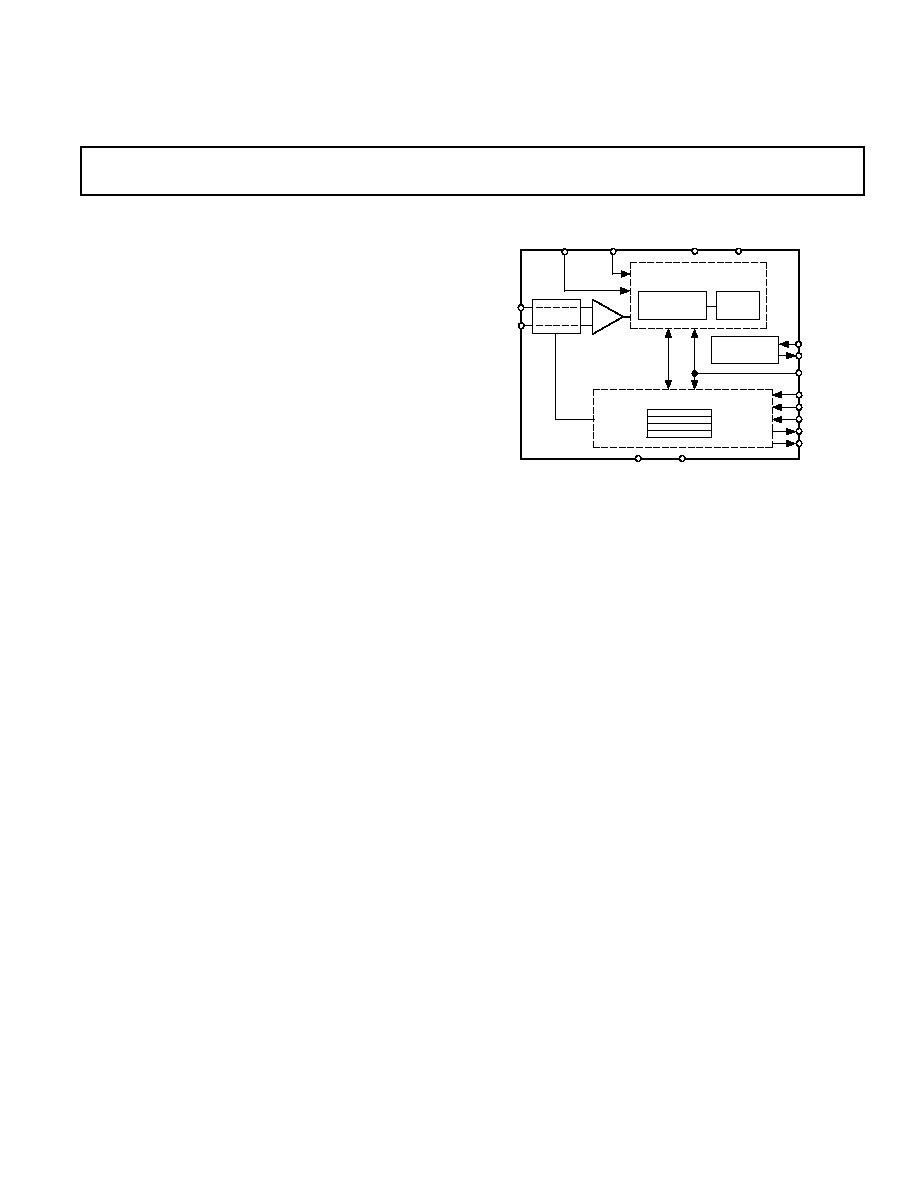
FUNCTIONAL BLOCK DIAGRAM
PGA
BUFFER
CHARGE BALANCING
A/D CONVERTER
SIGMA-DELTA
MODULATOR
DIGITAL
FILTER
REF IN() REF IN(+)
AV
DD
DV
DD
A = 1128
MCLK IN
MCLK OUT
RESET
AIN(+)
AIN()
SERIAL
INTERFACE
REGISTER BANK
SCLK
CS
DIN
DOUT
DRDY
CLOCK
GENERATION
AGND
DGND
AD7715
REV. C
Information furnished by Analog Devices is believed to be accurate and
reliable. However, no responsibility is assumed by Analog Devices for its
use, nor for any infringements of patents or other rights of third parties
which may result from its use. No license is granted by implication or
otherwise under any patent or patent rights of Analog Devices.
a
3 V/5 V, 450 A
16-Bit, Sigma-Delta ADC
AD7715*
FEATURES
Charge-Balancing ADC
16 Bits No Missing Codes
0.0015% Nonlinearity
Programmable Gain Front End
Gains of 1, 2, 32 and 128
Differential Input Capability
Three-Wire Serial Interface
SPITM, QSPITM, MICROWIRETM and DSP Compatible
Ability to Buffer the Analog Input
3 V (AD7715-3) or 5 V (AD7715-5) Operation
Low Supply Current: 450
A max @ 3 V Supplies
Low-Pass Filter with Programmable Output Update
16-Lead SOIC/DIP/TSSOP
CMOS construction ensures very low power dissipation, and the
power-down mode reduces the standby power consumption to
50
µ
W typ. The part is available in a 16-lead, 0.3 inch-wide,
plastic dual-in-line package (DIP) as well as a 16-lead 0.3 inch-
wide small outline (SOIC) package and a 16-lead TSSOP package.
PRODUCT HIGHLIGHTS
1. The AD7715 consumes less than 450
µ
A in total supply
current at 3 V supplies and 1 MHz master clock, making it
ideal for use in low-power systems. Standby current is less
than 10
µ
A.
2. The programmable gain input allows the AD7715 to accept
input signals directly from a strain gage or transducer remov-
ing a considerable amount of signal conditioning.
3. The AD7715 is ideal for microcontroller or DSP processor
applications with a three-wire serial interface reducing the
number of interconnect lines and reducing the number of
opto-couplers required in isolated systems. The part con-
tains on-chip registers which allow software control over
output update rate, input gain, signal polarity and calibration
modes.
4. The part features excellent static performance specifications
with 16-bits no missing codes,
±
0.0015% accuracy and low
rms noise (<550 nV). Endpoint errors and the effects of
temperature drift are eliminated by on-chip calibration op-
tions, which remove zero-scale and full-scale errors.
GENERAL DESCRIPTION
The AD7715 is a complete analog front end for low frequency
measurement applications. The part can accept low level input
signals directly from a transducer and outputs a serial digital
word. It employs a sigma-delta conversion technique to realize
up to 16 bits of no missing codes performance. The input signal
is applied to a proprietary programmable gain front end based
around an analog modulator. The modulator output is pro-
cessed by an on-chip digital filter. The first notch of this digital
filter can be programmed via the on-chip control register allow-
ing adjustment of the filter cutoff and output update rate.
The AD7715 features a differential analog input as well as a dif-
ferential reference input. It operates from a single supply (+3 V
or +5 V). It can handle unipolar input signal ranges of 0 mV to
+20 mV, 0 mV to +80 mV, 0 V to +1.25 V and 0 V to +2.5 V.
It can also handle bipolar input signal ranges of
±
20 mV,
±
80 mV,
±
1.25 V and
±
2.5 V. These bipolar ranges are referenced to
the negative input of the differential analog input. The AD7715
thus performs all signal conditioning and conversion for a single-
channel system.
The AD7715 is ideal for use in smart, microcontroller or DSP
based systems. It features a serial interface that can be config-
ured for three-wire operation. Gain settings, signal polarity and
update rate selection can be configured in software using the
input serial port. The part contains self-calibration and system
calibration options to eliminate gain and offset errors on the
part itself or in the system.
SPI and QSPI are trademarks of Motorola, Inc.
MICROWIRE is a trademark of National Semiconductor Corporation.
*Protected by U.S. Patent No: 5,134,401.
See page 30 for data sheet index.
One Technology Way, P.O. Box 9106, Norwood, MA 02062-9106, U.S.A.
Tel: 781/329-4700
World Wide Web Site: http://www.analog.com
Fax: 781/326-8703
© Analog Devices, Inc., 2000
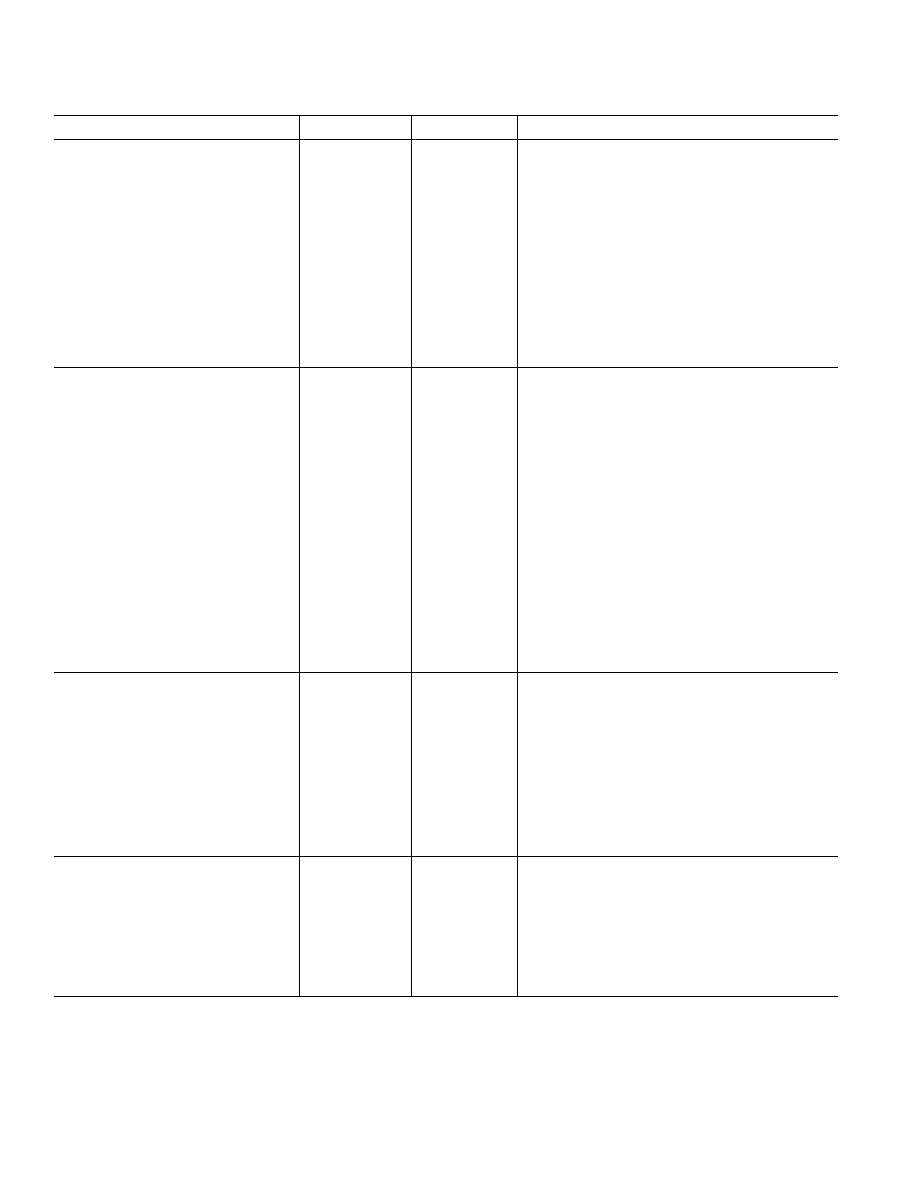
Parameter
A Version
1
Unit
Conditions/Comments
STATIC PERFORMANCE
No Missing Codes
16
Bits min
Guaranteed by Design. Filter Notch
60 Hz
Output Noise
See Tables V to VIII
Depends on Filter Cutoffs and Selected Gain
Integral Nonlinearity
±
0.0015
% of FSR max
Filter Notch
60 Hz
Unipolar Offset Error
See Note 2
Unipolar Offset Drift
3
0.5
µ
V/
°
C typ
Bipolar Zero Error
See Note 2
Bipolar Zero Drift
3
0.5
µ
V/
°
C typ
Positive Full-Scale Error
4
See Note 2
Full-Scale Drift
3, 5
0.5
µ
V/
°
C typ
Gain Error
6
See Note 2
Gain Drift
3, 7
0.5
ppm of FSR/
°
C typ
Bipolar Negative Full-Scale Error
2
±
0.0015
% of FSR max
Typically
±
0.0004%
Bipolar Negative Full-Scale Drift
3
1
µ
V/
°
C typ
For Gains of 1 and 2
0.6
µ
V/
°
C typ
For Gains of 32 and 128
ANALOG INPUTS/REFERENCE INPUTS
Specifications for AIN and REF IN Unless Noted
Input Common-Mode Rejection (CMR)
90
dB min
at DC. Typically 102 dB
Normal-Mode 50 Hz Rejection
8
98
dB min
For Filter Notches of 25 Hz, 50 Hz,
±
0.02
×
f
NOTCH
Normal-Mode 60 Hz Rejection
8
98
dB min
For Filter Notches of 20 Hz, 60 Hz,
±
0.02
×
f
NOTCH
Common-Mode 50 Hz Rejection
8
150
dB min
For Filter Notches of 25 Hz, 50 Hz,
±
0.02
×
f
NOTCH
Common-Mode 60 Hz Rejection
8
150
dB min
For Filter Notches of 20 Hz, 60 Hz,
±
0.02
×
f
NOTCH
Common-Mode Voltage Range
9
AGND to AV
DD
V min to V max
AIN for BUF Bit of Setup Register = 0 and REF IN
Absolute AIN/REF IN Voltage
8
AGND 30 mV
V min
AIN for BUF Bit of Setup Register = 0 and REF IN
AV
DD
+ 30 mV
V max
Absolute/Common-Mode AIN Voltage
9
AGND + 50 mV
V min
BUF Bit of Setup Register = 1
AV
DD
1.5 V
V max
AIN DC Input Current
8
1
nA max
AIN Sampling Capacitance
8
10
pF max
AIN Differential Voltage Range
10
0 to +V
REF
/GAIN
11
nom
Unipolar Input Range (B/U Bit of Setup Register = 1)
±
V
REF
/GAIN
nom
Bipolar Input Range (B/U Bit of Setup Register = 0)
AIN Input Sampling Rate, f
S
GAIN
×
f
CLK IN
/64
For Gains of 1 and 2
f
CLK IN
/8
For Gains of 32 and 128
REF IN(+) REF IN() Voltage
+2.5
V nom
±
1% for Specified Performance. Functional with
Lower V
REF
REF IN Input Sampling Rate, f
S
f
CLK IN
/64
LOGIC INPUTS
Input Current
±
10
µ
A max
All Inputs Except MCLK IN
V
INL
, Input Low Voltage
0.8
V max
DV
DD
= +5 V
V
INL
, Input Low Voltage
0.4
V max
DV
DD
= +3.3 V
V
INH
, Input High Voltage
2.4
V min
DV
DD
= +5 V
V
INH
, Input High Voltage
2.0
V min
MCLK IN Only
V
INL
, Input Low Voltage
0.8
V max
DV
DD
= +5 V
V
INL
, Input Low Voltage
0.4
V max
DV
DD
= +3.3 V
V
INH
, Input High Voltage
3.5
V min
DV
DD
= +5 V
V
INH
, Input High Voltage
2.5
V min
DV
DD
= +3.3 V
LOGIC OUTPUTS (Including MCLK OUT)
V
OL
, Output Low Voltage
0.4
V max
I
SINK
= 800
µ
A Except for MCLK OUT
12
. DV
DD
= +5 V
V
OL
, Output Low Voltage
0.4
V max
I
SINK
= 100
µ
A Except for MCLK OUT
12
. DV
DD
= +3.3 V
V
OH
, Output High Voltage
4.0
V min
I
SOURCE
= 200
µ
A Except for MCLK OUT
12
. DV
DD
= +5 V
V
OH
, Output High Voltage
DV
DD
0.6 V
V min
I
SOURCE
= 100
µ
A Except for MCLK OUT
12
. DV
DD
= +3.3 V
Floating State Leakage Current
±
10
µ
A max
Floating State Output Capacitance
13
9
pF typ
Data Output Coding
Binary
Unipolar Mode
Offset Binary
Bipolar Mode
AD7715-5SPECIFICATIONS
(AV
DD
= +5 V, DV
DD
= +3 V or +5 V, REF IN(+) = +2.5 V; REF IN() = AGND;
f
CLK IN
= 2.4576 MHz unless otherwise noted. All specifications T
MIN
to T
MAX
unless otherwise noted.)
REV. C
2
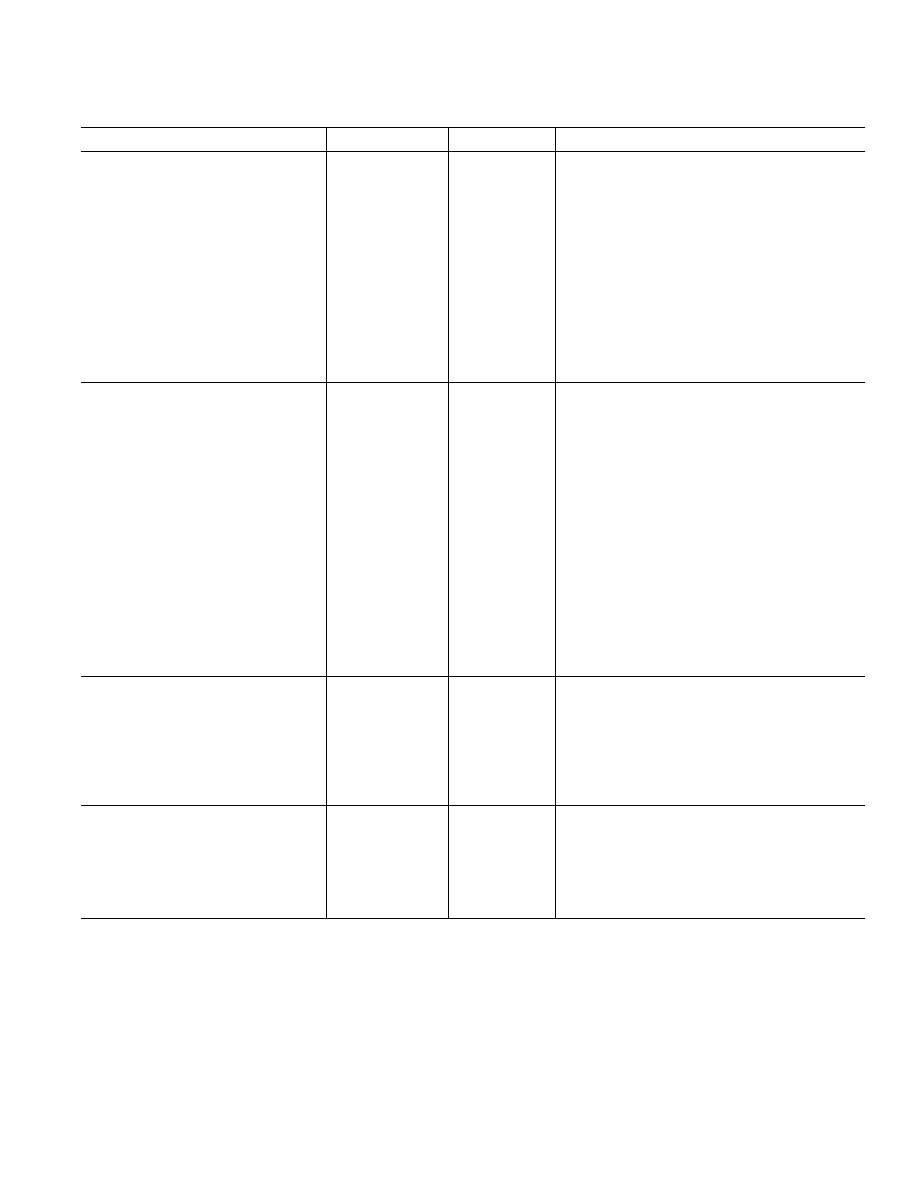
Parameter
A Version
1
Unit
Conditions/Comments
STATIC PERFORMANCE
No Missing Codes
16
Bits min
Guaranteed by Design. Filter Notch
60 Hz
Output Noise
See Tables IX to XII
Depends on Filter Cutoffs and Selected Gain
Integral Nonlinearity
±
0.0015
% of FSR max
Filter Notch
60 Hz
Unipolar Offset Error
See Note 2
Unipolar Offset Drift
3
0.2
µ
V/
°
C typ
Bipolar Zero Error
See Note 2
Bipolar Zero Drift
3
0.2
µ
V/
°
C typ
Positive Full-Scale Error
4
See Note 2
Full-Scale Drift
3, 5
0.2
µ
V/
°
C typ
Gain Error
6
See Note 2
Gain Drift
3, 7
0.2
ppm of FSR/
°
C typ
Bipolar Negative Full-Scale Error
2
±
0.003
% of FSR max
Typically
±
0.0004%
Bipolar Negative Full-Scale Drift
3
1
µ
V/
°
C typ
For Gains of 1 and 2
0.6
µ
V/
°
C typ
For Gains of 32 and 128
ANALOG INPUTS/REFERENCE INPUTS
Specifications for AIN and REF IN Unless Noted
Input Common-Mode Rejection (CMR)
90
dB min
at DC. Typically 102 dB
Normal-Mode 50 Hz Rejection
8
98
dB min
For Filter Notches of 25 Hz, 50 Hz,
±
0.02
×
f
NOTCH
Normal-Mode 60 Hz Rejection
8
98
dB min
For Filter Notches of 20 Hz, 60 Hz,
±
0.02
×
f
NOTCH
Common-Mode 50 Hz Rejection
8
150
dB min
For Filter Notches of 25 Hz, 50 Hz,
±
0.02
×
f
NOTCH
Common-Mode 60 Hz Rejection
8
150
dB min
For Filter Notches of 20 Hz, 60 Hz,
±
0.02
×
f
NOTCH
Common-Mode Voltage Range
9
AGND to AV
DD
V min to V max
AIN for BUF Bit of Setup Register = 0 and REF IN
Absolute AIN/REF IN Voltage
8
AGND 30 mV
V min
AIN for BUF Bit of Setup Register = 0 and REF IN
AV
DD
+ 30 mV
V max
Absolute/Common-Mode AIN Voltage
9
AGND + 50 mV
V min
BUF Bit of Setup Register = 1
AV
DD
1.5 V
V max
AIN DC Input Current
8
1
nA max
AIN Sampling Capacitance
8
10
pF max
AIN Differential Voltage Range
10
0 to +V
REF
/GAIN
11
nom
Unipolar Input Range (B/U Bit of Setup Register = 1)
±
V
REF
/GAIN
nom
Bipolar Input Range (B/U Bit of Setup Register = 0)
AIN Input Sampling Rate, f
S
GAIN
×
f
CLK IN
/64
For Gains of 1 and 2
f
CLK IN
/8
For Gains of 32 and 128
REF IN(+) REF IN() Voltage
+1.25
V nom
±
1% for Specified Performance. Functional with Lower V
REF
REF IN Input Sampling Rate, f
S
f
CLK IN
/64
LOGIC INPUTS
Input Current
±
10
µ
A max
All Inputs Except MCLK IN
V
INL
, Input Low Voltage
0.8
V max
V
INH
, Input High Voltage
2.0
V min
MCLK IN Only
V
INL
, Input Low Voltage
0.4
V max
V
INH
, Input High Voltage
2.5
V min
LOGIC OUTPUTS (Including MCLK OUT)
V
OL
, Output Low Voltage
0.4
V max
I
SINK
= 100
µ
A Except for MCLK OUT
12
V
OH
, Output High Voltage
DV
DD
0.6
V min
I
SOURCE
= 100
µ
A Except for MCLK OUT
12
Floating State Leakage Current
±
10
µ
A max
Floating State Output Capacitance
13
9
pF typ
Data Output Coding
Binary
Unipolar Mode
Offset Binary
Bipolar Mode
AD7715
AD7715-3SPECIFICATIONS
(AV
DD
= +3 V, DV
DD
= +3 V, REF IN (+) = +1.25 V;
REF IN() = AGND; f
CLK IN
= 2.4576 MHz unless otherwise noted. All specifications T
MIN
to T
MAX
unless otherwise noted.)
3
REV. C
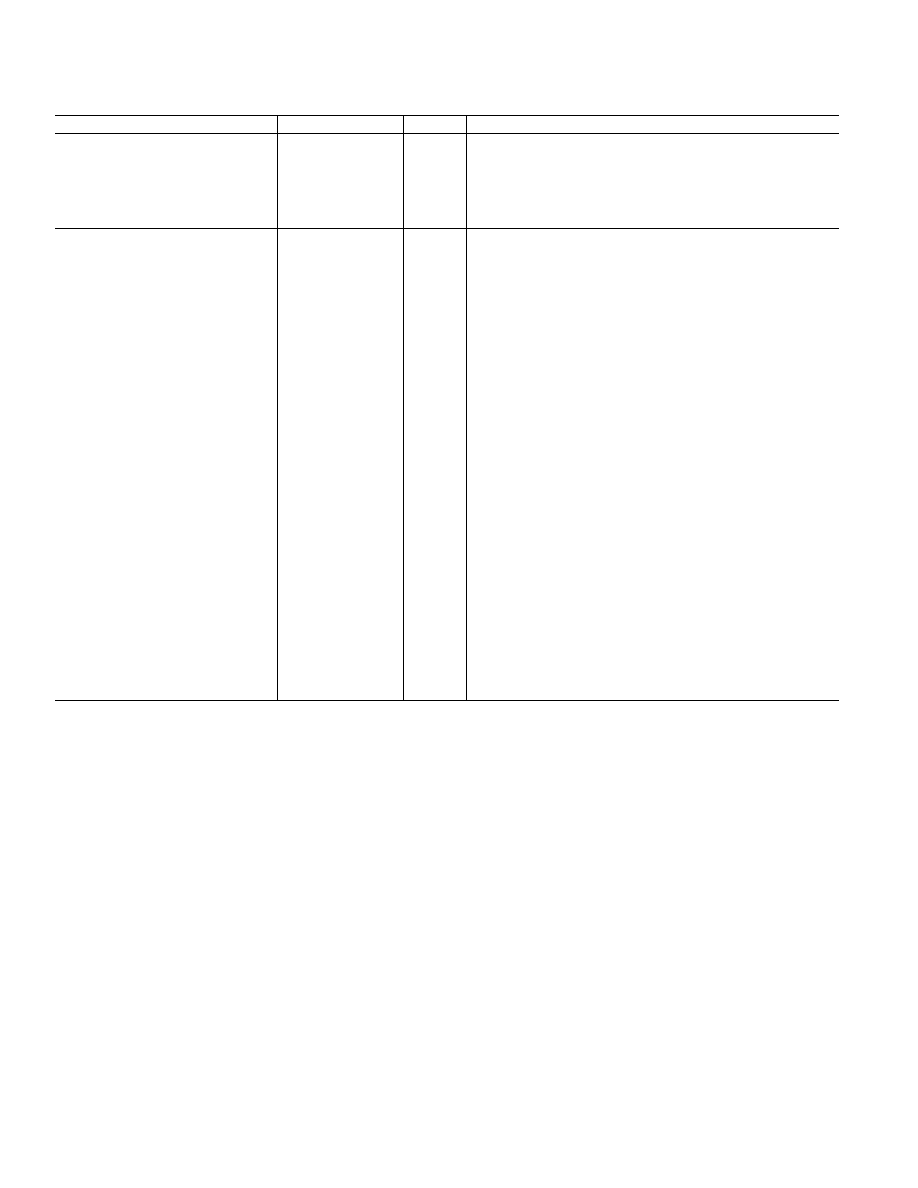
Pa
rameter
A Version
Unit
Conditions/Comments
SYSTEM CALIBRATION
Positive Full-Scale Calibration Limit
14
(1.05
×
V
REF
)/GAIN
V max
GAIN Is the Selected PGA Gain (1, 2, 32 or 128)
Negative Full-Scale Calibration Limit
14
(1.05
×
V
REF
)/GAIN
V max
GAIN Is the Selected PGA Gain (1, 2, 32 or 128)
Offset Calibration Limit
15
(1.05
×
V
REF
)/GAIN
V max
GAIN Is the Selected PGA Gain (1, 2, 32 or 128)
Input Span
15
0.8
×
V
REF
/GAIN
V min
GAIN Is the Selected PGA Gain (1, 2, 32 or 128)
(2.1
×
V
REF
)/GAIN
V max
GAIN Is the Selected PGA Gain (1, 2, 32 or 128)
POWER REQUIREMENTS
Power Supply Voltages
AV
DD
Voltage (AD7715-3)
+3 to +3.6
V
For Specified Performance
AV
DD
Voltage (AD7715-5)
+4.75 to +5.25
V
For Specified Performance
DV
DD
Voltage
+3 to +5.25
V
For Specified Performance
Power Supply Currents
AV
DD
Current
AV
DD
= 3.3 V or 5 V. Gain = 1 to 128 (f
CLK IN
= 1 MHz) or
Gain = 1 or 2 (f
CLK IN
= 2.4576 MHz)
0.27
mA max
Typically 0.2 mA. BUF Bit of Setup Register = 0
0.6
mA max
Typically 0.4 mA. BUF Bit of Setup Register = 1
AV
DD
= 3.3 V or 5 V. Gain = 32 or 128 (f
CLK IN
= 2.4576 MHz)
16
0.5
mA max
Typically 0.3 mA. BUF Bit of Setup Register = 0
1.1
mA max
Typically 0.8 mA. BUF Bit of Setup Register = 1
DV
DD
Current
17
Digital I/Ps = 0 V or DV
DD
. External MCLK IN
0.18
mA max
Typically 0.15 mA. DV
DD
= 3.3 V. f
CLK IN
= 1 MHz
0.4
mA max
Typically 0.3 mA. DV
DD
= 5 V. f
CLK IN
= 1 MHz
0.5
mA max
Typically 0.4 mA. DV
DD
= 3.3 V. f
CLK IN
= 2.4576 MHz
0.8
mA max
Typically 0.6 mA. DV
DD
= 5 V. f
CLK IN
= 2.4576 MHz
Power Supply Rejection
18
See Note 19
dB typ
Normal-Mode Power Dissipation
17
AV
DD
= DV
DD
= +3.3 V. Digital I/Ps = 0 V or DV
DD
. External MCLK IN
1.5
mW max
BUF Bit = 0. All Gains 1 MHz Clock
2.65
mW max
BUF Bit = 1. All Gains 1 MHz Clock
3.3
mW max
BUF Bit = 0. Gain = 32 or 128 @ f
CLK IN
= 2.4576 MHz
5.3
mW max
BUF Bit = 1. Gain = 32 or 128 @ f
CLK IN
= 2.4576 MHz
Normal-Mode Power Dissipation
17
AV
DD
= DV
DD
= +5 V. Digital I/Ps = 0 V or DV
DD
. External MCLK IN
3.25
mW max
BUF Bit = 0. All Gains 1 MHz Clock
5
mW max
BUF Bit = 1. All Gains 1 MHz Clock
6.5
mW max
BUF Bit = 0. Gain = 32 or 128 @ f
CLK IN
= 2.4576 MHz
9.5
mW max
BUF Bit = 1. Gain = 32 or 128 @ f
CLK IN
= 2.4576 MHz
Standby (Power-Down) Current
20
20
µ
A max
External MCLK IN = 0 V or DV
DD
. Typically 10
µ
A. V
DD
= +5 V
Standby (Power-Down) Current
20
10
µ
A max
External MCLK IN = 0 V or DV
DD
. Typically 5
µ
A. V
DD
= +3.3 V
NOTES
1
Temperature Range as follows: A Version, 40
°
C to +85
°
C.
2
A calibration is effectively a conversion so these errors will be of the order of the conversion noise shown in Tables V to XII. This applies after calibration at the
temperature of interest.
3
Recalibration at any temperature will remove these drift errors.
4
Positive Full-Scale Error includes Zero-Scale Errors (Unipolar Offset Error or Bipolar Zero Error) and applies to both unipolar and bipolar input ranges.
5
Full-Scale Drift includes Zero-Scale Drift (Unipolar Offset Drift or Bipolar Zero Drift) and applies to both unipolar and bipolar input ranges.
6
Gain Error does not include Zero-Scale Errors. It is calculated as Full-Scale ErrorUnipolar Offset Error for unipolar ranges and Full-Scale ErrorBipolar Zero Error
for bipolar ranges.
7
Gain Error Drift does not include Unipolar Offset Drift/Bipolar Zero Drift. It is effectively the drift of the part if zero scale calibrations only were performed.
8
These numbers are guaranteed by design and/or characterization.
9
This common-mode voltage range is allowed provided that the input voltage on AIN(+) or AIN() does not go more positive than A V
DD
+ 30 mV or go more nega-
tive than AGND 30 mV.
10
The analog input voltage range on AIN(+) is given here with respect to the voltage on AIN(). The absolute voltage on the analog inputs should not go more posi-
tive than AV
DD
+ 30 mV or go more negative than AGND 30 mV.
11
V
REF
= REF IN(+) REF IN().
12
These logic output levels apply to the MCLK OUT only when it is loaded with one CMOS load.
13
Sample tested at +25
°
C to ensure compliance.
14
After calibration, if the analog input exceeds positive full scale, the converter will output all 1s. If the analog input is less than negative full scale, then the device will
output all 0s.
15
These calibration and span limits apply provided the absolute voltage on the analog inputs does not exceed AV
DD
+ 30 mV or go more negative than AGND
30 mV. The offset calibration limit applies to both the unipolar zero point and the bipolar zero point.
16
Assumes CLK Bit of Setup Register is set to correct status corresponding to the master clock frequency.
17
When using a crystal or ceramic resonator across the MCLK pins as the clock source for the device, the DV
DD
current and power dissipation will vary depending on
the crystal or resonator type (see Clocking and Oscillator Circuit section).
18
Measured at dc and applies in the selected passband. PSRR at 50 Hz will exceed 120 dB with filter notches of 25 Hz or 50 Hz. PSRR at 60 Hz will exceed 120 dB
with filter notches of 20 Hz or 60 Hz.
19
PSRR depends on gain. Gain of 1: 85 dB typ; Gain of 2: 90 dB typ; Gains of 32 and 128: 95 dB typ.
20
If the external master clock continues to run in standby mode, the standby current increases to 50
µ
A typical. When using a crystal or ceramic resonator across the
MCLK pins as the clock source for the device, the internal oscillator continues to run in standby mode and the power dissipation depends on the crystal or
resonator type (see Standby Mode section).
Specifications subject to change without notice.
AD7715SPECIFICATIONS
A (AV
DD
= +3 V to +5 V, DV
DD
= +3 V to +5 V, REF IN(+) = +1.25 V (AD7715-3) or +2.5 V
(AD7715-5); REF IN() = AGND; MCLK IN = 1 MHz to 2.4576 MHz unless otherwise noted. All specifications T
MIN
to T
MAX
unless otherwise noted.)
4
REV. C
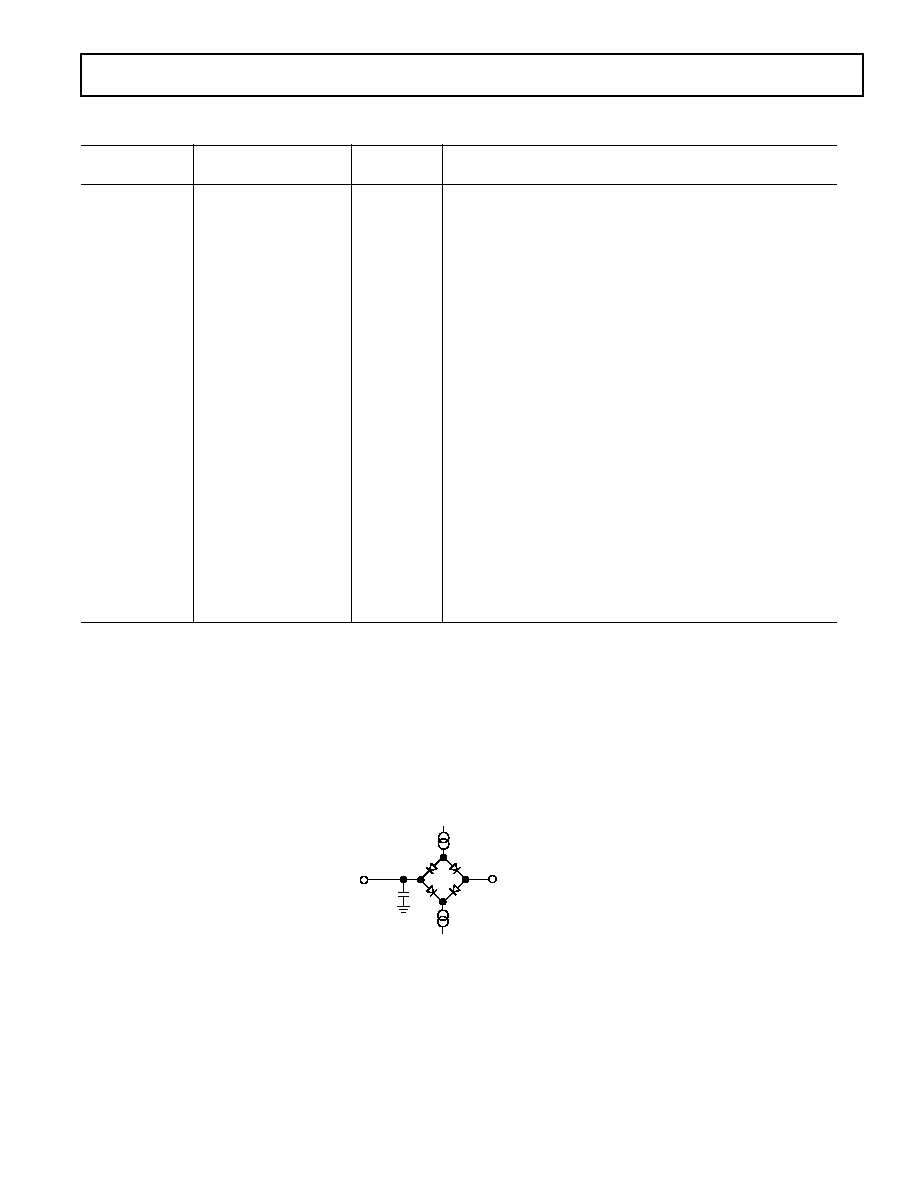
AD7715
5
REV. C
TIMING CHARACTERISTICS
1, 2
Limit at T
MIN
, T
MAX
Parameter
(A Version)
Unit
Conditions/Comments
f
CLKIN
3, 4
400
kHz min
Master Clock Frequency: Crystal Oscillator or Externally Supplied
2.5
MHz max
for Specified Performance
t
CLK IN LO
0.4
×
t
CLK IN
ns min
Master Clock Input Low Time. t
CLK IN
= 1/f
CLK IN
t
CLK IN HI
0.4
×
t
CLK IN
ns min
Master Clock Input High Time
t
1
500
×
t
CLK IN
ns nom
DRDY High Time
t
2
100
ns min
RESET Pulsewidth
Read Operation
t
3
0
ns min
DRDY to CS Setup Time
t
4
120
ns min
CS Falling Edge to SCLK Rising Edge Setup Time
t
5
5
0
ns min
SCLK Falling Edge to Data Valid Delay
80
ns max
DV
DD
= +5 V
100
ns max
DV
DD
= +3.3 V
t
6
100
ns min
SCLK High Pulsewidth
t
7
100
ns min
SCLK Low Pulsewidth
t
8
0
ns min
CS Rising Edge to SCLK Rising Edge Hold Time
t
9
6
10
ns min
Bus Relinquish Time after SCLK Rising Edge
60
ns max
DV
DD
= +5 V
100
ns max
DV
DD
= +3.3 V
t
10
100
ns max
SCLK Falling Edge to
DRDY High
7
Write Operation
t
11
120
ns min
CS Falling Edge to SCLK Rising Edge Setup Time
t
12
30
ns min
Data Valid to SCLK Rising Edge Setup Time
t
13
20
ns min
Data Valid to SCLK Rising Edge Hold Time
t
14
100
ns min
SCLK High Pulsewidth
t
15
100
ns min
SCLK Low Pulsewidth
t
16
0
ns min
CS Rising Edge to SCLK Rising Edge Hold Time
NOTES
1
Sample tested at +25
°
C to ensure compliance. All input signals are specified with tr = tf = 5 ns (10% to 90% of D V
DD
) and timed from a voltage level of 1.6 V.
2
See Figures 6 and 7.
3
CLKIN Duty Cycle range is 45% to 55%. CLKIN must be supplied whenever the AD7715 is not in Standby mode. If no clock is present in this case, the
device can draw higher current than specified and possibly become uncalibrated.
4
The AD7715 is production tested with f
CLKIN
at 2.4576 MHz (1 MHz for some I
DD
tests). It is guaranteed by characterization to operate at 400 kHz.
5
These numbers are measured with the load circuit of Figure 1 and defined as the time required for the output to cross the V
OL
or V
OH
limits.
6
These numbers are derived from the measured time taken by the data output to change 0.5 V when loaded with the circuit of Figure 1. The measured number is
then extrapolated back to remove effects of charging or discharging the 50 pF capacitor. This means that the times quoted in the timing characteristics are the
true bus relinquish times of the part and as such are independent of external bus loading capacitances.
7
DRDY returns high after the first read from the device after an output update. The same data can be read again, if required, while DRDY is high although care
should be taken that subsequent reads do not occur close to the next output update.
Specifications subject to change without notice.
TO
OUTPUT
PIN
+1.6V
I
SINK
(800 A AT DV
DD
= 5V
100 A AT DV
DD
= 3.3V)
50pF
I
SOURCE
(200 A AT DV
DD
= 5V
100 A AT DV
DD
= 3.3V)
Figure 1. Load Circuit for Access Time and Bus Relinquish Time
(DV
DD
= +3 V to +5.25 V; AV
DD
= +3 V to +5.25 V; AGND = DGND = 0 V; f
CLKIN
= 2.4576 MHz;
Input Logic 0 = 0 V, Logic 1 = DV
DD
, unless otherwise noted)
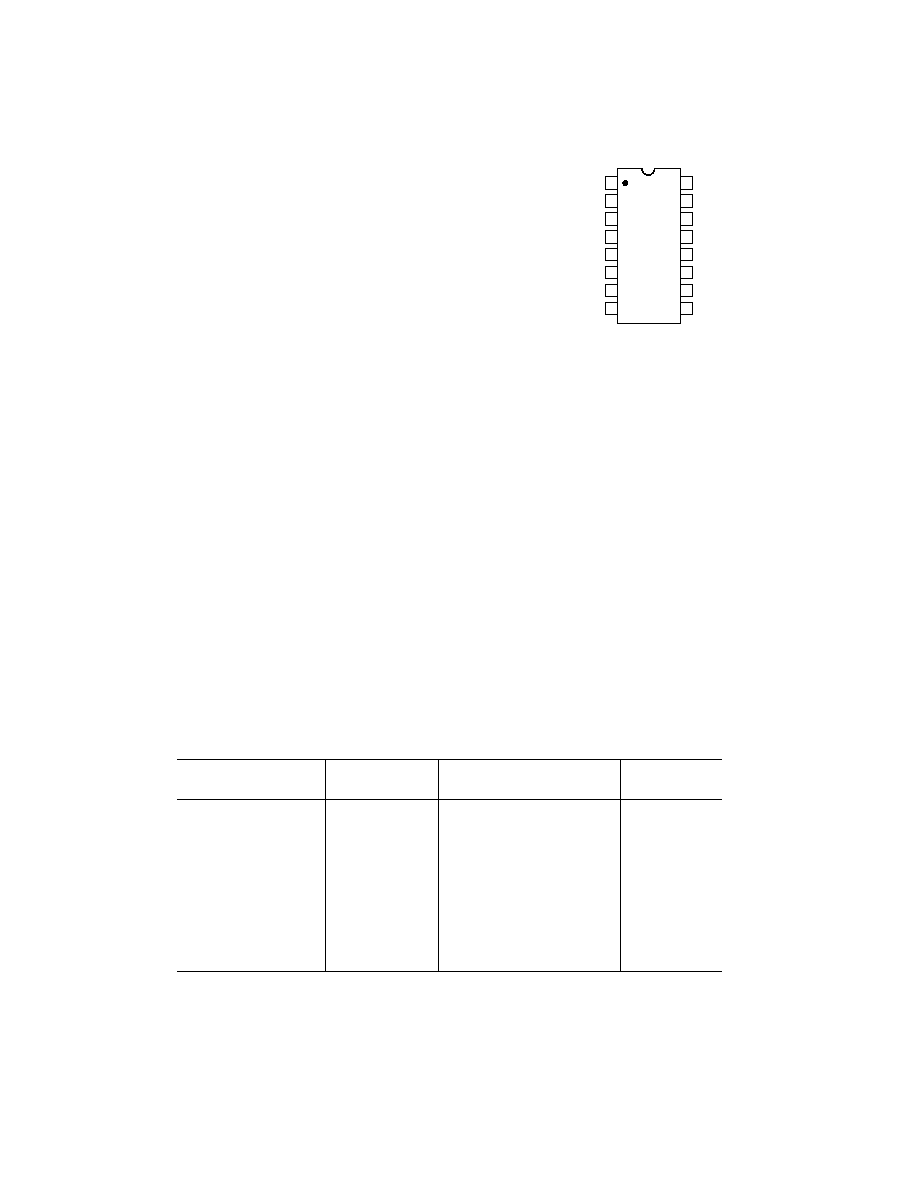
REV. C
AD7715
6
ORDERING GUIDE
AV
DD
Temperature
Package
Model
Supply
Range
Options*
AD7715AN-5
5 V
40
°
C to +85
°
C
N-16
AD7715AR-5
5 V
40
°
C to +85
°
C
R-16
AD7715ARU-5
5 V
40
°
C to +85
°
C
RU-16
AD7715AN-3
3 V
40
°
C to +85
°
C
N-16
AD7715AR-3
3 V
40
°
C to +85
°
C
R-16
AD7715ARU-3
3 V
40
°
C to +85
°
C
RU-16
AD7715AChips-5
5 V
40
°
C to +85
°
C
Die
AD7715AChips-3
3 V
40
°
C to +85
°
C
Die
EVAL-AD7715-5EB
5 V
Evaluation Board
EVAL-AD7715-3EB
3 V
Evaluation Board
*N = Plastic DIP; R = SOIC RU = TSSOP.
ABSOLUTE MAXIMUM RATINGS*
(T
A
= +25
°
C unless otherwise noted)
AV
DD
to AGND . . . . . . . . . . . . . . . . . . . . . . . . 0.3 V to +7 V
AV
DD
to DGND . . . . . . . . . . . . . . . . . . . . . . . . 0.3 V to +7 V
AV
DD
to DV
DD
. . . . . . . . . . . . . . . . . . . . . . . . . 0.3 V to +7 V
DV
DD
to AGND . . . . . . . . . . . . . . . . . . . . . . . . 0.3 V to +7 V
DV
DD
to DGND . . . . . . . . . . . . . . . . . . . . . . . . 0.3 V to +7 V
DGND to AGND . . . . . . . . . . . . . . . . . . . . . . . 0.3 V to +7 V
Analog Input Voltage to AGND . . . . . 0.3 V to AV
DD
+ 0.3 V
Reference Input Voltage to AGND . . . 0.3 V to AV
DD
+ 0.3 V
Digital Input Voltage to DGND . . . . . 0.3 V to DV
DD
+ 0.3 V
Digital Output Voltage to DGND . . . . 0.3 V to DV
DD
+ 0.3 V
Operating Temperature Range
Commercial (A Version) . . . . . . . . . . . . . . . 40
°
C to +85
°
C
Storage Temperature Range . . . . . . . . . . . . . 65
°
C to +150
°
C
Junction Temperature . . . . . . . . . . . . . . . . . . . . . . . . . +150
°
C
Plastic DIP Package, Power Dissipation . . . . . . . . . . . 450 mW
JA
Thermal Impedance . . . . . . . . . . . . . . . . . . . . . 105
°
C/W
Lead Temperature, (Soldering, 10 sec) . . . . . . . . . . +260
°
C
SOIC Package, Power Dissipation . . . . . . . . . . . . . . . . 450 mW
JA
Thermal Impedance . . . . . . . . . . . . . . . . . . . . . . 75
°
C/W
Lead Temperature, Soldering
Vapor Phase (60 sec) . . . . . . . . . . . . . . . . . . . . . . +215
°
C
Infrared (15 sec) . . . . . . . . . . . . . . . . . . . . . . . . . . +220
°
C
TSSOP Package, Power Dissipation . . . . . . . . . . . . . . 450 mW
JA
Thermal Impedance . . . . . . . . . . . . . . . . . . . . . 128
°
C/W
Lead Temperature, Soldering
Vapor Phase (60 sec) . . . . . . . . . . . . . . . . . . . . . . +215
°
C
Infrared (15 sec) . . . . . . . . . . . . . . . . . . . . . . . . . . +220
°
C
Power Dissipation (Any Package) to +75
°
C . . . . . . . . 450 mW
ESD Rating . . . . . . . . . . . . . . . . . . . . . . . . . . . . . . . . . >4000 V
*Stresses above those listed under Absolute Maximum Ratings may cause perma-
nent damage to the device. This is a stress rating only; functional operation of the
device at these or any other conditions above those indicated in the operational
section of this specification is not implied. Exposure to absolute maximum rating
conditions for extended periods may affect device reliability.
PIN CONFIGURATION
DIP, SOIC and TSSOP
14
13
12
11
16
15
10
9
8
1
2
3
4
7
6
5
TOP VIEW
(Not to Scale)
AD7715
SCLK
DOUT
DIN
DV
DD
DGND
MCLK IN
MCLK OUT
CS
REF IN(+)
AGND
DRDY
RESET
AV
DD
AIN(+)
AIN()
REF IN()
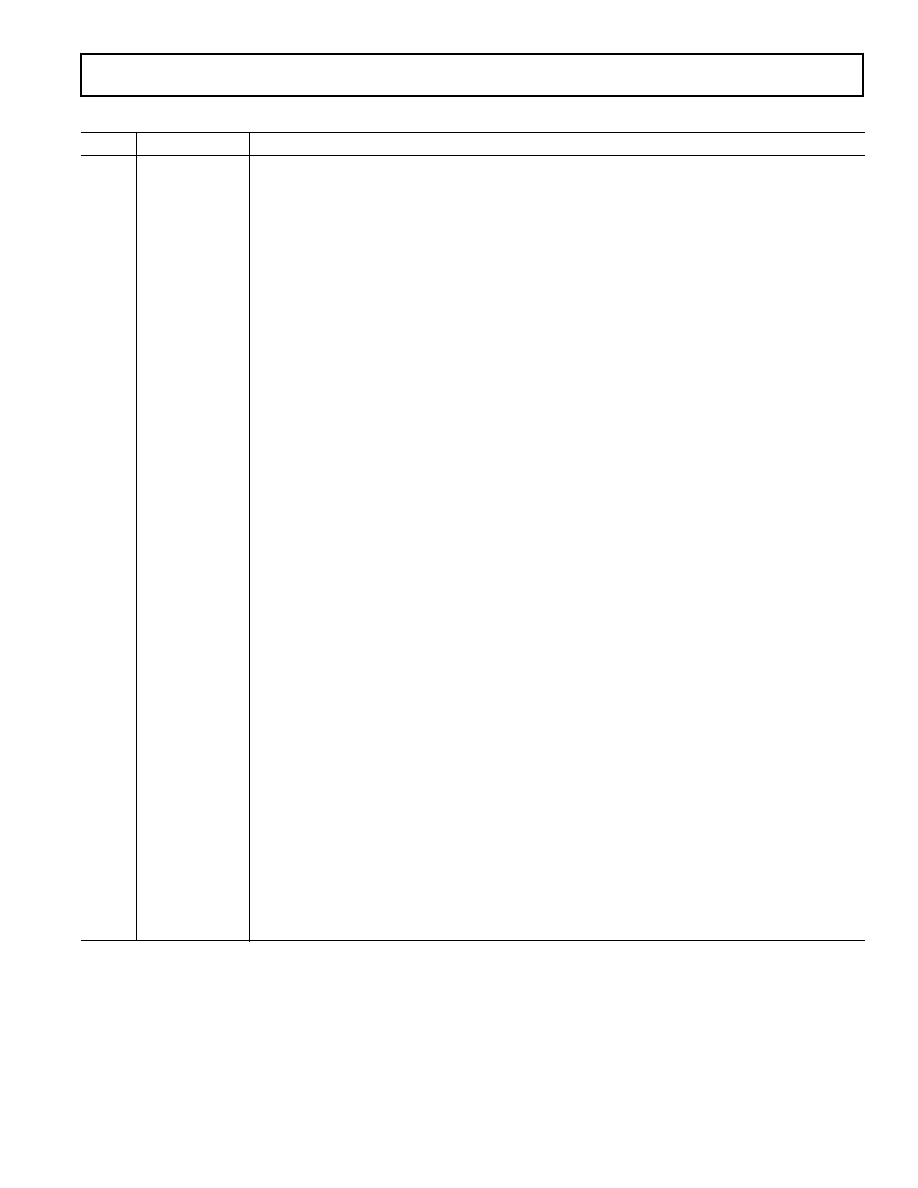
AD7715
7
REV. C
PIN FUNCTION DESCRIPTION
Pin No.
Mnemonic
Function
1
SCLK
Serial Clock. Logic Input. An external serial clock is applied to this input to access serial data from
the AD7715. This serial clock can be a continuous clock with all data transmitted in a continuous
train of pulses. Alternatively, it can be a noncontinuous clock with the information being transmit-
ted to the AD7715 in smaller batches of data.
2
MCLK IN
Master Clock signal for the device. This can be provided in the form of a crystal/resonator or exter-
nal clock. A crystal/resonator can be tied across the MCLK IN and MCLK OUT pins. Alterna-
tively, the MCLK IN pin can be driven with a CMOS-compatible clock and MCLK OUT left
unconnected. The part is specified with clock input frequencies of both 1 MHz and 2.4576 MHz.
3
MCLK OUT
When the master clock for the device is a crystal/resonator, the crystal/resonator is connected be-
tween MCLK IN and MCLK OUT. If an external clock is applied to MCLK IN, MCLK OUT
provides an inverted clock signal. This clock can be used to provide a clock source for external
circuitry.
4
CS
Chip Select. Active low Logic Input used to select the AD7715. With this input hardwired low, the
AD7715 can operate in its three-wire interface mode with SCLK, DIN and DOUT used to inter-
face to the device.
CS can be used to select the device in systems with more than one device on the
serial bus or as a frame synchronization signal in communicating with the AD7715.
5
RESET
Logic Input. Active low input which resets the control logic, interface logic, calibration coefficients,
digital filter and analog modulator of the part to power-on status.
6
AV
DD
Analog Positive Supply Voltage, +3.3 V nominal (AD7715-3) or +5 V nominal (AD7715-5).
7
AIN(+)
Analog Input. Positive input of the programmable gain differential analog input to the AD7715.
8
AIN()
Analog Input. Negative input of the programmable gain differential analog input to the AD7715.
9
REF IN(+)
Reference Input. Positive input of the differential reference input to the AD7715. The reference
input is differential with the provision that REF IN(+) must be greater than REF IN().
REF IN(+) can lie anywhere between AV
DD
and AGND.
10
REF IN()
Reference Input. Negative input of the differential reference input to the AD7715. The REF IN()
can lie anywhere between AV
DD
and AGND provided REF IN(+) is greater than REF IN().
11
AGND
Ground reference point for analog circuitry. For correct operation of the AD7715, no voltage on
any of the other pins should go more than 30 mV negative with respect to AGND.
12
DRDY
Logic Output. A logic low on this output indicates that a new output word is available from the
AD7715 data register. The
DRDY pin will return high upon completion of a read operation of a full
output word. If no data read has taken place between output updates, the
DRDY line will return
high for 500
×
t
CLK IN
cycles prior to the next output update. While
DRDY is high, a read operation
should not be attempted or in progress to avoid reading from the data register as it is being updated.
The
DRDY line will return low again when the update has taken place. DRDY is also used to indi-
cate when the AD7715 has completed its on-chip calibration sequence.
13
DOUT
Serial Data Output with serial data being read from the output shift register on the part. This output
shift register can contain information from the setup register, communications register or data regis-
ter depending on the register selection bits of the Communications Register.
14
DIN
Serial Data Input with serial data being written to the input shift register on the part. Data from this
input shift register is transferred to the setup register or communications register depending on the
register selection bits of the Communications Register.
15
DV
DD
Digital Supply Voltage, +3.3 V or +5 V nominal.
16
DGND
Ground reference point for digital circuitry.

REV. C
AD7715
8
TERMINOLOGY
Integral Nonlinearity
This is the maximum deviation of any code from a straight line
passing through the endpoints of the transfer function. The end-
points of the transfer function are Zero-Scale (not to be confused
with Bipolar Zero), a point 0.5 LSB below the first code transition
(000 . . . 000 to 000 . . . 001) and Full-Scale, a point 0.5 LSB
above the last code transition (111 . . . 110 to 111 . . . 111). The
error is expressed as a percentage of full scale.
Positive Full-Scale Error
Positive Full-Scale Error is the deviation of the last code transi-
tion (111 . . . 110 to 111 . . . 111) from the ideal AIN(+) voltage
(AIN() + V
REF
/GAIN 3/2 LSBs). It applies to both unipolar
and bipolar analog input ranges.
Unipolar Offset Error
Unipolar Offset Error is the deviation of the first code transition
from the ideal AIN(+) voltage (AIN() + 0.5 LSB) when oper-
ating in the unipolar mode.
Bipolar Zero Error
This is the deviation of the midscale transition (0111 . . . 111
to 1000 . . . 000) from the ideal AIN(+) voltage (AIN()
0.5 LSB) when operating in the bipolar mode.
Gain Error
This is a measure of the span error of the ADC. It includes full-
scale errors but not zero-scale errors. For unipolar input ranges
it is defined as (full scale errorunipolar offset error) while for
bipolar input ranges it is defined as (full-scale errorbipolar zero
error).
Bipolar Negative Full-Scale Error
This is the deviation of the first code transition from the ideal
AIN(+) voltage (AIN() V
REF
/GAIN + 0.5 LSB), when oper-
ating in the bipolar mode.
Positive Full-Scale Overrange
Positive full-scale overrange is the amount of overhead available
to handle input voltages on AIN(+) input greater than AIN() +
V
REF
/GAIN (for example, noise peaks or excess voltages due to
system gain errors in system calibration routines) without intro-
ducing errors due to overloading the analog modulator or over-
flowing the digital filter.
Negative Full-Scale Overrange
This is the amount of overhead available to handle voltages on
AIN(+) below AIN() V
REF
/GAIN without overloading the
analog modulator or overflowing the digital filter. Note that the
analog input will accept negative voltage peaks even in the uni-
polar mode provided that AIN(+) is greater than AIN() and
greater than AGND 30 mV.
Offset Calibration Range
In the system calibration modes, the AD7715 calibrates its
offset with respect to the analog input. The offset calibration
range specification defines the range of voltages that the
AD7715 can accept and still calibrate offset accurately.
Full-Scale Calibration Range
This is the range of voltages that the AD7715 can accept in the
system calibration mode and still calibrate full scale correctly.
Input Span
In system calibration schemes, two voltages applied in sequence
to the AD7715's analog input define the analog input range.
The input span specification defines the minimum and maxi-
mum input voltages from zero to full scale that the AD7715 can
accept and still calibrate gain accurately.
ON-CHIP REGISTERS
The part contains four on-chip registers which can be accessed by via the serial port on the part. The first of these is a Communica-
tions Register that decides whether the next operation is a read or write operation and also decides which register the read or write
operation accesses. All communications to the part must start with a write operation to the Communications Register. After power-
on or RESET, the device expects a write to its Communications Register. The data written to this register determines whether the
next operation to the part is a write or a read operation and also determines to which register this read or write operation occurs.
Therefore, write access to any of the other registers on the part starts with a write operation to the Communications Register fol-
lowed by a write to the selected register. A read operation from any register on the part (including the Communications Register itself
and the output data register) starts with a write operation to the Communications Register followed by a read operation from the
selected register. The Communication Register also controls the standby mode and the operating gain of the part. The
DRDY status
is also available by reading from the Communications Register. The second register is a Setup Register that determines calibration
modes, filter selection and bipolar/unipolar operation. The third register is the Data Register from which the output data from the
part is accessed. The final register is a Test Register that is accessed when testing the device. It is advised that the user does not
attempt to access or change the contents of the test register as it may lead to unspecified operation of the device. The registers are
discussed in more detail in the following sections.
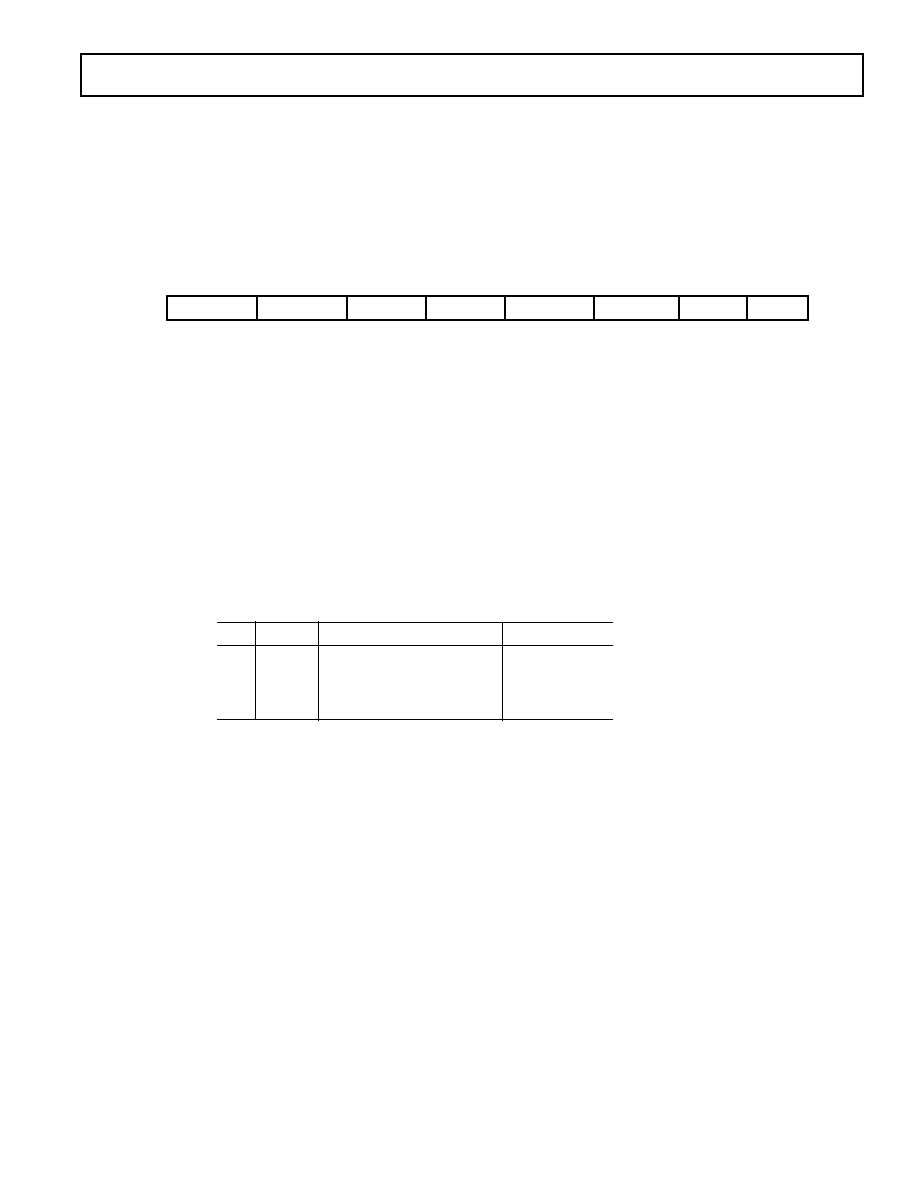
AD7715
9
REV. C
Communications Register (RS1, RS0 = 0, 0)
The Communications Register is an eight-bit register from which data can either be read or to which data can be written. All com-
munications to the part must start with a write operation to the Communications Register. The data written to the Communications
Register determines whether the next operation is a read or write operation and to which register this operation takes place. Once the
subsequent read or write operation to the selected register is complete, the interface returns to where it expects a write operation to
the Communications Register. This is the default state of the interface, and on power-up or after a
RESET, the AD7715 is in this
default state waiting for a write operation to the Communications Register. In situations where the interface sequence is lost, if a
write operation to the device of sufficient duration (containing at least 32 serial clock cycles) takes place with DIN high, the AD7715
returns to this default state. Table I outlines the bit designations for the Communications Register.
Table I. Communications Register
0/
DRDY
ZERO
RS1
RS0
R/
W
STBY
G1
G0
0/
DRDY
For a write operation, a 0 must be written to this bit so that the write operation to the Communications Reg-
ister actually takes place. If a 1 is written to this bit, the part will not clock on to subsequent bits in the regis-
ter. It will stay at this bit location until a 0 is written to this bit. Once a 0 is written to this bit, the next 7 bits
will be loaded to the Communications Register. For a read operation, this bit provides the status of the
DRDY flag from the part. The status of this bit is the same as the DRDY output pin.
ZERO
For a write operation, a 0 must be written to this bit for correct operation of the part. Failure to do this will
result in unspecified operation of the device. For a read operation, a 0 will be read back from this bit location.
RS1 RS0
Register Selection Bits. These bits select to which one of four on-chip registers the next read or write opera-
tion takes place as shown in Table II along with the register size. When the read or write to the selected regis-
ter is complete, the part returns to where it is waiting for a write operation to the Communications Register.
It does not remain in a state where it will continue to access the selected register.
R/
W
Read/Write Select. This bit selects whether the next operation is a read or write operation to the selected
register. A 0 indicates a write cycle as the next operation to the appropriate register, while a 1 indicates a read
operation from the appropriate register.
Table II. Register Selection
RS1
RS0
Register
Register Size
0
0
Communications Register
8 Bits
0
1
Setup Register
8 Bits
1
0
Test Register
8 Bits
1
1
Data Register
16 Bits
STBY
Standby. Writing a 1 to this bit puts the part in its standby or power-down mode. In this mode, the part
consumes only 10
µ
A of power supply current. The part retains its calibration and control word information
when in STANDBY. Writing a 0 to this bit places the part in its normal operating mode. The default value
for this bit after power-on or RESET is 0.
G2
G1
Gain Setting
0
0
1
0
1
2
1
0
32
1
1
128
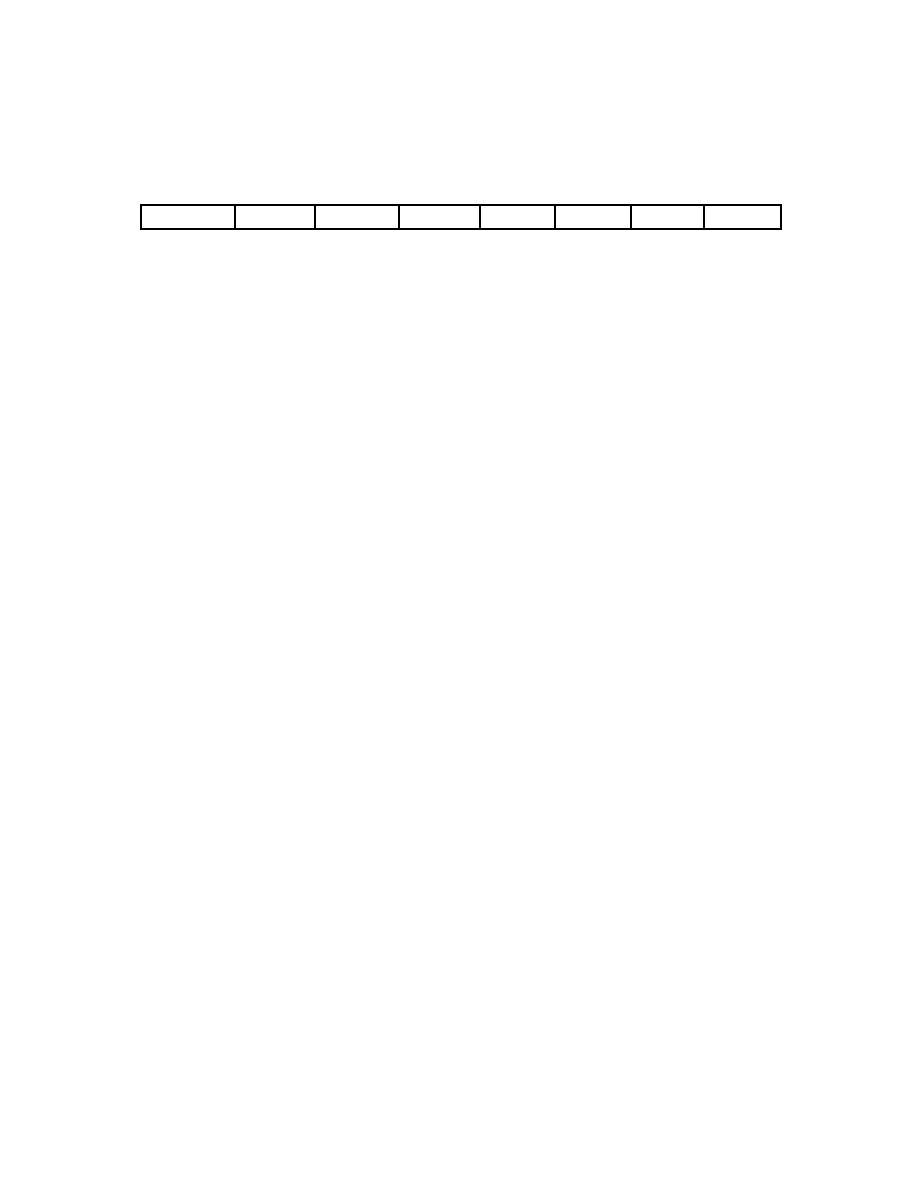
REV. C
AD7715
10
Setup Register (RS1, RS0 = 0, 1); Power On/Reset Status: 28 Hex
The Setup Register is an eight-bit register from which data can either be read or to which data can be written. This register controls
the setup which the device is to operate in such as the calibration mode, output rate, unipolar/bipolar operation etc. Table III out-
lines the bit designations for the Setup Register.
Table III. Setup Register
MD1 MD0 CLK FS1 FS0
B/U BUF FSYNC
MD1
MD0
Operating Mode
0
0
Normal Mode; this is the normal mode of operation of the device whereby the device is performing normal
conversions. This is the default condition of these bits after Power-On or RESET.
0
1
Self-Calibration; this activates self-calibration on the part. This is a one step calibration sequence and when
complete the part returns to Normal Mode with MD1 and MD0 returning to 0, 0. The
DRDY output or bit
goes high when calibration is initiated and returns low when this self-calibration is complete and a new valid
word is available in the data register. The zero-scale calibration is performed at the selected gain on internally
shorted (zeroed) inputs and the full-scale calibration is performed at the selected gain on an internally
generated V
REF
/Selected Gain.
1
0
Zero-Scale System Calibration; this activates zero-scale system calibration on the part. Calibration is per-
formed at the selected gain on the input voltage provided at the analog input during this calibration sequence.
This input voltage should remain stable for the duration of the calibration. The
DRDY output or bit goes
high when calibration is initiated and returns low when this zero-scale calibration is complete and a new valid
word is available in the data register. At the end of the calibration, the part returns to Normal Mode with
MD1 and MD0 returning to 0, 0.
1
1
Full-Scale System Calibration; this activates full-scale system calibration on the part. Calibration is per-
formed at the selected gain on the input voltage provided at the analog input during this calibration sequence.
This input voltage should remain stable for the duration of the calibration. Once again, the
DRDY output or
bit goes high when calibration is initiated and returns low when this full-scale calibration is complete and a
new valid word is available in the data register. At the end of the calibration, the part returns to Normal
Mode with MD1 and MD0 returning to 0, 0.
CLK
Clock Bit. This bit should be set in accordance with the operating frequency of the AD7715. If the device has
a master clock frequency of 2.4576 MHz, then this bit should be set to a 1. If the device has a master clock
frequency of 1 MHz, then this bit should be set to a 0. This bit sets up the correct scaling currents for a given
master clock and also chooses (along with FS1 and FS0) the output update rate for the device. If this bit is
not set correctly for the master clock frequency of the device, then the device may not operate to specifica-
tion. The default value for this bit after power-on or RESET is 1.
FS1, FS0
Filter Selection Bits. Along with the CLK bit, FS1 and FS0 determine the output update rate, filter first
notch and 3 dB frequency as outlined in Table IV. The on-chip digital filter provides a Sinc
3
(or (Sinx/x)
3
)
filter response. In association with the gain selection, it also determines the output noise (and hence the
resolution) of the device. Changing the filter notch frequency, as well as the selected gain, impacts resolution.
Tables V through XII show the effect of the filter notch frequency and gain on the output noise and effective
resolution of the part. The output data rate (or effective conversion time) for the device is equal to the fre-
quency selected for the first notch of the filter. For example, if the first notch of the filter is selected at 50 Hz
then a new word is available at a 50 Hz rate or every 20 ms. If the first notch is at 500 Hz, a new word is
available every 2 ms. The default value for these bits is 1, 0.
The settling-time of the filter to a full-scale step input change is worst case 4
×
1/(output data rate). For
example, with the first filter notch at 50 Hz, the settling time of the filter to a full-scale step input change is
80 ms max. If the first notch is at 500 Hz, the settling time of the filter to a full-scale input step is 8 ms max.
This settling-time can be reduced to 3
×
1/(output data rate) by synchronizing the step input change to a
reset of the digital filter. In other words, if the step input takes place with the FSYNC bit high, the settling-
time time will be 3
×
1/(output data rate) from when FSYNC returns low.
The 3 dB frequency is determined by the programmed first notch frequency according to the relationship:
filter 3 dB frequency = 0.262
×
filter first notch frequency.
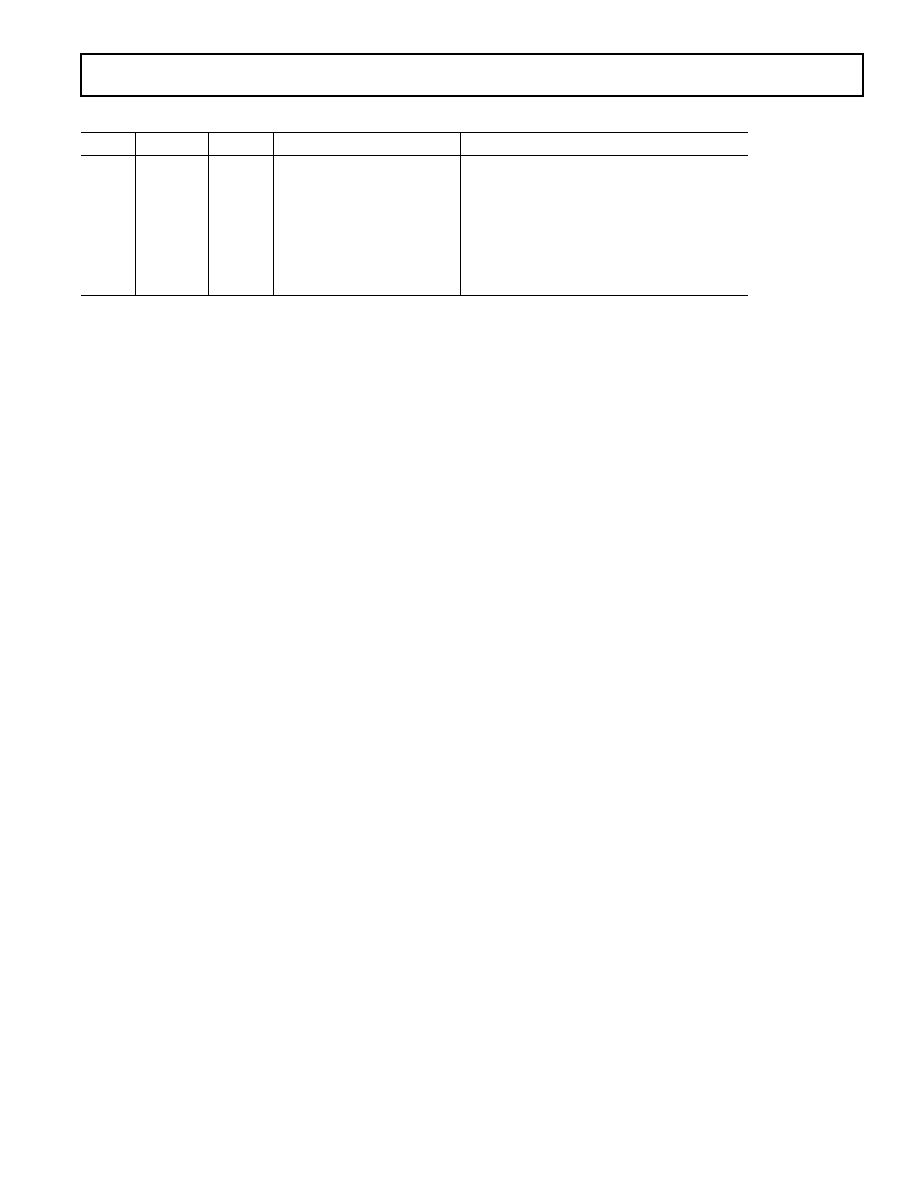
AD7715
11
REV. C
Table IV. Output Update Rates
CLK*
FS1
FS0
Output Update Rate
3 dB Filter Cutoff
0
0
0
20 Hz
5.24 Hz
0
0
1
25 Hz
6.55 Hz
0
1
0
100 Hz
26.2 Hz
0
1
1
200 Hz
52.4 Hz
1
0
0
50 Hz
13.1 Hz
1
0
1
60 Hz
15.7 Hz
Default Status
1
1
0
250 Hz
65.5 Hz
1
1
1
500 Hz
131 Hz
*Assumes correct clock frequency at MCLK IN pin
B/U
Bipolar/Unipolar Operation. A 0 in this bit selects Bipolar Operation. This is the default (Power-On or
RESET) status of this bit. A 1 in this bit selects unipolar operation.
BUF
Buffer Control. With this bit low, the on-chip buffer on the analog input is shorted out. With the buffer
shorted out, the current flowing in the AV
DD
line is reduced to 250
µ
A (all gains at f
CLK IN
= 1 MHz and gain
of 1 or 2 at f
CLK IN
= 2.4576 MHz) or 500
µ
A (gains of 32 and 128 @ f
CLK IN
= 2.4576 MHz) and the output
noise from the part is at its lowest. When this bit is high, the on-chip buffer is in series with the analog input
allowing the input to handle higher source impedances.
FSYNC
Filter Synchronization. When this bit is high, the nodes of the digital filter, the filter control logic and the
calibration control logic are held in a reset state and the analog modulator is also held in its reset state. When
this bit goes low, the modulator and filter start to process data and a valid word is available in 3
×
1/(output
update rate), i.e., the settling-time of the filter. This FSYNC bit does not affect the digital interface and does
not reset the
DRDY output if it is low.
Test Register (RS1, RS0 = 1, 0)
The part contains a Test Register which is used in testing the device. The user is advised not to change the status of any of the
bits in this register from the default (Power-On or RESET) status of all 0s as the part will be placed in one of its test modes and
will not operate correctly. If the part enters one of its test modes, exercising
RESET will exit the part from the mode. An alterna-
tive scheme for getting the part out of one of its test modes, is to reset the interface by writing 32 successive 1s to the part and
then load all 0s to the Test Register.
Data Register (RS1, RS0 = 1, 1)
The Data Register on the part is a read-only 16-bit register which contains the most up-to-date conversion result from the
AD7715. If the Communications Register data sets up the part for a write operation to this register, a write operation must actu-
ally take place to return the part to where it is expecting a write operation to the Communications Register (the default state of
the interface). However, the 16 bits of data written to the part will be ignored by the AD7715.
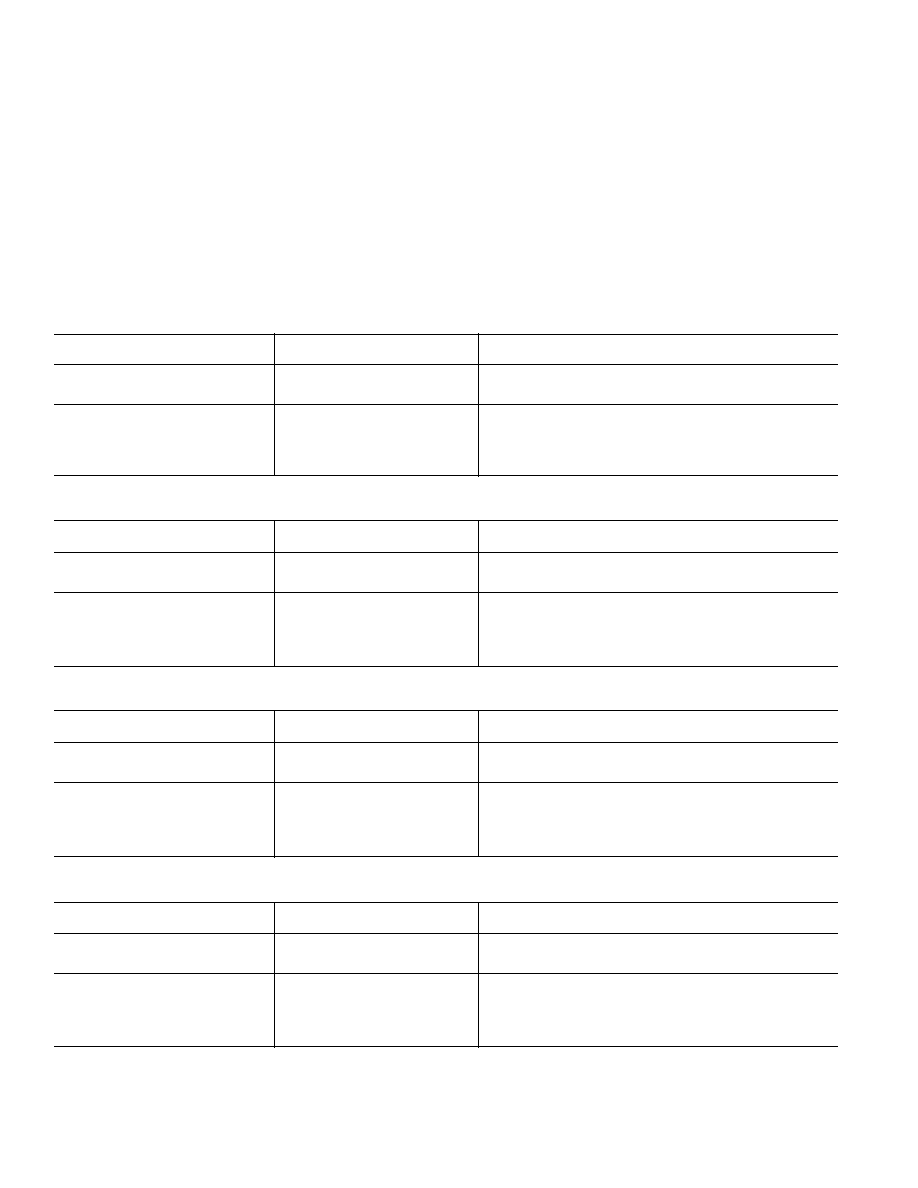
REV. C
AD7715
12
OUTPUT NOISE
AD7715-5
Table V shows the AD7715-5 output rms noise for the selectable notch and 3 dB frequencies for the part, as selected by FS1 and
FS0 of the Setup Register. The numbers given are for the bipolar input ranges with a V
REF
of +2.5 V. These numbers are typical
and are generated at a differential analog input voltage of 0 V with the part used in unbuffered mode (BUF bit of the Setup Register
= 0). Table VI meanwhile shows the output peak-to-peak noise for the selectable notch and 3 dB frequencies for the part. It is im-
portant to note that these numbers represent the resolution for which there will be no code flicker. They are not calculated based on rms noise but
on peak-to-peak noise. The numbers given are for the bipolar input ranges with a V
REF
of +2.5 V and for the BUF bit of the Setup
Register = 0. These numbers are typical, are generated at an analog input voltage of 0 V and are rounded to the nearest LSB.
Meanwhile, Table VII and Table VIII show rms noise and peak-to-peak resolution respectively with the AD7715-5 operating under
the same conditions as above except that now the part is operating in buffered mode (BUF Bit of the Setup Register = 1).
Table V. Output RMS Noise vs. Gain and Output Update Rate for AD7715-5 (Unbuffered Mode)
Filter First Notch & O/P Data Rate
3 dB Frequency
Typical Output RMS Noise in V
MCLK IN =
MCLK IN =
MCLK IN =
MCLK IN =
2.4576 MHz
1 MHz
2.4576 MHz
1 MHz
GAIN = 1
GAIN = 2
GAIN = 32
GAIN = 128
50 Hz
20 Hz
13.1 Hz
5.24 Hz
3.8
1.9
0.6
0.52
60 Hz
25 Hz
15.72 Hz
6.55 Hz
4.8
2.4
0.6
0.62
250 Hz
100 Hz
65.5 Hz
26.2 Hz
103
45
3.0
1.6
500 Hz
200 Hz
131 Hz
52.4 Hz
530
250
18
5.5
Table VI. Peak-to-Peak Resolution vs. Gain and Output Update Rate for AD7715-5 (Unbuffered Mode)
Filter First Notch & O/P Data Rate
3 dB Frequency
Typical Peak-to-Peak Resolution in Bits
MCLK IN =
MCLK IN =
MCLK IN =
MCLK IN =
2.4576 MHz
1 MHz
2.4576 MHz
1 MHz
GAIN = 1
GAIN = 2
GAIN = 32
GAIN = 128
50 Hz
20 Hz
13.1 Hz
5.24 Hz
16
16
16
14
60 Hz
25 Hz
15.72 Hz
6.55 Hz
16
16
16
13
250 Hz
100 Hz
65.5 Hz
26.2 Hz
13
13
13
12
500 Hz
200 Hz
131 Hz
52.4 Hz
10
10
10
10
Table VII. Output RMS Noise vs. Gain and Output Update Rate for AD7715-5 (Buffered Mode)
Filter First Notch & O/P Data Rate
3 dB Frequency
Typical Output RMS Noise in V
MCLK IN =
MCLK IN =
MCLK IN =
MCLK IN =
2.4576 MHz
1 MHz
2.4576 MHz
1 MHz
GAIN = 1
GAIN = 2
GAIN = 32
GAIN = 128
50 Hz
20 Hz
13.1 Hz
5.24 Hz
4.3
2.2
0.9
0.9
60 Hz
25 Hz
15.72 Hz
6.55 Hz
5.1
3.1
1.0
1.0
250 Hz
100 Hz
65.5 Hz
26.2 Hz
103
50
3.9
2.1
500 Hz
200 Hz
131 Hz
52.4 Hz
550
280
18
6
Table VIII. Peak-to-Peak Resolution vs. Gain and Output Update Rate for AD7715-5 (Buffered Mode)
Filter First Notch & O/P Data Rate
3 dB Frequency
Typical Peak-to-Peak Resolution in Bits
MCLK IN =
MCLK IN =
MCLK IN =
MCLK IN =
2.4576 MHz
1 MHz
2.4576 MHz
1 MHz
GAIN = 1
GAIN = 2
GAIN = 32
GAIN = 128
50 Hz
20 Hz
13.1 Hz
5.24 Hz
16
16
15
13
60 Hz
25 Hz
15.72 Hz
6.55 Hz
16
16
15
13
250 Hz
100 Hz
65.5 Hz
26.2 Hz
13
13
13
12
500 Hz
200 Hz
131 Hz
52.4 Hz
10
10
10
10
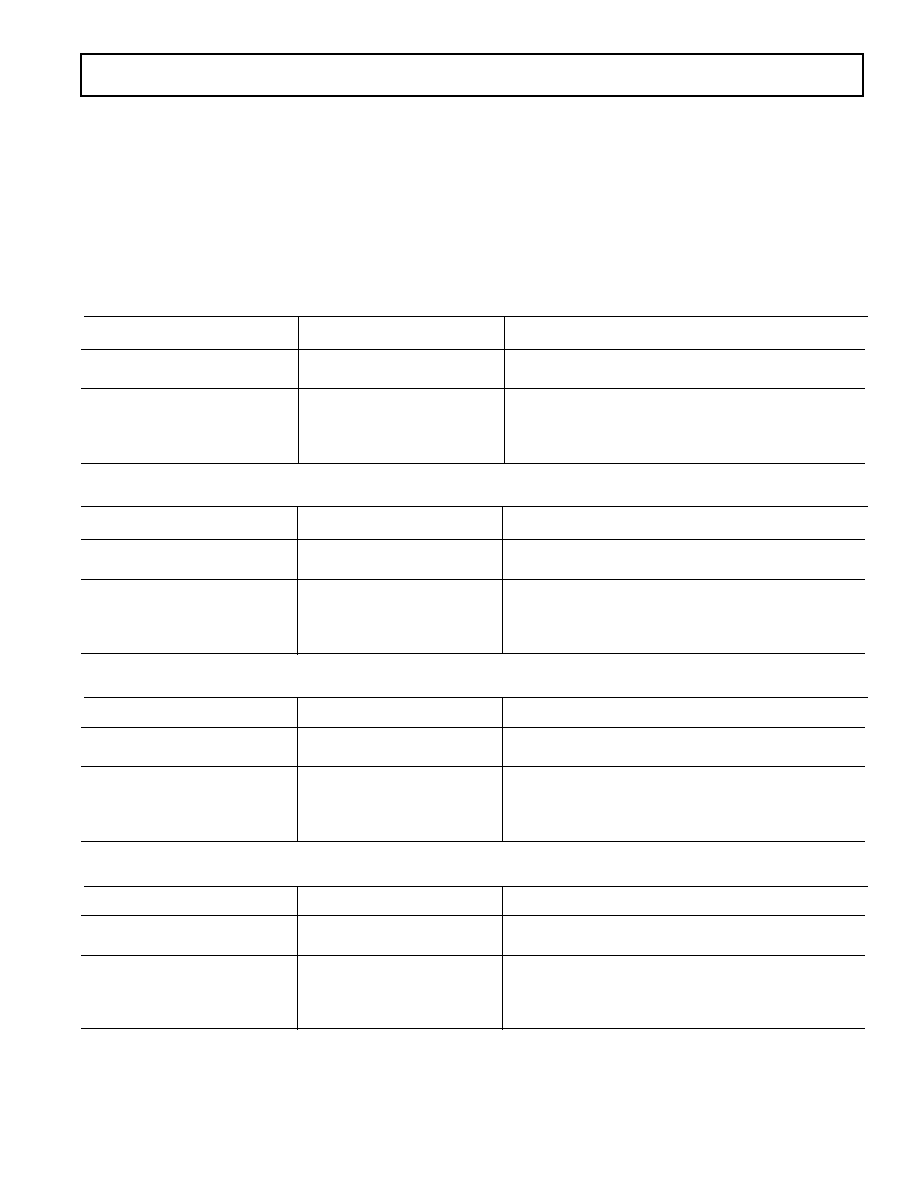
AD7715
13
REV. C
AD7715-3
Table IX shows the AD7715-3 output rms noise for the selectable notch and 3 dB frequencies for the part, as selected by FS1 and
FS0 of the Setup Register. The numbers given are for the bipolar input ranges with a V
REF
of +1.25 V. These numbers are typical
and are generated at an analog input voltage of 0 V with the part used in unbuffered mode (BUF bit of the Setup Register = 0).
Table X meanwhile shows the output peak-to-peak noise for the selectable notch and 3 dB frequencies for the part. It is important to
note that these numbers represent the resolution for which there will be no code flicker. They are not calculated based on rms noise but on peak-
to-peak noise. The numbers given are for the bipolar input ranges with a V
REF
of +1.25 V and for the BUF bit of the Setup Register =
0. These numbers are typical, are generated at an analog input voltage of 0 V and are rounded to the nearest LSB.
Meanwhile, Table XI and Table XII show rms noise and peak-to-peak resolution respectively with the AD7715-3 operating under
the same conditions as above except that now the part is operating in buffered mode (BUF Bit of the Setup Register = 1).
Table IX. Output RMS Noise vs. Gain and Output Update Rate for AD7715-3 (Unbuffered Mode)
Filter First Notch & O/P Data Rate
3 dB Frequency
Typical Output RMS Noise in V
MCLK IN =
MCLK IN =
MCLK IN =
MCLK IN =
2.4576 MHz
1 MHz
2.4576 MHz
1 MHz
GAIN = 1
GAIN = 2
GAIN = 32
GAIN = 128
50 Hz
20 Hz
13.1 Hz
5.24 Hz
3.0
1.7
0.7
0.65
60 Hz
25 Hz
15.72 Hz
6.55 Hz
3.4
2.1
0.7
0.7
250 Hz
100 Hz
65.5 Hz
26.2 Hz
45
20
2.2
1.6
500 Hz
200 Hz
131 Hz
52.4 Hz
270
135
9.7
3.3
Table X. Peak-to-Peak Resolution vs. Gain and Output Update Rate for AD7715-3 (Unbuffered Mode)
Filter First Notch & O/P Data Rate
3 dB Frequency
Typical Peak-to-Peak Resolution in Bits
MCLK IN =
MCLK IN =
MCLK IN =
MCLK IN =
2.4576 MHz
1 MHz
2.4576 MHz
1 MHz
GAIN = 1
GAIN = 2
GAIN = 32
GAIN = 128
50 Hz
20 Hz
13.1 Hz
5.24 Hz
16
16
14
12
60 Hz
25 Hz
15.72 Hz
6.55 Hz
16
16
14
12
250 Hz
100 Hz
65.5 Hz
26.2 Hz
13
13
13
11
500 Hz
200 Hz
131 Hz
52.4 Hz
11
11
10
10
Table XI. Output RMS Noise vs. Gain and Output Update Rate for AD7715-3 (Buffered Mode)
Filter First Notch & O/P Data Rate
3 dB Frequency
Typical Output RMS Noise in V
MCLK IN =
MCLK IN =
MCLK IN =
MCLK IN =
2.4576 MHz
1 MHz
2.4576 MHz
1 MHz
GAIN = 1
GAIN = 2
GAIN = 32
GAIN = 128
50 Hz
20 Hz
13.1 Hz
5.24 Hz
4.5
2.4
0.9
0.9
60 Hz
25 Hz
15.72 Hz
6.55 Hz
5.1
2.9
0.9
1.0
250 Hz
100 Hz
65.5 Hz
26.2 Hz
50
25
2.6
2
500 Hz
200 Hz
131 Hz
52.4 Hz
270
135
9.7
3.3
Table XII. Peak-to-Peak Resolution vs. Gain and Output Update Rate for AD7715-3 (Buffered Mode)
Filter First Notch & O/P Data Rate
3 dB Frequency
Typical Peak-to-Peak Resolution in Bits
MCLK IN =
MCLK IN =
MCLK IN =
MCLK IN =
2.4576 MHz
1 MHz
2.4576 MHz
1 MHz
GAIN = 1
GAIN = 2
GAIN = 32
GAIN = 128
50 Hz
20 Hz
13.1 Hz
5.24 Hz
16
16
14
12
60 Hz
25 Hz
15.72 Hz
6.55 Hz
16
16
14
12
250 Hz
100 Hz
65.5 Hz
26.2 Hz
13
13
12
11
500 Hz
200 Hz
131 Hz
52.4 Hz
10
11
10
10
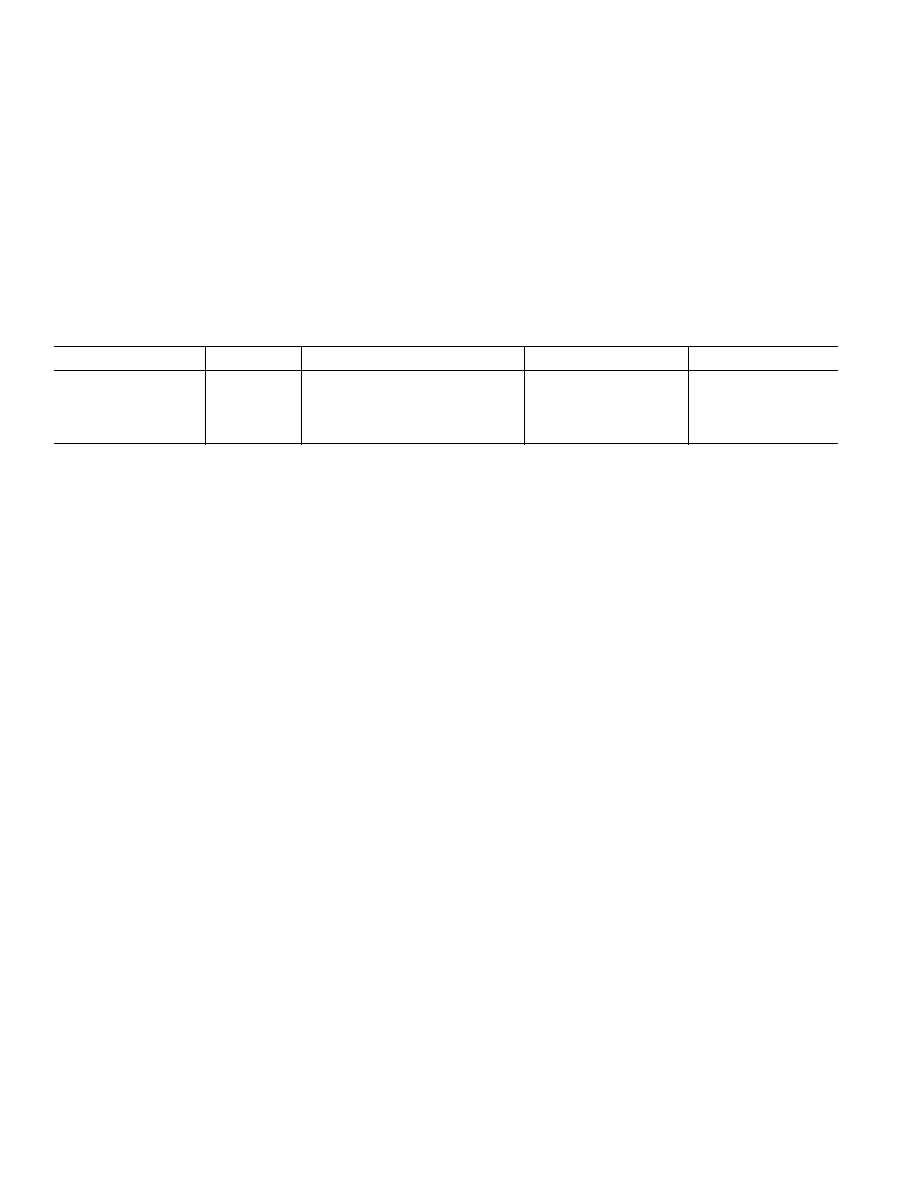
REV. C
AD7715
14
CALIBRATION SEQUENCES
The AD7715 contains a number of calibration options as outlined previously. Table XIII summarizes the calibration types, the op-
erations involved and the duration of the operations. There are two methods of determining the end of calibration. The first is to
monitor when
DRDY returns low at the end of the sequence. DRDY not only indicates when the sequence is complete but also that
the part has a valid new sample in its data register. This valid new sample is the result of a normal conversion which follows the cali-
bration sequence. The second method of determining when calibration is complete is to monitor the MD1 and MD0 bits of the
Setup Register. When these bits return to 0, 0 following a calibration command, it indicates that the calibration sequence is com-
plete. This method does not give any indication of there being a valid new result in the data register. However, it gives an earlier
indication than
DRDY that calibration is complete. The duration to when the Mode Bits (MD1 and MD0) return to 0, 0 represents
the duration of the calibration carried out. The sequence to when
DRDY goes low also includes a normal conversion and a pipeline
delay, t
P
, to correctly scale the results of this first conversion. t
P
will never exceed 2000
×
t
CLK IN
. The time for both methods is given
in the table.
Table XIII. Calibration Sequences
Calibration Type
MD1, MD0
Calibration Sequence
Duration to Mode Bits
Duration to
DRDY
Self Calibration
0, 1
Internal ZS Cal @ Selected Gain +
6
×
1/Output Rate
9
×
1/Output Rate + t
P
Internal FS Cal @ Selected Gain
ZS System Calibration
1, 0
ZS Cal on AIN @ Selected Gain
3
×
1/Output Rate
4
×
1/Output Rate + t
P
FS System Calibration
1, 1
FS Cal on AIN @ Selected Gain
3
×
1/Output Rate
4
×
1/Output Rate + t
P
CIRCUIT DESCRIPTION
The AD7715 is a sigma-delta A/D converter with on-chip digital
filtering, intended for the measurement of wide dynamic range,
low frequency signals such as those in industrial control or pro-
cess control applications. It contains a sigma-delta (or charge-
balancing) ADC, a calibration microcontroller with on-chip
static RAM, a clock oscillator, a digital filter and a bidirectional
serial communications port. The part consumes only 450
µ
A of
power supply current, making it ideal for battery-powered or
loop-powered instruments. The part comes in two versions, the
AD7715-5 which is specified for operation from a nominal
+5 V analog supply (AV
DD
) and the AD7715-3 which is speci-
fied for operation from a nominal +3.3 V analog supply. Both
versions can be operated with a digital supply (DV
DD
) voltage of
+3.3 V or +5 V.
The part contains a programmable-gain fully differential analog
input channel. The selectable gains on this input are 1, 2, 32
and 128 allowing the part to accept unipolar signals of between
0 mV to +20 mV and 0 V to +2.5 V or bipolar signals in the
range from
±
20 mV to
±
2.5 V when the reference input voltage
equals +2.5 V. With a reference voltage of +1.25 V, the input
ranges are from 0 mV to +10 mV to 0 V to +1.25 V in unipolar
mode and from
±
10 mV to
±
1.25 V in bipolar mode. Note that
the bipolar ranges are with respect to AIN() and not with re-
spect to AGND.
The input signal to the analog input is continuously sampled at
a rate determined by the frequency of the master clock,
MCLK IN, and the selected gain. A charge-balancing A/D
converter (sigma-delta modulator) converts the sampled signal
into a digital pulse train whose duty cycle contains the digital
information. The programmable gain function on the analog
input is also incorporated in this sigma-delta modulator with the
input sampling frequency being modified to give the higher
gains. A sinc
3
digital low-pass filter processes the output of the
sigma-delta modulator and updates the output register at a rate
determined by the first notch frequency of this filter. The out-
put data can be read from the serial port randomly or periodi-
cally at any rate up to the output register update rate. The first
notch of this digital filter (and hence its 3 dB frequency) can be
programmed via the Setup Register bits FS0 and FS1. With a
master clock frequency of 2.4576 MHz, the programmable
range for this first notch frequency is from 50 Hz to 500 Hz
giving a programmable range for the 3 dB frequency of
13.1 Hz to 131 Hz. With a master clock frequency of 1 MHz,
the programmable range for this first notch frequency is from
20 Hz to 200 Hz giving a programmable range for the 3 dB
frequency of 5.24 Hz to 52.4 Hz.
The basic connection diagram for the AD7715-5 is shown in
Figure 2. This shows both the AV
DD
and DV
DD
pins of the
AD7715 being driven from the analog +5 V supply. Some
applications will have AV
DD
and DV
DD
driven from separate
supplies. An AD780, precision +2.5 V reference, provides the
reference source for the part. On the digital side, the part is
configured for three-wire operation with
CS tied to DGND. A
quartz crystal or ceramic resonator provides the master clock
source for the part. In most cases, it will be necessary to connect
capacitors on the crystal or resonator to ensure that it does
not oscillate at overtones of its fundamental operating fre-
quency. The values of capacitors will vary depending on the
manufacturer's specifications.
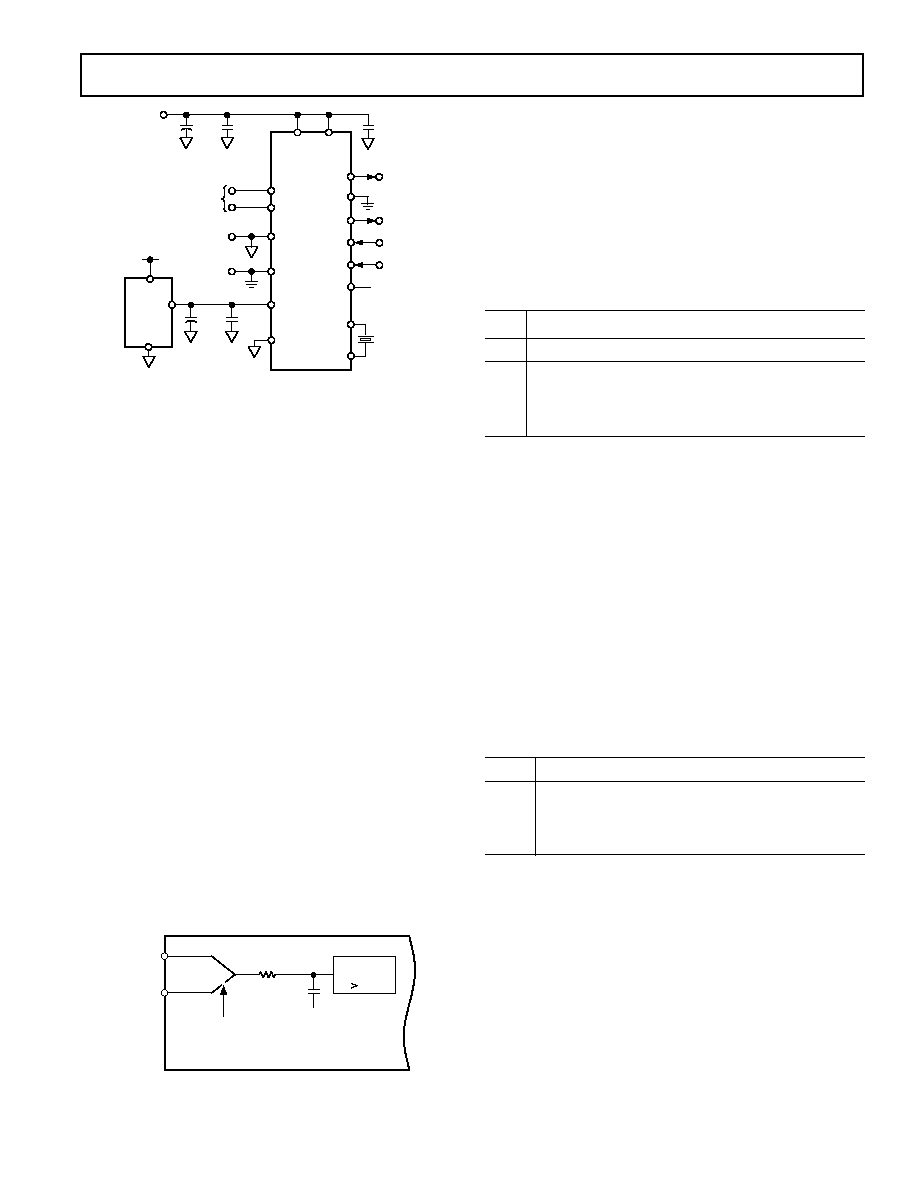
AD7715
15
REV. C
C
SAMP
must be charged through R
SW
and through any external
source impedances every input sample cycle. Therefore, in
unbuffered mode, source impedances mean a longer charge time
for C
SAMP
, and this may result in gain errors on the part. Table
XIV shows the allowable external resistance/capacitance values,
for unbuffered mode, such that no gain error to the 16-bit level
is introduced on the part. Note that these capacitances are total
capacitances on the analog input, external capacitance plus
10 pF capacitance from the pins and lead frame of the device.
Table XIV. External R, C Combination for No 16-Bit Gain
Error (Unbuffered Mode Only)
Gain
External Capacitance (pF)
10
50
100
500
1000
5000
1
152 k
53.9 k
31.4 k
8.4 k
4.76 k
1.36 k
2
75.1 k
26.6 k
15.4 k
4.14 k
2.36 k
670
32
16.7 k
5.95 k
3.46 k
924
526
150
128
16.7 k
5.95 k
3.46 k
924
526
150
In buffered mode, the analog inputs look into the high imped-
ance inputs stage of the on-chip buffer amplifier. C
SAMP
is
charged via this buffer amplifier such that source impedances do
not affect the charging of C
SAMP
. This buffer amplifier has an
offset leakage current of 1 nA. In this buffered mode, large
source impedances result in a small dc offset voltage developed
across the source impedance but not in a gain error.
Input Sample Rate
The modulator sample frequency for the AD7715 remains at
f
CLK IN
/128 (19.2 kHz @ f
CLK IN
= 2.4576 MHz) regardless of
the selected gain. However, gains greater than 1 are achieved by
a combination of multiple input samples per modulator cycle
and a scaling of the ratio of reference capacitor to input capaci-
tor. As a result of the multiple sampling, the input sample rate
of the device varies with the selected gain (see Table XV). In
buffered mode, the input is buffered before the input sampling
Table XV. Input Sampling Frequency vs. Gain
Gain
Input Sampling Freq (f
S
)
1
f
CLK IN
/64 (38.4 kHz @ f
CLK IN
= 2.4576 MHz)
2
2
×
f
CLK IN
/64 (76.8 kHz @ f
CLK IN
= 2.4576 MHz)
32
8
×
f
CLK IN
/64 (307.2 kHz @ f
CLK IN
= 2.4576 MHz)
128
8
×
f
CLK IN
/64 (307.2 kHz @ f
CLK IN
= 2.4576 MHz)
capacitor. In unbuffered mode, where the analog input looks
directly into the sampling capacitor, the effective input imped-
ance is 1/C
SAMP
×
f
S
where C
SAMP
is the input sampling capaci-
tance and f
S
is the input sample rate.
Bipolar/Unipolar Inputs
The analog input on the AD7715 can accept either unipolar or
bipolar input voltage ranges. Bipolar input ranges do not imply
that the part can handle negative voltages on its analog input
since the analog input cannot go more negative than 30 mV to
ensure correct operation of the part. The input channel is fully
differential. As a result, the voltage to which the unipolar and
bipolar signals on the AIN(+) input are referenced is the voltage
on the respective AIN() input. For example, if AIN() is
+2.5 V and the AD7715 is configured for unipolar operation
SCLK
MCLK IN
DGND
DV
DD
MCLK OUT
DIN
DOUT
AGND
AIN(+)
AIN()
REF IN(+)
REF IN()
AV
DD
AD7715
0.1 F
ANALOG
GROUND
DIFFERENTIAL
ANALOG INPUT
DIGITAL
GROUND
0.1 F
10 F
V
OUT
V
IN
GND
AD780
ANALOG
+5V SUPPLY
DATA READY
RECEIVE (READ)
SERIAL DATA
SERIAL CLOCK
CRYSTAL OR
CERAMIC
RESONATOR
+5V
0.1 F
10 F
ANALOG
+5V SUPPLY
RESET
CS
DRDY
Figure 2. AD7715-5 Basic Connection Diagram
ANALOG INPUT
Analog Input Ranges
The AD7715 contains a differential analog input pair AIN(+)
and AIN(). This input pair provides a programmable-gain,
differential input channel which can handle either unipolar or
bipolar input signals. It should be noted that the bipolar input
signals are referenced to the respective AIN() input of the
input pair.
In unbuffered mode, the common-mode range of the input is
from AGND to AV
DD
provided that the absolute value of the
analog input voltage lies between AGND 30 mV and
AV
DD
+ 30 mV. This means that in unbuffered mode the part
can handle both unipolar and bipolar input ranges for all gains.
In buffered mode, the analog inputs can handle much larger
source impedances but the absolute input voltage range is re-
stricted to between AGND + 50 mV to AV
DD
1.5 V which
also places restrictions on the common-mode range. This means
that in buffered mode there are some restrictions on the allow-
able gains for bipolar input ranges. Care must be taken in set-
ting up the common-mode voltage and input voltage range so
that the above limits are not exceeded, otherwise there will be a
degradation in linearity performance.
In unbuffered mode, the analog inputs look directly into the
input sampling capacitor, C
SAMP
. The dc input leakage current
in this unbuffered mode is 1 nA maximum. As a result, the
analog inputs see a dynamic load that is switched at the input
sample rate (see Figure 3). This sample rate depends on master
clock frequency and selected gain. C
SAMP
is charged to AIN(+)
and discharged to AIN() every input sample cycle. The effec-
tive on-resistance of the switch, R
SW
, is typically 7 k
.
HIGH
IMPEDANCE
1G
R
SW
(7k TYP)
C
SAMP
(10pF )
V
BIAS
SWITCHING FREQUENCY
DEPENDS ON
f
CLKIN
AND SELECTED GAIN
AIN(+)
AIN()
Figure 3. Unbuffered Analog Input Structure

REV. C
AD7715
16
DIGITAL FILTERING
The AD7715 contains an on-chip low-pass digital filter that
processes the output of the part's sigma-delta modulator. There-
fore, the part not only provides the analog-to-digital conversion
function but it also provides a level of filtering. There are a
number of system differences when the filtering function is
provided in the digital domain rather than the analog domain
and the user should be aware of these.
First, since digital filtering occurs after the A-to-D conversion
process, it can remove noise injected during the conversion
process. Analog filtering cannot do this. Also, the digital filter
can be made programmable far more readily than an analog
filter. Depending on the digital filter design, this gives the user
the capability of programming cutoff frequency and output
update rate.
On the other hand, analog filtering can remove noise superim-
posed on the analog signal before it reaches the ADC. Digital
filtering cannot do this and noise peaks riding on signals near
full scale have the potential to saturate the analog modulator
and digital filter, even though the average value of the signal is
within limits. To alleviate this problem, the AD7715 has over-
range headroom built into the sigma-delta modulator and digital
filter which allows overrange excursions of 5% above the analog
input range. If noise signals are larger than this, consideration
should be given to analog input filtering, or to reducing the
input channel voltage so that its full scale is half that of the
analog input channel full scale. This will provide an overrange
capability greater than 100% at the expense of reducing the
dynamic range by 1 bit (50%).
In addition, the digital filter does not provide any rejection at
integer multiples of the digital filter's sample frequency. How-
ever, the input sampling on the part provides attenuation at
multiples of the digital filter's sampling frequency so that the
unattenu-ated bands actually occur around multiples of the
sampling frequency f
S
(as defined in Table XV). Thus the unat-
tenuated bands occur at n
×
f
S
(where n = 1, 2, 3. . . ). At these
frequencies, there are frequency bands,
±
f
3 dB
wide (f
3 dB
is the
cutoff frequency of the digital filter) at either side where noise
passes unattenuated to the output.
Filter Characteristics
The AD7715's digital filter is a low-pass filter with a (sinx/x)
3
response (also called sinc
3
). The transfer function for this filter
is described in the z-domain by:
and in the frequency domain by:
where N is the ratio of the modulator rate to the output rate and
f
MOD
is the modulator rate.
with a gain of 2 and a V
REF
of +2.5 V, the input voltage range
on the AIN(+) input is +2.5 V to +3.75 V. If AIN() is +2.5 V
and the AD7715 is configured for bipolar mode with a gain of 2
and a V
REF
of +2.5 V, the analog input range on the AIN(+)
input is +1.25 V to +3.75 V (i.e., 2.5 V
±
1.25 V). If AIN() is
at AGND, the part cannot be configured for bipolar ranges in
excess of
±
30 mV.
Bipolar or unipolar options are chosen by programming the
B/U
bit of the Setup Register. This programs the channel for either
unipolar or bipolar operation. Programming the channel for
either unipolar or bipolar operation does not change any of the
input signal conditioning; it simply changes the data output
coding and the points on the transfer function where calibra-
tions occur.
REFERENCE INPUT
The AD7715's reference inputs, REF IN(+) and REF IN(),
provide a differential reference input capability. The common-
mode range for these differential inputs is from AGND to
AV
DD
. The nominal reference voltage, V
REF
(REF IN(+)
REF IN()), for specified operation is +2.5 V for the AD7715-5
and +1.25 V for the AD7715-3. The part is functional with
V
REF
voltages down to 1 V but with degraded performance as
the output noise will, in terms of LSB size, be larger. REF IN(+)
must always be greater than REF IN() for correct operation of
the AD7715.
Both reference inputs provide a high impedance, dynamic load
similar to the analog inputs in unbuffered mode. The maximum
dc input leakage current is
±
1 nA over temperature and source
resistance may result in gain errors on the part. In this case, the
sampling switch resistance is 5 k
typ and the reference capaci-
tor (C
REF
) varies with gain. The sample rate on the reference
inputs is f
CLK IN
/64 and does not vary with gain. For gains of 1
and 2, C
REF
is 8 pF; for a gain of 32, it is 4.25 pF, and for a gain
of 128, it is 3.3125 pF.
The output noise performance outlined in Tables V through XII
is for an analog input of 0 V which effectively removes the effect
of noise on the reference. To obtain the same noise performance
as shown in the noise tables over the full input range requires a
low noise reference source for the AD7715. If the reference
noise in the bandwidth of interest is excessive, it will degrade
the performance of the AD7715. In applications where the
excitation voltage for the bridge transducer on the analog input
also derives the reference voltage for the part, the effect of the
noise in the excitation voltage will be removed as the application
is ratiometric. Recommended reference voltage sources for the
AD7715-5 include the AD780, REF43 and REF192, while the
recommended reference sources for the AD7715-3 include the
AD589 and AD1580. It is generally recommended to decouple
the output of these references in order to further reduce the
noise level.
H z
N
z
z
N
( )
=
×
-
1
1
1
1
3
| ( )|
H f
N
Sin N
f
f
Sin
f
f
s
s
=
×
× ×
×
1
3
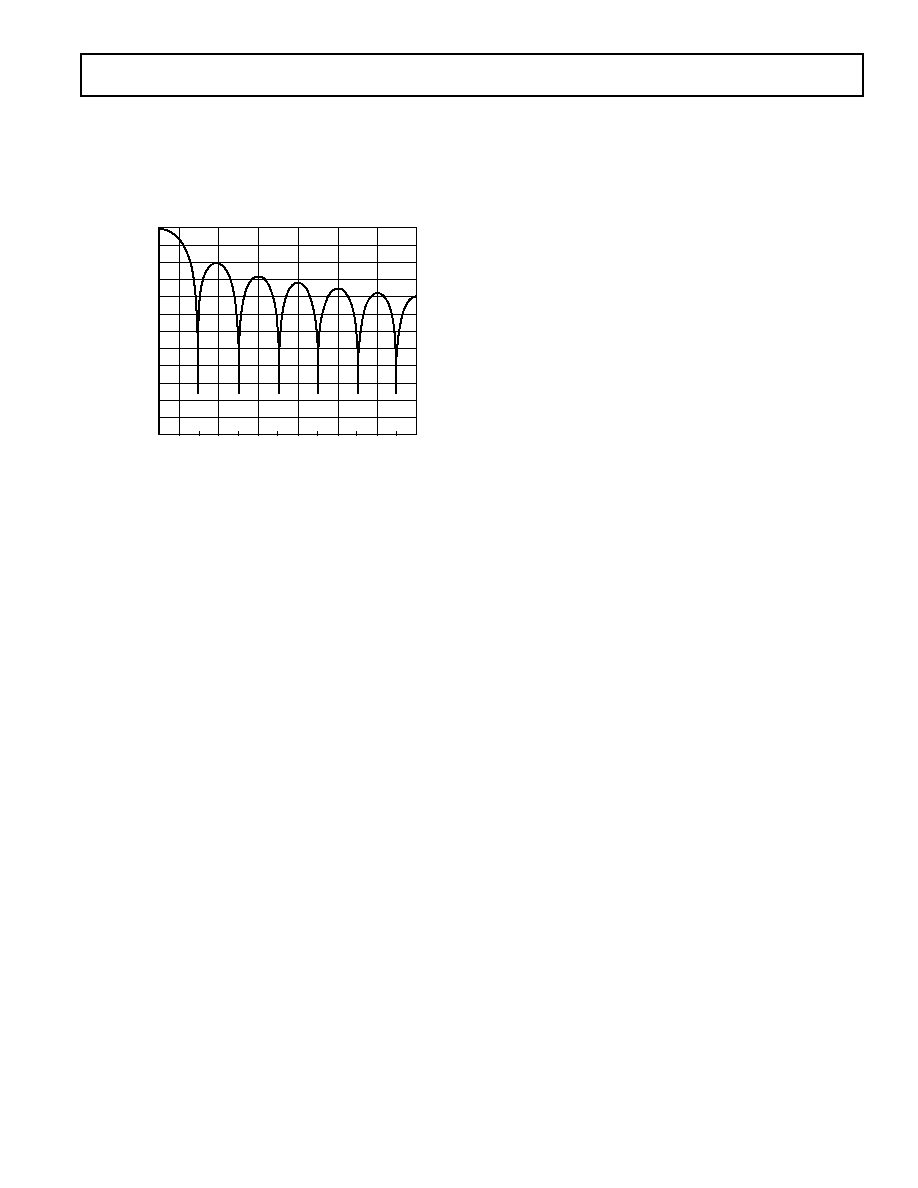
AD7715
17
REV. C
Figure 4 shows the filter frequency response for a cutoff fre-
quency of 15.72 Hz which corresponds to a first filter notch
frequency of 60 Hz. The plot is shown from dc to 390 Hz. This
response is repeated at either side of the digital filter's sample
frequency and at either side of multiples of the filter's sample
frequency.
FREQUENCY Hz
0
40
60
80
100
120
140
160
180
200
220
20
240
360
0
300
180
120
60
240
GAIN dB
Figure 4. Frequency Response of AD7715 Filter
The response of the filter is similar to that of an averaging filter
but with a sharper roll-off. The output rate for the digital filter
corresponds with the positioning of the first notch of the filter's
frequency response. Thus, for the plot of Figure 4 where the
output rate is 60 Hz, the first notch of the filter is at 60 Hz. The
notches of this (sinx/x)
3
filter are repeated at multiples of the
first notch. The filter provides attenuation of better than 100 dB
at these notches.
The cutoff frequency of the digital filter is determined by the
value loaded to bits FS0 to FS1 in the Setup Register. Pro-
gramming a different cutoff frequency via FS0 and FS1 does not
alter the profile of the filter response; it changes the frequency of
the notches. The output update of the part and the frequency of
the first notch correspond.
Since the AD7715 contains this on-chip, low-pass filtering,
there is a settling time associated with step function inputs and
data on the output will be invalid after a step change until the
settling time has elapsed. The settling time depends upon the
output rate chosen for the filter. The settling time of the filter
to a full-scale step input can be up 4 times the output data
period. For a synchronized step input (using the FSYNC func-
tion), the settling time is 3 times the output data period.
Post-Filtering
The on-chip modulator provides samples at a 19.2 kHz output
rate with f
CLK IN
at 2.4576 MHz. The on-chip digital filter
decimates these samples to provide data at an output rate which
corresponds to the programmed output rate of the filter. Since
the output data rate is higher than the Nyquist criterion, the
output rate for a given bandwidth will satisfy most application
requirements. However, there may be some applications which
require a higher data rate for a given bandwidth and noise per-
formance. Applications that need this higher data rate will
require some post-filtering following the digital filter of the
AD7715.
For example, if the required bandwidth is 7.86 Hz but the re-
quired update rate is 100 Hz, the data can be taken from the
AD7715 at the 100 Hz rate giving a 3 dB bandwidth of
26.2 Hz. Post-filtering can be applied to this to reduce the
bandwidth and output noise, to the 7.86 Hz bandwidth level,
while maintaining an output rate of 100 Hz.
Post-filtering can also be used to reduce the output noise from
the device for bandwidths below 13.1 Hz. At a gain of 128 and
a bandwidth of 13.1 Hz, the output rms noise is 520 nV. This
is essentially device noise or white noise and since the input is
chopped, the noise has a primarily flat frequency response. By
reducing the bandwidth below 13.1 Hz, the noise in the result-
ant passband can be reduced. A reduction in bandwidth by a
factor of 2 results in a reduction of approximately 1.25 in the
output rms noise. This additional filtering will result in a longer
settling time.
ANALOG FILTERING
The digital filter does not provide any rejection at integer mul-
tiples of the modulator sample frequency, as outlined earlier.
However, due to the AD7715's high oversampling ratio, these
bands occupy only a small fraction of the spectrum and most
broadband noise is filtered. This means that the analog filtering
requirements in front of the AD7715 are considerably reduced
versus a conventional converter with no on-chip filtering. In
addition, because the part's common-mode rejection perfor-
mance of 95 dB extends out to several kHz, common-mode
noise in this frequency range will be substantially reduced.
Depending on the application, however, it may be necessary to
provide attenuation prior to the AD7715 in order to eliminate
unwanted frequencies from these bands which the digital filter
will pass. It may also be necessary in some applications to pro-
vide analog filtering in front of the AD7715 to ensure that dif-
ferential noise signals outside the band of interest do not
saturate the analog modulator.
If passive components are placed in front of the AD7715, in
unbuffered mode, care must be taken to ensure that the source
impedance is low enough so as not to introduce gain errors in
the system. This significantly limits the amount of passive anti-
aliasing filtering which can be provided in front of the AD7715
when it is used in unbuffered mode. However, when the part is
used in buffered mode, large source impedances will simply
result in a small dc offset error (a 10 k
source resistance will
cause an offset error of less than 10
µ
V). Therefore, if the sys-
tem requires any significant source impedances to provide pas-
sive analog filtering in front of the AD7715, it is recommended
that the part be operated in buffered mode.
CALIBRATION
The AD7715 provides a number of calibration options that can
be programmed via the MD1 and MD0 bits of the Setup Regis-
ter. The different calibration options are outlined in the Setup
Register and Calibration Sequences sections. A calibration cycle
may be initiated at any time by writing to these bits of the Setup
Register. Calibration on the AD7715 removes offset and gain
errors from the device. A calibration routine should be initiated
on the device whenever there is a change in the ambient operat-
ing temperature or supply voltage. It should also be initiated if
there is a change in the selected gain, filter notch or bipolar/
unipolar input range.
The AD7715 offers self-calibration and system-calibration facili-
ties. For full calibration to occur on the selected channel, the
on-chip microcontroller must record the modulator output for
two different input conditions. These are "zero-scale" and

REV. C
AD7715
18
"full-scale" points. These points are derived by performing a
conversion on the different input voltages provided to the input
of the modulator during calibration. As a result, the accuracy of
the calibration can only be as good as the noise level that it
provides in normal mode. The result of the "zero-scale" calibra-
tion conversion is stored in the Zero-Scale Calibration Register
while the result of the "full-scale" calibration conversion is
stored in the Full-Scale Calibration Register. With these read-
ings, the on-chip microcontroller can calculate the offset and the
gain slope for the input to output transfer function of the con-
verter. Internally, the part works with a resolution of 33 bits to
determine its conversion result of 16 bits.
Self-Calibration
A self-calibration is initiated on the AD7715 by writing the
appropriate values (0, 1) to the MD1 and MD0 bits of the
Setup Register. In the self-calibration mode with a unipolar
input range, the zero-scale point used in determining the cali-
bration coefficients is with the inputs of the differential pair
internally shorted on the part (i.e., AIN(+) = AIN() = Internal
Bias Voltage). The PGA is set for the selected gain (as per G1
and G0 bits in the Communications Register) for this zero-scale
calibration conversion. The full-scale calibration conversion is
performed at the selected gain on an internally generated voltage
of V
REF
/Selected Gain.
The duration time for the calibration is 6
×
1/Output Rate. This
is made up of 3
×
1/Output Rate for the zero-scale calibration
and 3
×
1/Output Rate for the full-scale calibration. At this time
the MD1 and MD0 bits in the Setup Register return to 0, 0.
This gives the earliest indication that the calibration sequence is
complete. The
DRDY line goes high when calibration is initi-
ated and does not return low until there is a valid new word in
the data register. The duration time from the calibration com-
mand being issued to
DRDY going low is 9
×
1/Output Rate.
This is made up of 3
×
1/Output Rate for the zero-scale calibra-
tion, 3
×
1/Output Rate for the full-scale calibration, 3
×
1/
Output Rate for a conversion on the analog input and some
overhead to set up the coefficients correctly. If
DRDY is low
before (or goes low during) the calibration command write to
the Setup Register, it may take up to one modulator cycle
(MCLK IN/128) before
DRDY goes high to indicate that cali-
bration is in progress. Therefore,
DRDY should be ignored for
up to one modulator cycle after the last bit is written to the
Setup Register in the calibration command.
For bipolar input ranges in the self-calibrating mode, the se-
quence is very similar to that just outlined. In this case, the two
points are exactly the same as above, but since the part is config-
ured for bipolar operation, the shorted inputs point is actually
midscale of the transfer function.
System Calibration
System calibration allows the AD7715 to compensate for system
gain and offset errors as well as its own internal errors. System
calibration performs the same slope factor calculations as self-
calibration but uses voltage values presented by the system to
the AIN inputs for the zero- and full-scale points. Full System
calibration requires a two step process, a ZS System Calibration
followed by a FS System Calibration.
For a full system calibration, the zero-scale point must be pre-
sented to the converter first. It must be applied to the converter
before the calibration step is initiated and remain stable until the
step is complete. Once the system zero scale voltage has been set
up, a ZS System Calibration is then initiated by writing the ap-
propriate values (1, 0) to the MD1 and MD0 bits of the Setup
Register. The zero-scale system calibration is performed at the
selected gain. The duration of the calibration is 3
×
1/Output
Rate. At this time the MD1 and MD0 bits in the Setup Register
return to 0, 0. This gives the earliest indication that the calibration
sequence is complete. The
DRDY line goes high when calibration
is initiated and does not return low until there is a valid new
word in the data register. The duration time from the calibra-
tion command being issued to
DRDY going low is 4
×
1/Output
Rate as the part performs a normal conversion on the AIN volt-
age before
DRDY goes low. If DRDY is low before (or goes low
during) the calibration command write to the Setup Register, it
may take up to one modulator cycle (MCLK IN/128) before
DRDY goes high to indicate that calibration is in progress.
Therefore,
DRDY should be ignored for up to one modulator
cycle after the last bit is written to the Setup Register in the
calibration command.
After the zero-scale point is calibrated, the full-scale point is
applied to AIN and the second step of the calibration process is
initiated by again writing the appropriate values (1, 1) to MD1
and MD0. Again the full-scale voltage must be set up before
the calibration is initiated and it must remain stable throughout
the calibration step. The full-scale system calibration is per-
formed at the selected gain. The duration of the calibration is
3
×
1/Output Rate. At this time the MD1 and MD0 bits in the
Setup Register return to 0, 0. This gives the earliest indication
that the calibration sequence is complete. The
DRDY line goes
high when calibration is initiated and does not return low until
there is a valid new word in the data register. The duration time
from the calibration command being issued to
DRDY going low
is 4
×
1/Output Rate as the part performs a normal conversion
on the AIN voltage before
DRDY goes low. If DRDY is low
before (or goes low during) the calibration command, write to
the Setup Register, it may take up to one modulator cycle
(MCLK IN/128) before
DRDY goes high to indicate that cali-
bration is in progress. Therefore,
DRDY should be ignored for
up to one modulator cycle after the last bit is written to the
Setup Register in the calibration command.
In the unipolar mode, the system calibration is performed be-
tween the two endpoints of the transfer function; in the bipolar
mode, it is performed between midscale (zero differential volt-
age) and positive full scale.
The fact that the system calibration is a two-step calibration
offers another feature. After the sequence of a full system cali-
bration has been completed, additional offset or gain calibra-
tions can be performed by themselves to adjust the system zero
reference point or the system gain. Calibrating one of the pa-
rameters, either system offset or system gain, will not affect the
other parameter.
System calibration can also be used to remove any errors from
source impedances on the analog input when the part is used in
unbuffered mode. A simple R, C antialiasing filter on the front
end may introduce a gain error on the analog input voltage but
the system calibration can be used to remove this error.
Span and Offset Limits
Whenever a system calibration mode is used, there are limits on
the amount of offset and span which can be accommodated.
The overriding requirement in determining the amount of offset

AD7715
19
REV. C
and gain that can be accommodated by the part is the require-
ment that the positive full-scale calibration limit is
1.05
×
V
REF
/GAIN. This allows the input range to go 5% above the
nominal range. The in-built headroom in the AD7715's analog
modulator ensures that the part will still operate correctly with a
positive full-scale voltage which is 5% beyond the nominal.
The range of input span in both the unipolar and bipolar modes
has a minimum value of 0.8
×
V
REF
/GAIN and a maximum
value of 2.1
×
V
REF
/GAIN. However, the span (which is the
difference between the bottom of the AD7715's input range and
the top of its input range) must take into account the limitation
on the positive full-scale voltage. The amount of offset that can
be accommodated depends on whether the unipolar or bipolar
mode is being used. Once again, the offset must take into ac-
count the limitation on the positive full-scale voltage. In unipo-
lar mode, there is considerable flexibility in handling negative
(with respect to AIN()) offsets. In both unipolar and bipolar
modes, the range of positive offsets which can be handled by the
part depends on the selected span. Therefore, in determining
the limits for system zero-scale and full-scale calibrations, the
user has to ensure that the offset range plus the span range does
exceed 1.05
×
V
REF
/GAIN. This is best illustrated by looking at
a few examples.
If the part is used in unipolar mode with a required span of
0.8
×
V
REF
/GAIN, then the offset range which the system cali-
bration can handle is from 1.05
×
V
REF
/GAIN to +0.25
×
V
REF
/
GAIN. If the part is used in unipolar mode with a required span of
V
REF
/GAIN, then the offset range which the system calibration can
handle is from 1.05
×
V
REF
/GAIN to +0.05
×
V
REF
/GAIN. Simi-
larly, if the part is used in unipolar mode and required to re-
move an offset of 0.2
×
V
REF
/GAIN, then the span range which
the system calibration can handle is 0.85
×
V
REF
/GAIN.
If the part is used in bipolar mode with a required span of
±
0.4
×
V
REF
/GAIN, then the offset range which the system cali-
bration can handle is from 0.65
×
V
REF
/GAIN to +0.65
×
V
REF
/
GAIN. If the part is used in bipolar mode with a required span
of
±
V
REF
/GAIN, then the offset range which the system calibra-
tion can handle is from 0.05
×
V
REF
/GAIN to +0.05
×
V
REF
/
GAIN. Similarly, if the part is used in bipolar mode and required
to remove an offset of
±
0.2
×
V
REF
/GAIN, then the span range
which the system calibration can handle is
±
0.85
×
V
REF
/GAIN.
Power-Up and Calibration
On power-up, the AD7715 performs an internal reset that sets
the contents of the internal registers to a known state. There
are default values loaded to all registers after a power-on or
reset. The default values contain nominal calibration coefficients
for the calibration registers. However, to ensure correct calibra-
tion for the device a calibration routine should be performed
after power-up.
The power dissipation and temperature drift of the AD7715 are
low, and no warm-up time is required before the initial calibra-
tion is performed. However, if an external reference is being
used, this reference must have stabilized before calibration is
initiated. Similarly, if the clock source for the part is generated
from a crystal or resonator across the MCLK pins, the start-up
time for the oscillator circuit should elapse before a calibration
is initiated on the part (see below).
USING THE AD7715
Clocking and Oscillator Circuit
The AD7715 requires a master clock input, which may be an
external CMOS compatible clock signal applied to the MCLK IN
pin with the MCLK OUT pin left unconnected. Alternatively, a
crystal or ceramic resonator of the correct frequency can be
connected between MCLK IN and MCLK OUT in which case
the clock circuit will function as an oscillator, providing the
clock source for the part. The input sampling frequency, the
modulator sampling frequency, the 3 dB frequency, output
update rate and calibration time are all directly related to the
master clock frequency, f
CLK IN
. Reducing the master clock
frequency by a factor of 2 will halve the above frequencies and
update rate and double the calibration time. The current drawn
from the DV
DD
power supply is also directly related to f
CLK IN
.
Reducing f
CLK IN
by a factor of 2 will halve the DV
DD
current
but will not affect the current drawn from the AV
DD
power
supply.
Using the part with a crystal or ceramic resonator between the
MCLK IN and MCLK OUT pins generally causes more cur-
rent to be drawn from DV
DD
than when the part is clocked from
a driven clock signal at the MCLK IN pin. This is because the
on-chip oscillator circuit is active in the case of the crystal or
ceramic resonator. Therefore, the lowest possible current on
the AD7715 is achieved with an externally applied clock at the
MCLK IN pin with MCLK OUT unconnected and unloaded.
The amount of additional current taken by the oscillator de-
pends on a number of factors--first, the larger the value of
capacitor placed on the MCLK IN and MCLK OUT pins, then
the larger the DV
DD
current consumption on the AD7715. Care
should be taken not to exceed the capacitor values recommended
by the crystal and ceramic resonator manufacturers to avoid
consuming unnecessary DV
DD
current. Typical values recom-
mended by crystal or ceramic resonator manufacturers are in the
range of 30 pF to 50 pF, and if the capacitor values on MCLK
IN and MCLK OUT are kept in this range, they will not result
in any excessive DV
DD
current. Another factor that influences
the DV
DD
current is the effective series resistance (ESR) of the
crystal which appears between the MCLK IN and MCLK OUT
pins of the AD7715. As a general rule, the lower the ESR value
then the lower the current taken by the oscillator circuit.
When operating with a clock frequency of 2.4576 MHz, there is
50
µ
A difference in the DV
DD
current between an externally
applied clock and a crystal resonator when operating with a
DV
DD
of +3 V. With DV
DD
= +5 V and f
CLK IN
= 2.4576 MHz,
the typical DV
DD
current increases by 200
µ
A for a crystal/
resonator supplied clock versus an externally applied clock. The
ESR values for crystals and resonators at this frequency tend to
be low and as a result there tends to be little difference between
different crystal and resonator types.
When operating with a clock frequency of 1 MHz, the ESR value
for different crystal types varies significantly. As a result, the DV
DD
current drain varies across crystal types. When using a crystal
with an ESR of 700
or when using a ceramic resonator, the
increase in the typical DV
DD
current over an externally-applied
clock is 50
µ
A with DV
DD
= +3 V and 175
µ
A with DV
DD
=
+5 V. When using a crystal with an ESR of 3 k
, the increase in
the typical DV
DD
current over an externally applied clock is
100
µ
A with DV
DD
= +3 V and 400
µ
A with DV
DD
= +5 V.

REV. C
AD7715
20
The on-chip oscillator circuit also has a start-up time associated
with it before it is oscillating at its correct frequency and correct
voltage levels. The typical start-up time for the circuit is 10 ms
with a DV
DD
of +5 V and 15 ms with a DV
DD
of +3 V. At 3 V
supplies, depending on the loading capacitances on the MCLK
pins, a 1 M
feedback resistor may be required across the crys-
tal or resonator in order to keep the start up times around the
15 ms duration.
The AD7715's master clock appears on the MCLK OUT pin of
the device. The maximum recommended load on this pin is one
CMOS load. When using a crystal or ceramic resonator to gen-
erate the AD7715's clock, it may be desirable to then use this
clock as the clock source for the system. In this case, it is recom-
mended that the MCLK OUT signal is buffered with a CMOS
buffer before being applied to the rest of the circuit.
System Synchronization
The FSYNC bit of the Setup Register allows the user to reset
the modulator and digital filter without affecting any of the
setup conditions on the part. This allows the user to start gath-
ering samples of the analog input from a known point in time,
i.e., when the FSYNC is changed from 1 to 0.
With a 1 in the FSYNC bit of the Setup Register, the digital
filter and analog modulator are held in a known reset state and
the part is not processing any input samples. When a 0 is then
written to the FSYNC bit, the modulator and filter are taken
out of this reset state and on the next master clock edge the part
starts to gather samples again.
The FSYNC input can also be used as a software start convert
command allowing the AD7715 to be operated in a conven-
tional converter fashion. In this mode, writing to the FSYNC bit
starts conversion and the falling edge of
DRDY indicates when
conversion is complete. The disadvantage of this scheme is that
the settling time of the filter has to be taken into account for
every data register update. This means that the rate at which the
data register is updated is three times slower in this mode.
Since the FSYNC bit resets the digital filter, the full settling
time of 3
×
1/Output Rate must elapse before there is a new
word loaded to the output register on the part. If the
DRDY
signal is low when FSYNC goes to a 0, the
DRDY signal will
not be reset high by the FSYNC command. This is because the
AD7715 recognizes that there is a word in the data register that
has not been read. The
DRDY line will stay low until an update
of the data register takes place at which time it will go high for
500
×
t
CLK IN
before returning low again. A read from the data
register resets the
DRDY signal high, and it will not return low
until the settling time of the filter has elapsed (from the FSYNC
command) and there is a valid new word in the data register. If
the
DRDY line is high when the FSYNC command is issued,
the
DRDY line will not return low until the settling time of the
filter has elapsed.
Reset Input
The
RESET input on the AD7715 resets all the logic, the digital
filter and the analog modulator while all on-chip registers are
reset to their default state.
DRDY is driven high and the AD7715
ignores all communications to any of its registers while the
RESET input is low. When the RESET input returns high, the
AD7715 starts to process data, and
DRDY will return low in
3
×
1/Output Rate indicating a valid new word in the data
register. However, the AD7715 operates with its default setup
conditions after a
RESET and it is generally necessary to set up
all registers and carry out a calibration after a
RESET command.
The AD7715's on-chip oscillator circuit continues to function
even when the
RESET input is low. The master clock signal
continues to be available on the MCLK OUT pin. Therefore, in
applications where the system clock is provided by the AD7715's
clock, the AD7715 produces an uninterrupted master clock
during
RESET commands.
Standby Mode
The STBY bit in the Communications Register of the AD7715
allows the user to place the part in a power-down mode when it
is not required to provide conversion results. The AD7715
retains the contents of all its on-chip registers (including the
data register) while in standby mode. When released from
standby mode, the part starts to process data and a new word is
available in the data register in 3
×
1/Output Rate from when a 0
is written to the STBY bit.
The STBY bit does not affect the digital interface, and it does
not affect the status of the
DRDY line. If DRDY is high when
the STBY bit is brought low, it will remain high until there is a
valid new word in the data register. If
DRDY is low when the
STBY bit is brought low, it will remain low until the data regis-
ter is updated at which time the
DRDY line will return high for
500
×
t
CLK IN
before returning low again. If
DRDY is low when
the part enters its standby mode (indicating a valid unread word
in the data register), the data register can be read while the part
is in standby. At the end of this read operation, the
DRDY will
be reset high as normal.
Placing the part in standby mode reduces the total current to
5
µ
A typical when the part is operated from an external master
clock provided this master clock is stopped. If the external clock
continues to run in standby mode, the standby current increases
to 150
µ
A typical with 5 V supplies and 75
µ
A typical with 3.3 V
supplies. If a crystal or ceramic resonator is used as the clock
source, then the total current in standby mode is 400
µ
A typical
with 5 V supplies and 90
µ
A with 3.3 V supplies. This is because
the on-chip oscillator circuit continues to run when the part is in
its standby mode. This is important in applications where the
system clock is provided by the AD7715's clock, so that the
AD7715 produces an uninterrupted master clock even when it is
in its standby mode.
Accuracy
Sigma-delta ADCs, like VFCs and other integrating ADCs, do
not contain any source of nonmonotonicity and inherently offer
no missing codes performance. The AD7715 achieves excellent
linearity by the use of high quality, on-chip capacitors, which
have a very low capacitance/voltage coefficient. The device also
achieves low input drift through the use of chopper-stabilized
techniques in its input stage. To ensure excellent performance
over time and temperature, the AD7715 uses digital calibration
techniques which minimize offset and gain error.
Drift Considerations
The AD7715 uses chopper stabilization techniques to minimize
input offset drift. Charge injection in the analog switches and
dc leakage currents at the sampling node are the primary
sources of offset voltage drift in the converter. The dc input
leakage current is essentially independent of the selected gain.
Gain drift within the converter depends primarily upon the
temperature tracking of the internal capacitors. It is not af-
fected by leakage currents.
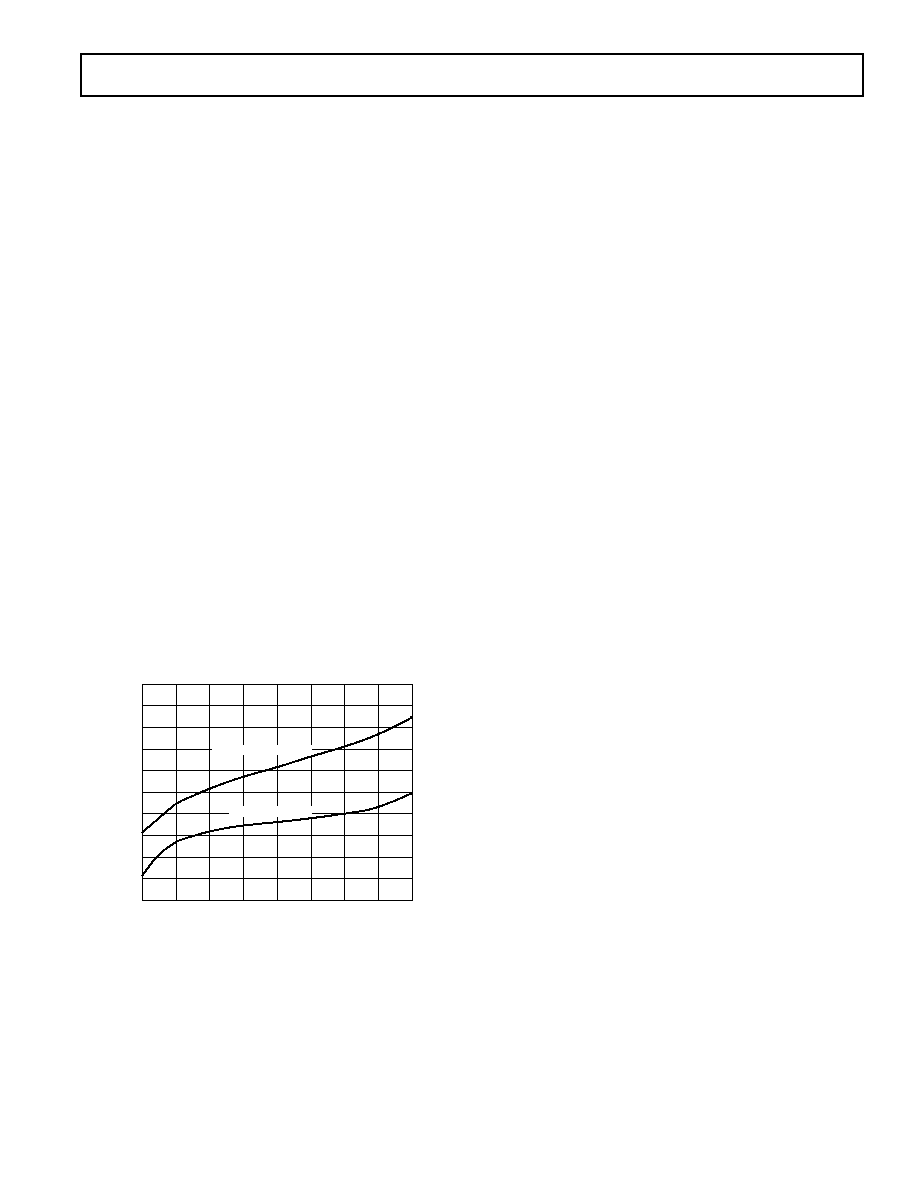
AD7715
21
REV. C
Measurement errors due to offset drift or gain drift can be elimi-
nated at any time by recalibrating the converter. Using the sys-
tem calibration mode can also minimize offset and gain errors in
the signal conditioning circuitry. Integral and differential linear-
ity errors are not significantly affected by temperature changes.
POWER SUPPLIES
There is no specific power sequence required for the AD7715;
either the AV
DD
or the DV
DD
supply can come up first. While
the latch-up performance of the AD7715 is good, it is important
that power is applied to the AD7715 before signals at REF IN,
AIN or the logic input pins in order to avoid excessive currents.
If this is not possible, then the current which flows in any of
these pins should be limited. If separate supplies are used for
the AD7715 and the system digital circuitry, then the AD7715
should be powered up first. If it is not possible to guarantee
this, then current limiting resistors should be placed in series
with the logic inputs to again limit the current.
During normal operation the AD7715 analog supply (AV
DD
)
should always be greater than or equal to its digital supply (DV
DD
).
Supply Current
The current consumption on the AD7715 is specified for sup-
plies in the range +3 V to +3.6 V and in the range +4.75 V to
+5.25 V. The part operates over a +2.85 V to +5.25 V supply
range and the I
DD
for the part varies as the supply voltage varies
over this range. Figure 5 shows the variation of the typical
I
DD
with V
DD
voltage for both a 1 MHz external clock and a
2.4576 MHz external clock at +25
°
C. The AD7715 is operated
in unbuffered mode. The relationship shows that the I
DD
is
minimized by operating the part with lower V
DD
voltages. I
DD
on the AD7715 is also minimized by using an external master
clock or by optimizing external components when using the on-
chip oscillator circuit.
SUPPLY VOLTAGE (AV
DD
& DV
DD
) Volts
0
2.85
0.9
1.0
0.8
0.7
0.6
0.5
0.4
0.3
0.2
0.1
3.15
3.45
4.05
4.35
4.65
4.95
5.25
3.75
MCLK IN = 2.4576MHz
MCLK IN = 1MHz
SUPPLY CURRENT (AV
DD
& D
V
DD
) mA
Figure 5. I
DD
vs. Supply Voltage
Grounding and Layout
Since the analog inputs and reference input are differential,
most of the voltages in the analog modulator are common-mode
voltages. The excellent common-mode rejection of the part will
remove common-mode noise on these inputs. The analog and
digital supplies to the AD7715 are independent and separately
pinned out to minimize coupling between the analog and digital
sections of the device. The digital filter will provide rejection of
broadband noise on the power supplies, except at integer mul-
tiples of the modulator sampling frequency. The digital filter
also removes noise from the analog and reference inputs pro-
vided those noise sources do not saturate the analog modulator.
As a result, the AD7715 is more immune to noise interference
that a conventional high resolution converter. However, because
the resolution of the AD7715 is so high and the noise levels
from the AD7715 so low, care must be taken with regard to
grounding and layout.
The printed circuit board which houses the AD7715 should be
designed such that the analog and digital sections are separated
and confined to certain areas of the board. This facilitates the
use of ground planes which can be separated easily. A minimum
etch technique is generally best for ground planes as it gives the
best shielding. Digital and analog ground planes should only be
joined in one place. If the AD7715 is the only device requiring
an AGND to DGND connection, then the ground planes
should be connected at the AGND and DGND pins of the
AD7715. If the AD7715 is in a system where multiple devices
require AGND to DGND connections, the connection should
still be made at one point only, a star ground point which
should be established as close as possible to the AD7715.
Avoid running digital lines under the device as these will couple
noise onto the die. The analog ground plane should be allowed
to run under the AD7715 to avoid noise coupling. The power
supply lines to the AD7715 should use as large a trace as pos-
sible to provide low impedance paths and reduce the effects of
glitches on the power supply line. Fast switching signals like
clocks should be shielded with digital ground to avoid radiating
noise to other sections of the board and clock signals should
never be run near the analog inputs. Avoid crossover of digital
and analog signals. Traces on opposite sides of the board should
run at right angles to each other. This will reduce the effects of
feedthrough through the board. A microstrip technique is by far
the best but is not always possible with a double-sided board. In
this technique, the component side of the board is dedicated to
ground planes while signals are placed on the solder side.
Good decoupling is important when using high resolution
ADCs. All analog supplies should be decoupled with 10
µ
F
tantalum in parallel with 0.1
µ
F capacitors to AGND. To
achieve the best from these decoupling components, they must
be placed as close as possible to the device, ideally right up
against the device. All logic chips should be decoupled with
0.1
µ
F disc ceramic capacitors to DGND. In systems where a
common supply voltage is used to drive both the AV
DD
and
DV
DD
of the AD7715, it is recommended that the system's
AV
DD
supply is used. This supply should have the recom-
mended analog supply decoupling capacitors between the AV
DD
pin of the AD7715 and AGND and the recommended digital
supply decoupling capacitor between the DV
DD
pin of the
AD7715 and DGND.
Evaluating the AD7715 Performance
The recommended layout for the AD7715 is outlined in the
evaluation board for the AD7715. The evaluation board pack-
age includes a fully assembled and tested evaluation board,
documentation, software for controlling the board over the
printer port of a PC and software for analyzing the AD7715's
performance on the PC. For the AD7715-5, the evaluation
board order number is EVAL-AD7715-5EB and for the
AD7715-3, the order number is EVAL-AD7715-3EB.
Noise levels in the signals applied to the AD7715 may also
affect performance of the part. The AD7715 software evaluation
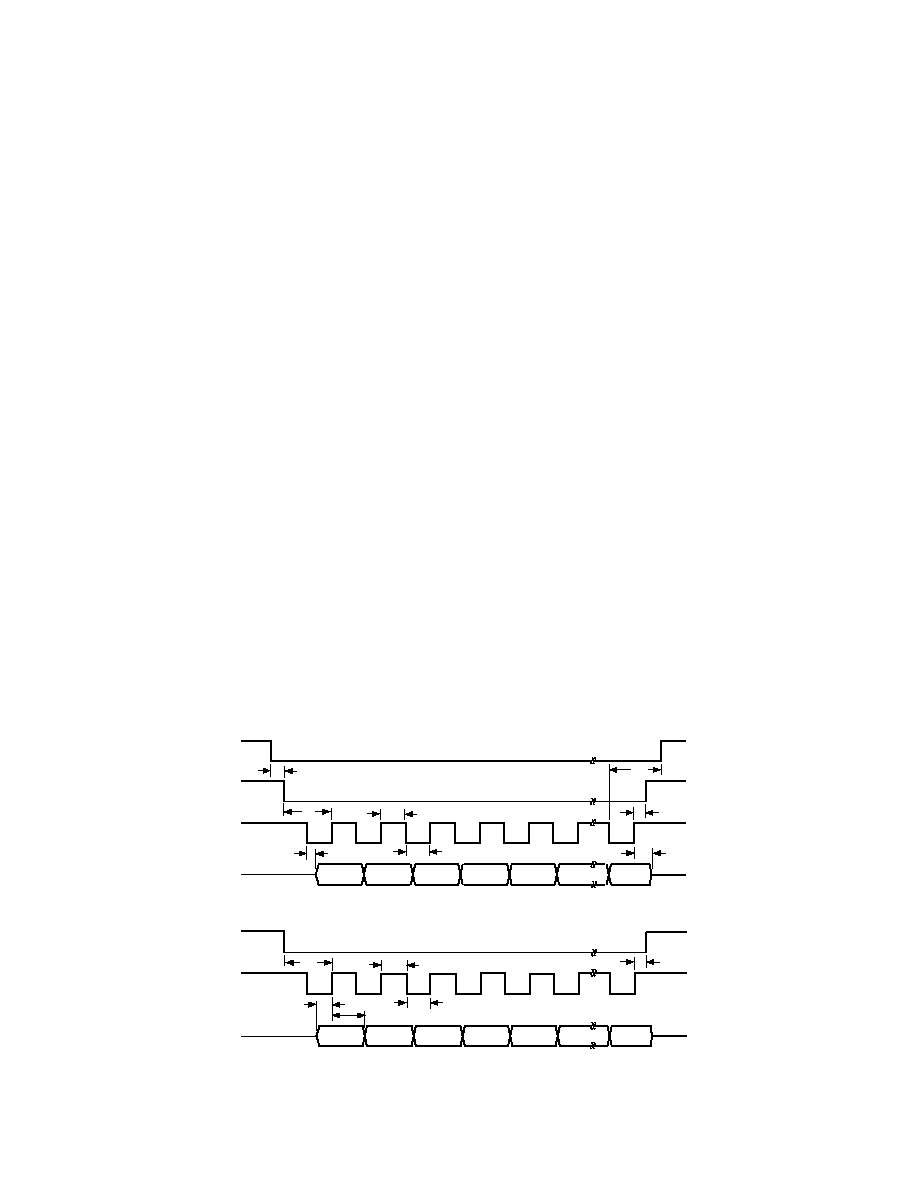
REV. C
AD7715
22
package allows the user to evaluate the true performance of the
part, independent of the analog input signal. The scheme
involves using a test mode on the part where the differential
inputs to the AD7715 are internally shorted together to provide
a zero differential voltage for the analog modulator. External to
the device, the AIN() input should be connected to a voltage
which is within the allowable common-mode range of the part.
This scheme should be used after a calibration has been per-
formed on the part.
DIGITAL INTERFACE
The AD7715's programmable functions are controlled using a
set of on-chip registers as outlined previously. Data is written to
these registers via the part's serial interface and read access to
the on-chip registers is also provided by this interface. All com-
munications to the part must start with a write operation to the
Communications Register. After power-on or RESET, the de-
vice expects a write to its Communications Register. The data
written to this register determines whether the next operation to
the part is a read or a write operation and also determines to
which register this read or write operation occurs. Therefore,
write access to any of the other registers on the part starts with a
write operation to the Communications Register followed by a
write to the selected register. A read operation from any other
register on the part (including the output data register) starts
with a write operation to the Communications Register followed
by a read operation from the selected register.
The AD7715's serial interface consists of five signals,
CS,
SCLK, DIN, DOUT and
DRDY. The DIN line is used for
transferring data into the on-chip registers while the DOUT line
is used for accessing data from the on-chip registers. SCLK is
the serial clock input for the device and all data transfers (either
on DIN or DOUT) take place with respect to this SCLK signal.
The
DRDY line is used as a status signal to indicate when data
is ready to be read from the AD7715's data register.
DRDY
goes low when a new data word is available in the output regis-
ter. It is reset high when a read operation from the data register
is complete. It also goes high prior to the updating of the output
register to indicate when not to read from the device to ensure
that a data read is not attempted while the register is being
updated.
CS is used to select the device. It can be used to de-
code the AD7715 in systems where a number of parts are con-
nected to the serial bus.
Figures 6 and 7 show timing diagrams for interfacing to the
AD7715 with
CS used to decode the part. Figure 6 is for a read
operation from the AD7715's output shift register, while Figure
7 shows a write operation to the input shift register. It is pos-
sible to read the same data twice from the output register even
though the
DRDY line returns high after the first read opera-
tion. Care must be taken, however, to ensure that the read
operations have been completed before the next output update
is about to take place.
The AD7715 serial interface can operate in three-wire mode by
tying the
CS input low. In this case, the SCLK, DIN and
DOUT lines are used to communicate with the AD7715 and
the status of
DRDY can be obtained by interrogating the MSB
of the Communications Register. This scheme is suitable for
interfacing to microcontrollers. If
CS is required as a decoding
signal, it can be generated from a port bit. For microcontroller
interfaces, it is recommended that the SCLK idles high between
data transfers.
The AD7715 can also be operated with
CS used as a frame
synchronization signal. This scheme is suitable for DSP inter-
faces. In this case, the first bit (MSB) is effectively clocked out
by
CS since CS would normally occur after the falling edge of
SCLK in DSPs. The SCLK can continue to run between data
transfers provided the timing numbers are obeyed.
The serial interface can be reset by exercising the
RESET input
on the part. It can also be reset by writing a series of 1s on the
DIN input. If a logic 1 is written to the AD7715 DIN line for at
least 32 serial clock cycles, the serial interface is reset. This
ensures that in three-wire systems that if the interface gets lost
DOUT
SCLK
CS
DRDY
MSB
t
5
t
7
t
9
LSB
t
8
t
6
t
3
t
10
t
4
Figure 6. Read Cycle Timing Diagram
DIN
SCLK
CS
MSB
t
12
t
15
LSB
t
16
t
14
t
13
t
11
Figure 7. Write Cycle Timing Diagram
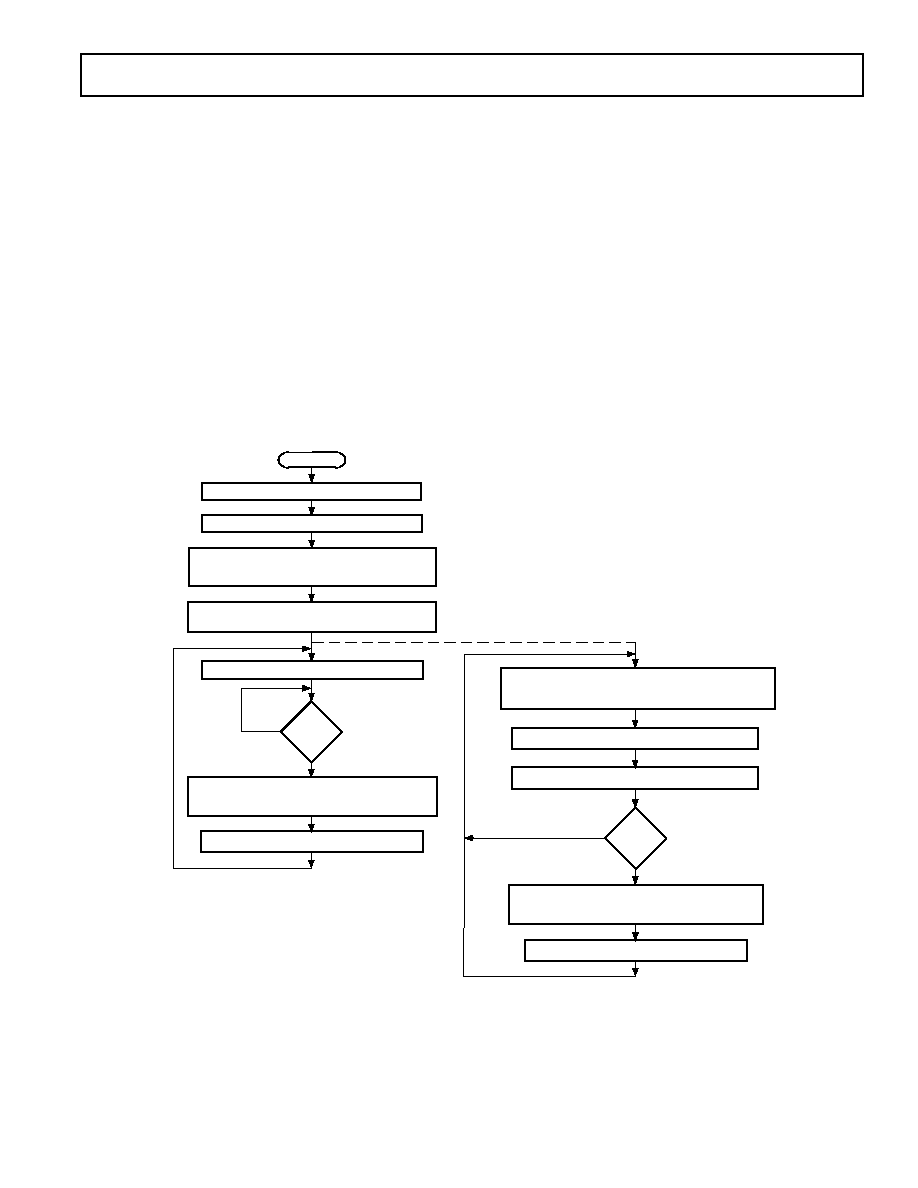
AD7715
23
REV. C
either via a software error or by some glitch in the system, it can
be reset back into a known state. This state returns the interface
to where the AD7715 is expecting a write operation to its Com-
munications Register. This operation in itself does not reset the
contents of any registers, but since the interface was lost, the
information which was written to any of the registers is un-
known and it is advisable to set up all registers again.
Some microprocessor or microcontroller serial interfaces have a
single serial data line. In this case, it is possible to connect the
AD7715's DATA OUT and DATA IN lines together and con-
nect then to the single data line of the processor. A 10 k
pull-
up resistor should be used on this single data line. In this case, if
the interface gets lost, because the read and write operations
share the same line the procedure to reset it back to a known
state is somewhat different than described previously. It requires
a read operation of 24 serial clocks followed by a write operation
where a logic 1 is written for at least 32 serial clock cycles to
ensure that the serial interface is back into a known state.
CONFIGURING THE AD7715
The AD7715 contains three on-chip registers which the user
accesses via the serial interface. Communication with any of
these registers is initiated by writing to the Communications
Register first. Figure 8 outlines a flow diagram of the sequence
which is used to configure all registers after a power-up or reset.
The flowchart also shows two different read options--the first
where the
DRDY pin is polled to determine when an update of
the data register has taken place, the second where the
DRDY
bit of the Communications Register is interrogated to see if a
data register update has taken place. Also included in the flow-
ing diagram is a series of words which should be written to the
registers for a particular set of operating conditions. These con-
ditions are gain of 1, no filter sync, bipolar mode, buffer off,
clock of 2.4576 MHz and an output rate of 60 Hz.
START
CONFIGURE & INITIALIZE C/ P SERIAL PORT
POWER-ON/RESET FOR AD7715
WRITE TO COMMUNICATIONS REGISTER SETTING UP
GAIN & SETTING UP NEXT OPERATION TO BE A WRITE
TO THE SETUP REGISTER (10 HEX)
WRITE TO SETUP REGISTER SETTING UP REQUIRED
VALUES & INITIATING A SELF CALIBRATION (68 HEX)
POLL
DRDY
PIN
DRDY
LOW?
YES
NO
WRITE TO COMMUNICATIONS REGISTER SETTING UP
SAME GAIN & SETTING UP NEXT OPERATION TO BE A
READ FROM THE DATA REGISTER (38 HEX)
READ FROM DATA REGISTER
POLL
DRDY
BIT OF COMMUNICATIONS REGISTER
YES
NO
WRITE TO COMMUNICATIONS REGISTER SETTING UP
SAME GAIN & SETTING UP NEXT OPERATION TO BE A
READ FROM THE DATA REGISTER (38 HEX)
WRITE TO COMMUNICATIONS REGISTER SETTING UP SAME
GAIN & SETTING UP NEXT OPERATION TO BE A READ FROM
THE COMMUNICATIONS REGISTER (08 HEX)
READ FROM COMMUNICATIONS REGISTER
DRDY
LOW?
READ FROM DATA REGISTER
Figure 8. Flowchart for Setting Up and Reading from the AD7715
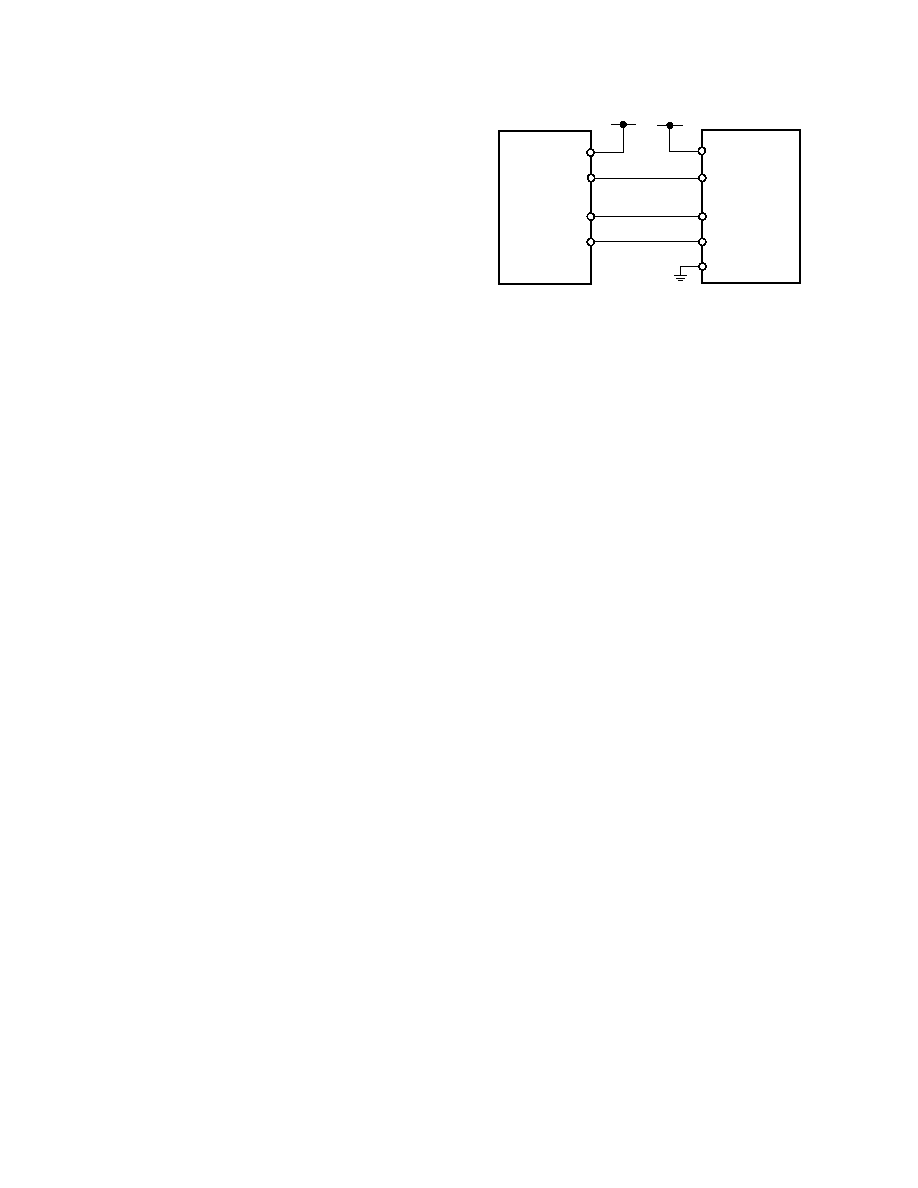
REV. C
AD7715
24
MICROCOMPUTER/MICROPROCESSOR INTERFACING
The AD7715's flexible serial interface allows for easy interface
to most microcomputers and microprocessors. The flowchart of
Figure 8 outlines the sequence which should be followed when
interfacing a microcontroller or microprocessor to the AD7715.
Figures 9, 10 and 11 show some typical interface circuits.
The serial interface on the AD7715 has the capability of operat-
ing from just three wires and is compatible with SPI interface
protocols. The three-wire operation makes the part ideal for
isolated systems where minimizing the number of interface lines
minimizes the number of opto-isolators required in the system.
The rise and fall times of the digital inputs to the AD7715
(especially the SCLK input) should be no longer than 1
µ
s.
Most of the registers on the AD7715 are 8-bit registers. This
facilitates easy interfacing to the 8-bit serial ports of microcon-
trollers. Some of the registers on the part are up to 16 bits, but
data transfers to these 16-bit registers can consist of a full 16-bit
transfer or two 8-bit transfers to the serial port of the microcon-
troller. DSP processors and microprocessors generally transfer
16 bits of data in a serial data operation. Some of these proces-
sors, such as the ADSP-2105, have the facility to program the
amount of cycles in a serial transfer. This allows the user to
tailor the number of bits in any transfer to match the register
length of the required register in the AD7715.
Even though some of the registers on the AD7715 are only eight
bits in length, communicating with two of these registers in
successive write operations can be handled as a single 16-bit
data transfer if required. For example, if the Setup Register is to
be updated, the processor must first write to the Communica-
tions Register (saying that the next operation is a write to the
Setup Register) and then write eight bits to the Setup Register.
This can all be done in a single 16-bit transfer if required be-
cause once the eight serial clocks of the write operation to the
Communications Register have been completed, the part imme-
diately sets itself up for a write operation to the Setup Register.
AD7715 to 68HC11 Interface
Figure 9 shows an interface between the AD7715 and the
68HC11 microcontroller. The diagram shows the minimum
(three-wire) interface with
CS on the AD7715 hardwired low.
In this scheme, the
DRDY bit of the Communications Register
is monitored to determine when the Data Register is updated.
An alternative scheme, which increases the number of interface
AD7715
DATA OUT
SCLK
CS
68HC11
SS
DV
DD
RESET
DATA IN
SCK
MISO
MOSI
DV
DD
Figure 9. AD7715 to 68HC11 Interface
lines to four, is to monitor the
DRDY output line from the
AD7715. The monitoring of the
DRDY line can be done in two
ways. First,
DRDY can be connected to one of the 68HC11's
port bits (such as PC0) which is configured as an input. This
port bit is then polled to determine the status of
DRDY. The
second scheme is to use an interrupt driven system, in which
case the
DRDY output is connected to the IRQ input of the
68HC11. For interfaces that require control of the
CS input on
the AD7715, one of the port bits of the 68HC11 (such as PC1),
which is configured as an output, can be used to drive the
CS
input.
The 68HC11 is configured in the master mode with its CPOL
bit set to a logic one and its CPHA bit set to a logic one. When
the 68HC11 is configured like this, its SCLK line idles high
between data transfers. The AD7715 is not capable of full du-
plex operation. If the AD7715 is configured for a write opera-
tion, no data appears on the DATA OUT lines even when the
SCLK input is active. Similarly, if the AD7715 is configured for
a read operation, data presented to the part on the DATA IN
line is ignored even when SCLK is active.
Coding for an interface between the 68HC11 and the AD7715
is given in Table XVI. In this example, the
DRDY output line
of the AD7715 is connected to the PC0 port bit of the 68HC11
and is polled to determine its status.
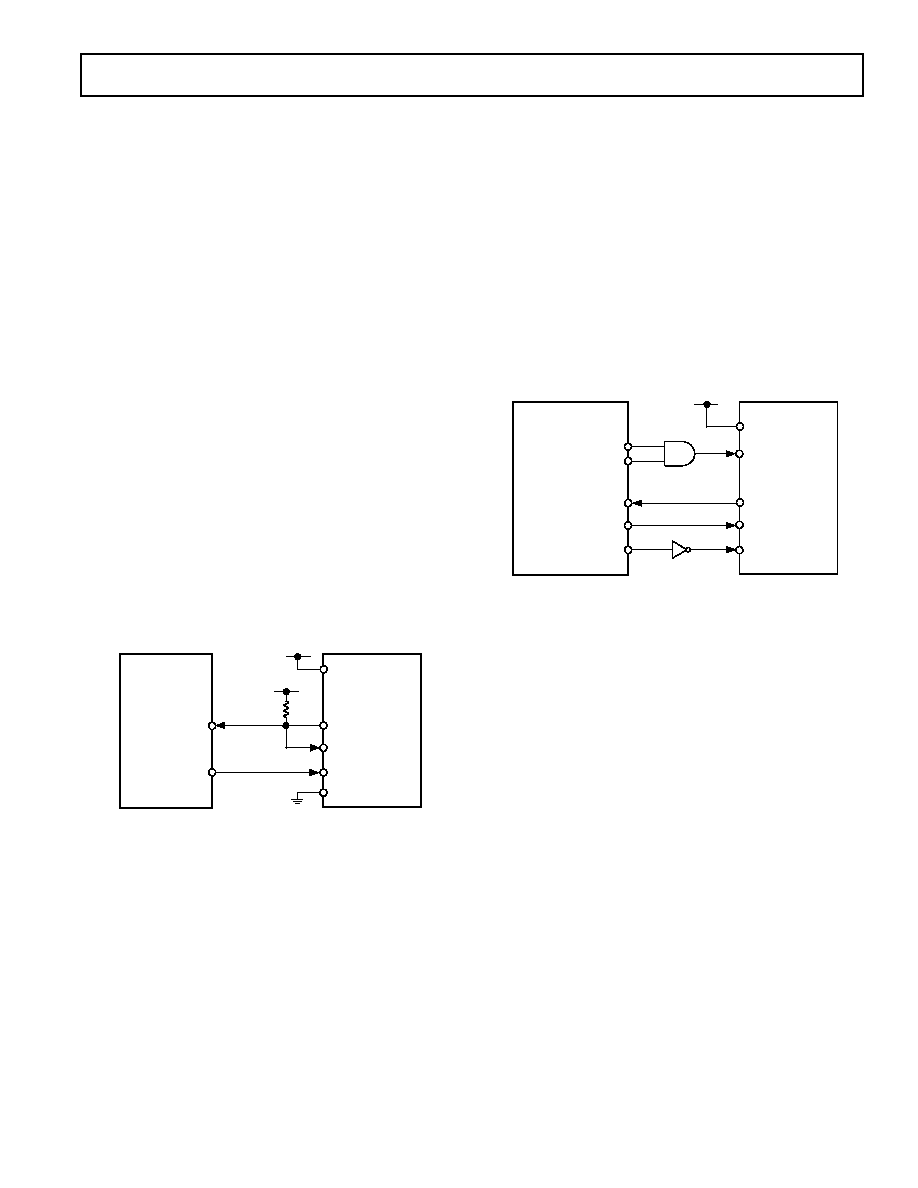
AD7715
25
REV. C
AD7715 to 8XC51 Interface
An interface circuit between the AD7715 and the 8XC51
microcontroller is shown in Figure 10. The diagram shows the
minimum number of interface connections with
CS on the
AD7715 hardwired low. In the case of the 8XC51 interface, the
minimum number of interconnects is just two. In this scheme,
the
DRDY bit of the Communications Register is monitored to
determine when the Data Register is updated. The alternative
scheme, which increases the number of interface lines to three,
is to monitor the
DRDY output line from the AD7715. The
monitoring of the
DRDY line can be done in two ways. First,
DRDY can be connected to one of the 8XC51's port bits (such
as P1.0) which is configured as an input. This port bit is then
polled to determine the status of
DRDY. The second scheme is
to use an interrupt driven system in which case, the
DRDY
output is connected to the
INT1 input of the 8XC51. For inter-
faces that require control of the
CS input on the AD7715, one
of the port bits of the 8XC51 (such as P1.1), which is config-
ured as an output, can be used to drive the
CS input.
The 8XC51 is configured in its Mode 0 serial interface mode.
Its serial interface contains a single data line. As a result, the
DATA OUT and DATA IN pins of the AD7715 should be
connected together with a 10 k
pull-up resistor. The serial
clock on the 8XC51 idles high between data transfers. The
8XC51 outputs the LSB first in a write operation while the
AD7715 rearranged before being written to the output serial
register. Similarly, the AD7715 outputs the MSB first during a
read operation while the 8XC51 expects the LSB first. There-
fore, the data which is read into the serial buffer needs to be
rearranged before the correct data word from the AD7715 is
available in the accumulator.
AD7715
DATA OUT
CS
8XC51
RESET
DATA IN
SCLK
P3.0
P3.1
DV
DD
DV
DD
10k
Figure 10. AD7715 to 8XC51 Interface
AD7715 to ADSP-2103/ADSP-2105 Interface
Figure 11 shows an interface between the AD7715 and the
ADSP-2103/ADSP-2105 DSP processor. In the interface
shown, the
DRDY bit of the Communications Register is again
monitored to determine when the Data Register is updated. The
alternative scheme is to use an interrupt driven system, in which
case the
DRDY output is connected to the IRQ2 input of the
ADSP-2103/ADSP-2105. The serial interface of the ADSP-
2103/ADSP-2105 is set up for alternate framing mode. The
RFS and TFS pins of the ADSP-2103/ADSP-2105 are config-
ured as active low outputs, and the ADSP-2103/ADSP-2105
serial clock line, SCLK, is also configured as an output. The
CS
for the AD7715 is active when either the
RFS or TFS outputs
from the ADSP-2103/ADSP-2105 are active. The serial clock
rate on the ADSP-2103/ADSP-2105 should be limited to
3 MHz to ensure correct operation with the AD7715.
AD7715
DATA OUT
CS
ADSP-2103/2105
RESET
DATA IN
SCLK
RFS
DR
DT
DV
DD
TFS
SCLK
Figure 11. AD7715 to ADSP-2103/ADSP-2105 Interface
CODE FOR SETTING UP THE AD7715
Table XVI gives a set of read and write routines in C code for
interfacing the 68HC11 microcontroller to the AD7715. The
sample program sets up the various registers on the AD7715
and reads 1000 samples from the part into the 68HC11. The
setup conditions on the part are exactly the same as those out-
lined for the flowchart of Figure 8. In the example code given
here, the
DRDY output is polled to determine if a new valid
word is available in the data register.
The sequence of the events in this program are as follows:
1. Write to the Communications Register, setting the gain to 1
with standby inactive.
2. Write to the Setup Register, setting bipolar mode, buffer off,
no filter synchronization, confirming a clock frequency of
2.4576 MHz, setting the output rate for 60 Hz and initiating
a self-calibration.
3. Poll the
DRDY Output.
4. Read the data from the Data Register.
5. Loop around doing Steps 3 and 4 until the specified number
of samples have been taken.

REV. C
AD7715
26
Table XVI. C Code for Interfacing AD7715 to 68HC11
/* This program has read and write routines for the 68HC11 to interface to the AD7715 and the sample
program sets the various registers and then reads 1000 samples from the part. */
#include <math.h>
#include <io6811.h>
#define NUM_SAMPLES 1000 /* change the number of data samples */
#define MAX_REG_LENGTH 2 /* this says that the max length of a register is 2 bytes */
Writetoreg (int);
Read (int,char);
char *datapointer = store;
char store[NUM_SAMPLES*MAX_REG_LENGTH + 30];
void main()
{
/* the only pin that is programmed here from the 68HC11 is the /CS and this is why the PC2 bit
of PORTC is made as an output */
char a;
DDRC = 0x04; /* PC2 is an output the rest of the port bits are inputs */
PORTC | = 0x04; /* make the /CS line high */
Writetoreg(0x10); /* set the gain to 1, standby off and set the next operation as write to the setup
register */
Writetoreg(0x68); /* set bipolar mode, buffer off, no filter sync, confirm clock as 2.4576MHz, set
output rate to 60Hz and do a self calibration */
while(PORTC & 0x10); /* wait for /DRDY to go low */
for(a=0;a<NUM_SAMPLES;a++);
{
Writetoreg(0x38); /*set the next operation for 16 bit read from the data register */
Read(NUM_SAMPLES,2);
}
}
Writetoreg(int byteword);
{
int q;
SPCR = 0x3f;
SPCR = 0X7f; /* this sets the WiredOR mode(DWOM=1), Master mode(MSTR=1), SCK idles high(CPOL=1), /SS
can be low always (CPHA=1), lowest clock speed(slowest speed which is master clock /32 */
DDRD = 0x18; /* SCK, MOSI outputs */
q = SPSR;
q = SPDR; /* the read of the staus register and of the data register is needed to clear the interrupt
which tells the user that the data transfer is complete */
PORTC &= 0xfb; /* /CS is low */
SPDR = byteword; /* put the byte into data register */
while(!(SPSR & 0x80)); /* wait for /DRDY to go low */
PORTC |= 0x4; /* /CS high */
}
Read(int amount, int reglength)
{
int q;
SPCR = 0x3f;
SPCR = 0x7f; /* clear the interrupt */
DDRD = 0x10; /* MOSI output, MISO input, SCK output */
while(PORTC & 0x10); /* wait for /DRDY to go low */
PORTC & 0xfb ; /* /CS is low */
for(b=0;b<reglength;b++)
{
SPDR = 0;
while(!(SPSR & 0x80)); /* wait until port ready before reading */
*datapointer++=SPDR; /* read SPDR into store array via datapointer */
}
PORTC|=4; /* /CS is high */
}
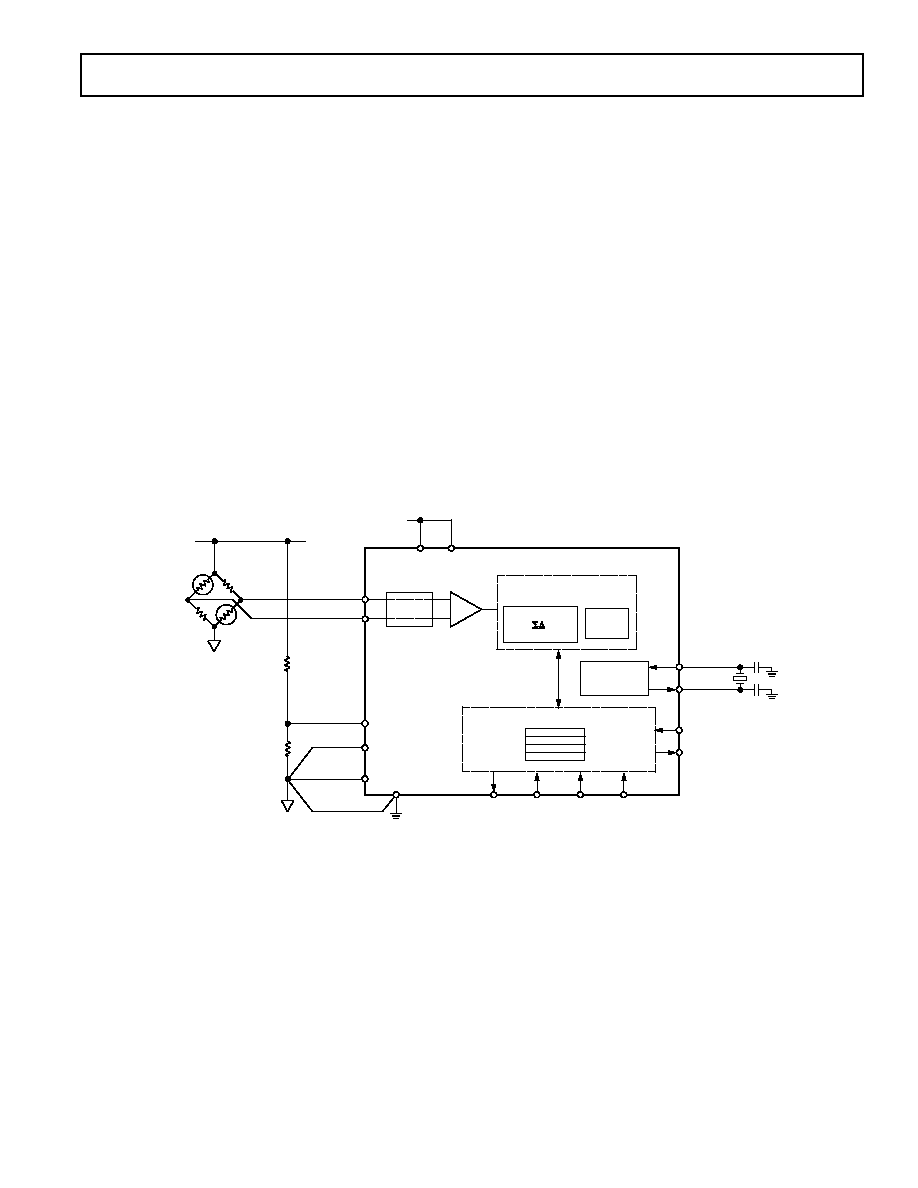
AD7715
27
REV. C
+20 mV to 0 V to +2.5 V and bipolar inputs of
±
20 mV to
±
2.5 V. Because the part operates from a single supply, these
bipolar ranges are with respect to a biased-up differential input.
Pressure Measurement
One typical application of the AD7715 is pressure measurement.
Figure 12 shows the AD7715 used with a pressure transducer,
the BP01 from Sensym. The pressure transducer is arranged in a
bridge network and gives a differential output voltage between
its OUT(+) and OUT() terminals. With rated full-scale pres-
sure (in this case 300 mmHg) on the transducer, the differential
output voltage is 3 mV/V of the input voltage (i.e., the voltage
between its IN(+) and IN() terminals).
Assuming a 5 V excitation voltage, the full-scale output range
from the transducer is 15 mV. The excitation voltage for the
bridge is also used to generate the reference voltage for the
AD7715. Therefore, variations in the excitation voltage do not
introduce errors in the system. Choosing resistor values of 24 k
and 15 k
as per the diagram give a 1.92 V reference voltage for
the AD7715 when the excitation voltage is 5 V.
Using the part with a programmed gain of 128 results in the full-
scale input span of the AD7715 being 15 mV which corresponds
with the output span from the transducer.
APPLICATIONS
The AD7715 provides a low cost, high resolution analog-to-
digital function. Because the analog-to-digital function is pro-
vided by a sigma-delta architecture, it makes the part more
immune to noisy environments thus making the part ideal for
use in industrial and process control applications. It also
provides a programmable gain amplifier, a digital filter and
calibration options. Thus, it provides far more system level
functionality than off-the-shelf integrating ADCs without the
disadvantage of having to supply a high quality integrating ca-
pacitor. In addition, using the AD7715 in a system allows the
system designer to achieve a much higher level of resolution
because noise performance of the AD7715 is significantly better
than that of the integrating ADCs.
The on-chip PGA allows the AD7715 to handle an analog input
voltage range as low as 10 mV full-scale with V
REF
= +1.25 V.
The differential inputs of the part allow this analog input range
to have an absolute value anywhere between AGND and AV
DD
when the part is operated in unbuffered mode. It allows the user
to connect the transducer directly to the input of the AD7715.
The programmable gain front end on the AD7715 allows the
part to handle unipolar analog input ranges from 0 mV to
IN
OUT+
IN+
OUT
AUTO-ZEROED
MODULATOR
CHARGE BALANCING A/D
CONVERTER
DIGITAL
FILTER
AV
DD
SERIAL INTERFACE
REGISTER BANK
MCLK IN
MCLK OUT
REF IN (+)
REF IN ()
AGND
DGND
DOUT
DIN
CS
SCLK
DRDY
RESET
24k
15k
DV
DD
AD7715
+5V
EXCITATION VOLTAGE = +5V
AIN(+)
AIN()
A = 1128
PGA
BUFFER
CLOCK
GENERATION
Figure 12. Pressure Measurement Using the AD7715
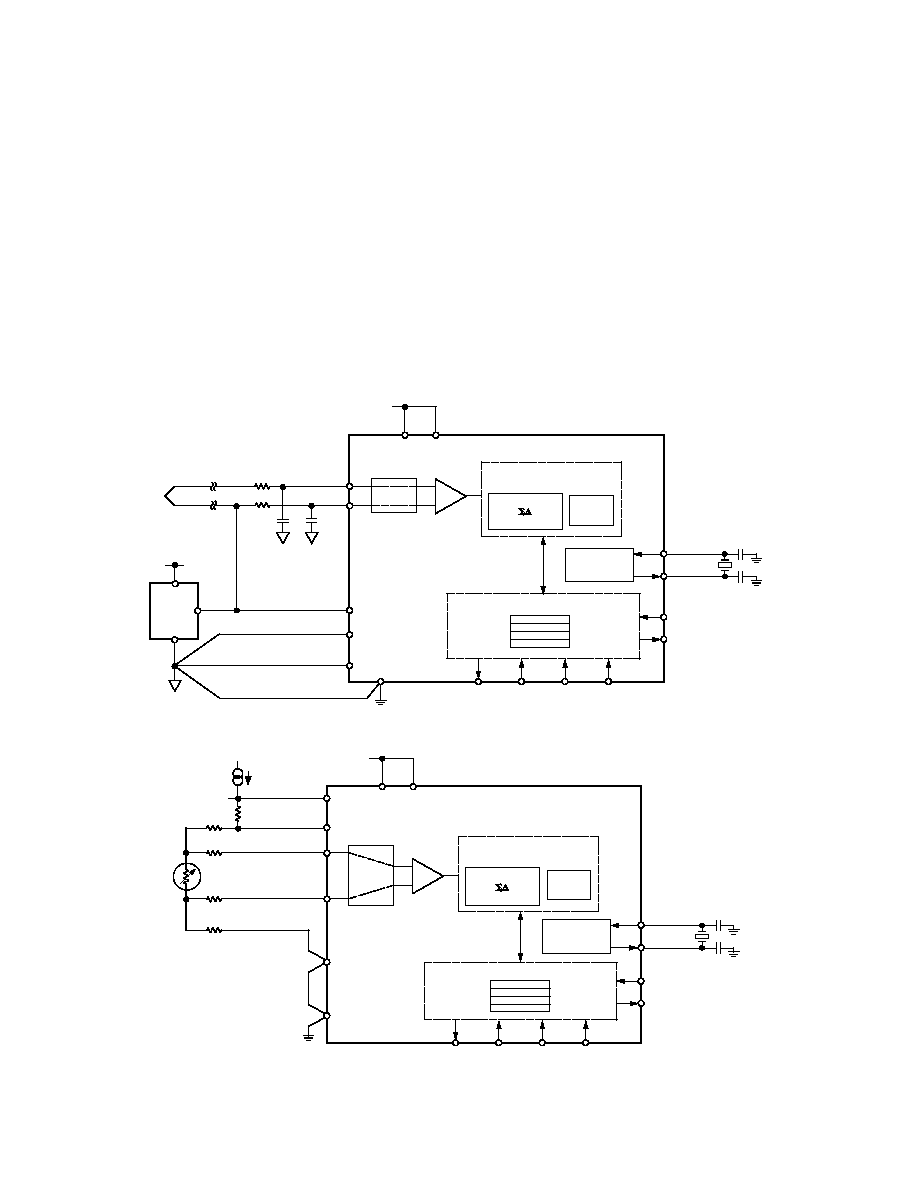
REV. C
AD7715
28
Temperature Measurement
Another application area for the AD7715 is in temperature
measurement. Figure 13 outlines a connection from a thermo-
couple to the AD7715. In this application, the AD7715 is oper-
ated in its buffered mode to allow large decoupling capacitors
on the front end to eliminate any noise pickup which there may
have been in the thermocouple leads. When the AD7715 is
operated in buffered mode, it has a reduced common-mode
range. In order to place the differential voltage from the thermo-
couple on a suitable common-mode voltage, the AIN() input of
the AD7715 is biased up at the reference voltage, +2.5 V.
Figure 14 shows another temperature measurement application
for the AD7715. In this case, the transducer is an RTD (Resis-
tive Temperature Device), a PT100. The arrangement is a 4-
lead RTD configuration. There are voltage drops across the lead
resistances R
L1
and R
L4
, but these simply shift the common-
mode voltage. There is no voltage drop across lead resistances
R
L2
and R
L3
as the input current to the AD7715 is very low
.
The
lead resistances present a small source impedance so it would
not generally be necessary to turn on the buffer on the AD7715.
If the buffer is required, the common-mode voltage should be
set accordingly by inserting a small resistance between the bot-
tom end of the RTD and AGND of the AD7715. In the appli-
cation shown an external 400
µ
A current source provides the
excitation current for the PT100 and it also generates the refer-
ence voltage for the AD7715 via the 6.25 k
resistor. Variations
in the excitation current do not affect the circuit as both the
input voltage and the reference voltage vary ratiometrically with
the excitation current. However, the 6.25 k
resistor must have
a low temperature coefficient to avoid errors in the reference
voltage over temperature.
AUTO-ZEROED
MODULATOR
CHARGE BALANCING A/D
CONVERTER
DIGITAL
FILTER
AV
DD
SERIAL INTERFACE
REGISTER BANK
MCLK IN
MCLK OUT
REF IN (+)
REF IN ()
AGND
DGND
DOUT
DIN
CS
SCLK
DRDY
RESET
DV
DD
AD7715
+5V
AIN (+)
AIN ()
A = 1128
PGA
BUFFER
CLOCK
GENERATION
GND
C
C
V
OUT
REF192
THERMOCOUPLE
JUNCTION
+5V
+V
IN
R
R
Figure 13. Thermocouple Measurement Using the AD7715
400 A
R
L4
R
L3
R
L2
R
L1
RTD
6.25k
AUTO-ZEROED
MODULATOR
CHARGE BALANCING A/D
CONVERTER
DIGITAL
FILTER
AV
DD
SERIAL INTERFACE
REGISTER BANK
MCLK IN
MCLK OUT
REF IN (+)
REF IN ()
AGND
DGND
DOUT
DIN
CS
SCLK
DRDY
RESET
DV
DD
AD7715
+5V
AIN(+)
AIN()
A = 1128
PGA
BUFFER
CLOCK
GENERATION
Figure 14. RTD Measurement Using the AD7715
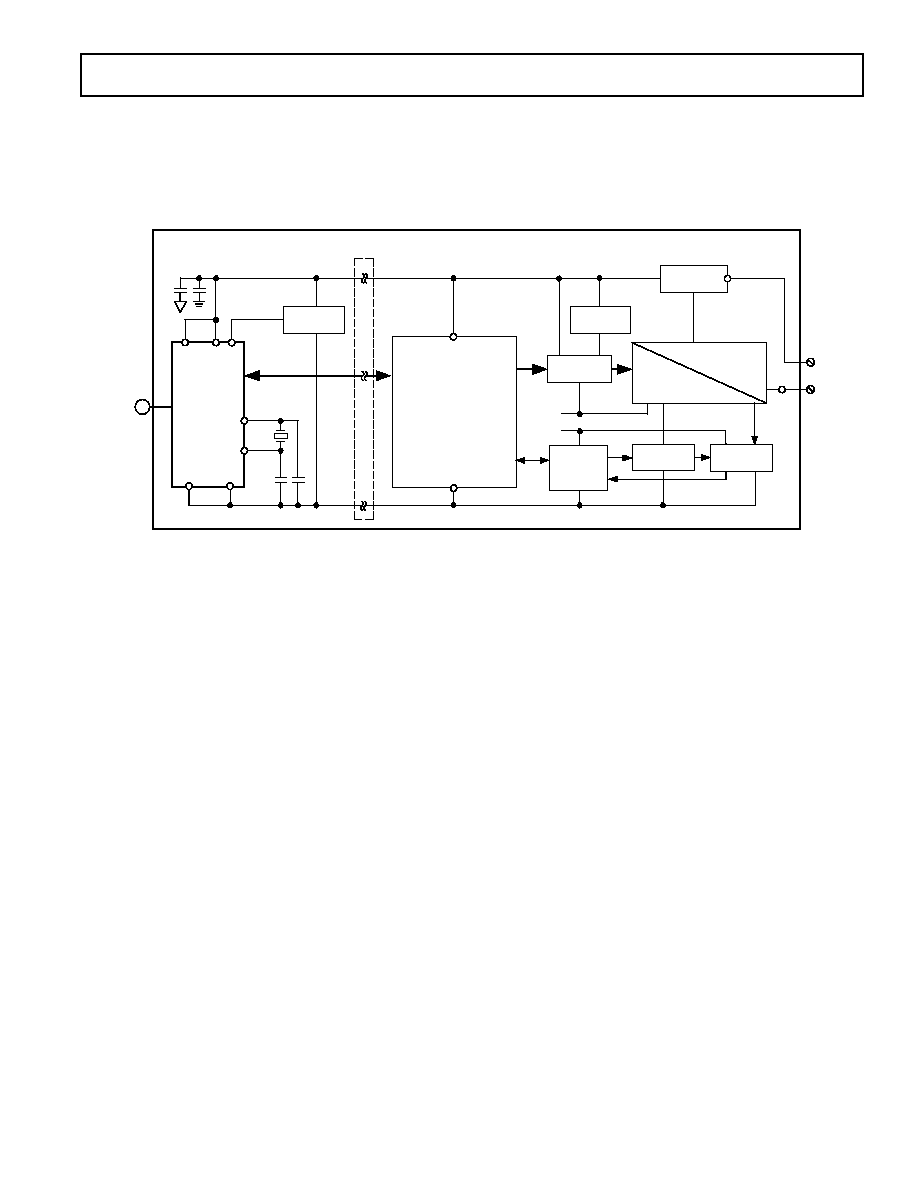
AD7715
29
REV. C
Smart Transmitters
Another area where the low power, single supply, three-wire
interface capabilities is of benefit is in smart transmitters. Here,
the entire smart transmitter must operate from the 4 mA to
20 mA loop. Tolerances in the loop mean that the amount of
current available to power the transmitter is as low as 3.5 mA.
The AD7715 consumes only 450
µ
A, leaving 3 mA available for
the rest of the transmitter. Figure 15 shows a block diagram of a
smart transmitter which includes the AD7715. Not shown in
Figure 15 is the isolated power source required to power the
front end.
INPUT/OUTPUT
STAGE
SIGNAL
CONDITIONER
MICROCONTROLLER UNIT
*PID
*RANGE SETTING
*CALIBRATION
*LINEARIZATION
*OUTPUT CONTROL
*SERIAL COMMUNICATION
*HART PROTOCOL
VOLTAGE
REFERENCE
MCLK
OUT
AD7715
ISOLATED SUPPLY
ISOLATION
BARRIER
SENSORS
RTD
mV
ohm
TC
LOOP
RTN
MCLK
IN
COM
3V
420mA
DV
DD
AV
DD
REF IN
AGND
DGND
ISOLATED GROUND
COM
V
CC
3V
MAIN TRANSMITTER ASSEMBLY
BANDPASS
FILTER
WAVEFORM
SHAPER
HART
MODEM
BELL 202
D/A
CONVERTER
VOLTAGE
REFERENCE
VOLTAGE
REGULATOR
Figure 15. Smart Transmitter Using the AD7715

REV. C
AD7715
30
PAGE INDEX
Topic
Page
FEATURES . . . . . . . . . . . . . . . . . . . . . . . . . . . . . . . . . . . . . 1
GENERAL DESCRIPTION . . . . . . . . . . . . . . . . . . . . . . . . . 1
PRODUCT HIGHLIGHTS . . . . . . . . . . . . . . . . . . . . . . . . . 1
AD7715-5 SPECIFICATIONS . . . . . . . . . . . . . . . . . . . . . . . 2
AD7715-3 SPECIFICATIONS . . . . . . . . . . . . . . . . . . . . . . . 3
SPECIFICATIONS . . . . . . . . . . . . . . . . . . . . . . . . . . . . . . . 4
TIMING CHARACTERISTICS . . . . . . . . . . . . . . . . . . . . . 5
ABSOLUTE MAXIMUM RATINGS . . . . . . . . . . . . . . . . . 6
ORDERING GUIDE . . . . . . . . . . . . . . . . . . . . . . . . . . . . . . 6
PIN CONFIGURATION . . . . . . . . . . . . . . . . . . . . . . . . . . . 6
PIN FUNCTION DESCRIPTION . . . . . . . . . . . . . . . . . . . 7
TERMINOLOGY . . . . . . . . . . . . . . . . . . . . . . . . . . . . . . . . . 8
ON-CHIP REGISTERS . . . . . . . . . . . . . . . . . . . . . . . . . . . . 8
Communications Register . . . . . . . . . . . . . . . . . . . . . . . . . 9
Setup Register . . . . . . . . . . . . . . . . . . . . . . . . . . . . . . . . . 10
Test Register . . . . . . . . . . . . . . . . . . . . . . . . . . . . . . . . . . 11
Data Register . . . . . . . . . . . . . . . . . . . . . . . . . . . . . . . . . . 11
OUTPUT NOISE . . . . . . . . . . . . . . . . . . . . . . . . . . . . . . . . 11
AD7715-5 . . . . . . . . . . . . . . . . . . . . . . . . . . . . . . . . . . . . 12
AD7715-3 . . . . . . . . . . . . . . . . . . . . . . . . . . . . . . . . . . . . 13
CALIBRATION SEQUENCES . . . . . . . . . . . . . . . . . . . . . 14
CIRCUIT DESCRIPTION . . . . . . . . . . . . . . . . . . . . . . . . 14
ANALOG INPUT . . . . . . . . . . . . . . . . . . . . . . . . . . . . . . . . 15
Analog Input Ranges . . . . . . . . . . . . . . . . . . . . . . . . . . . . 15
Input Sample Rate . . . . . . . . . . . . . . . . . . . . . . . . . . . . . . 15
Bipolar/Unipolar Inputs . . . . . . . . . . . . . . . . . . . . . . . . . . 15
REFERENCE INPUT . . . . . . . . . . . . . . . . . . . . . . . . . . . . 16
DIGITAL FILTERING . . . . . . . . . . . . . . . . . . . . . . . . . . . 16
Filter Characteristics . . . . . . . . . . . . . . . . . . . . . . . . . . . . 16
Post-Filtering . . . . . . . . . . . . . . . . . . . . . . . . . . . . . . . . . . 17
ANALOG FILTERING . . . . . . . . . . . . . . . . . . . . . . . . . . . 17
CALIBRATION . . . . . . . . . . . . . . . . . . . . . . . . . . . . . . . . . 17
Self-Calibration . . . . . . . . . . . . . . . . . . . . . . . . . . . . . . . . 18
System Calibration . . . . . . . . . . . . . . . . . . . . . . . . . . . . . . 18
Span and Offset Limits . . . . . . . . . . . . . . . . . . . . . . . . . . 18
Power-Up and Calibration . . . . . . . . . . . . . . . . . . . . . . . . 19
USING THE AD7715 . . . . . . . . . . . . . . . . . . . . . . . . . . . . 19
Clocking and Oscillator Circuit . . . . . . . . . . . . . . . . . . . . 19
System Synchronization . . . . . . . . . . . . . . . . . . . . . . . . . . 20
Reset Input . . . . . . . . . . . . . . . . . . . . . . . . . . . . . . . . . . . 20
Standby Mode . . . . . . . . . . . . . . . . . . . . . . . . . . . . . . . . . 20
Accuracy . . . . . . . . . . . . . . . . . . . . . . . . . . . . . . . . . . . . . 20
Drift Considerations . . . . . . . . . . . . . . . . . . . . . . . . . . . . 20
POWER SUPPLIES . . . . . . . . . . . . . . . . . . . . . . . . . . . . . . 21
Supply Current . . . . . . . . . . . . . . . . . . . . . . . . . . . . . . . . 21
Grounding and Layout . . . . . . . . . . . . . . . . . . . . . . . . . . . 21
Evaluating the AD7715 Performance . . . . . . . . . . . . . . . . 21
DIGITAL INTERFACE . . . . . . . . . . . . . . . . . . . . . . . . . . . 22
CONFIGURING THE AD7715 . . . . . . . . . . . . . . . . . . . . . 23
MICROCOMPUTER/MICROPROCESSOR
INTERFACING . . . . . . . . . . . . . . . . . . . . . . . . . . . . . . . 24
AD7715 to 68HC11 Interface . . . . . . . . . . . . . . . . . . . . . 24
AD7715 to 8XC51 Interface . . . . . . . . . . . . . . . . . . . . . . 25
AD7715 to ADSP-2103/ADSP-2105 Interface . . . . . . . . 25
Topic
Page
CODE FOR SETTING UP AD7715 . . . . . . . . . . . . . . . . . 25
APPLICATIONS . . . . . . . . . . . . . . . . . . . . . . . . . . . . . . . . 27
Pressure Measurement . . . . . . . . . . . . . . . . . . . . . . . . . . . 27
Temperature Measurement . . . . . . . . . . . . . . . . . . . . . . . 28
Smart Transmitters . . . . . . . . . . . . . . . . . . . . . . . . . . . . . 29
INDEX . . . . . . . . . . . . . . . . . . . . . . . . . . . . . . . . . . . . . . . . 30
OUTLINE DIMENSIONS . . . . . . . . . . . . . . . . . . . . . . . . . 31
TABLE INDEX
Table
Title
Table I
Communications Register . . . . . . . . . . . . . . . . . . 9
Table II
Register Selection . . . . . . . . . . . . . . . . . . . . . . . . 9
Table III
Setup Register . . . . . . . . . . . . . . . . . . . . . . . . . . 10
Table IV
Output Update Rates . . . . . . . . . . . . . . . . . . . . 11
Table V
Output RMS Noise vs. Gain and Output Update
Rate for AD7715-5 (Unbuffered Mode) . . . . . . 12
Table VI
Peak-to-Peak Resolution vs. Gain and Output
Update Rate for AD7715-5 (Unbuffered Mode) . . 12
Table VII Output RMS Noise vs. Gain and Output Update
Rate for AD7715-5 (Buffered Mode) . . . . . . . . . 12
Table VIII Peak-to-Peak Resolution vs. Gain and Output
Update Rate for AD7715-5 (Buffered Mode) . . 12
Table IX
Output RMS Noise vs. Gain and Output Update
Rate for AD7715-3 (Unbuffered Mode) . . . . . . 13
Table X
Peak-to-Peak Resolution vs. Gain and Output
Update Rate for AD7715-3 (Unbuffered Mode) . . 13
Table XI
Output RMS Noise vs. Gain and Output Update
Rate for AD7715-5 (Buffered Mode) . . . . . . . . 13
Table XII Peak-to-Peak Resolution vs. Gain and Output
Update Rate for AD7715-3 (Buffered Mode) . . 13
Table XIII Calibration Sequences . . . . . . . . . . . . . . . . . . . . 14
Table XIV External R, C Combination for No 16-Bit
Gain Error . . . . . . . . . . . . . . . . . . . . . . . . . . . . . 15
Table XV Input Sampling Frequency vs. Gain . . . . . . . . . 15
Table XVI C Code for Interfacing AD7715 to 68HC11 . . . 26
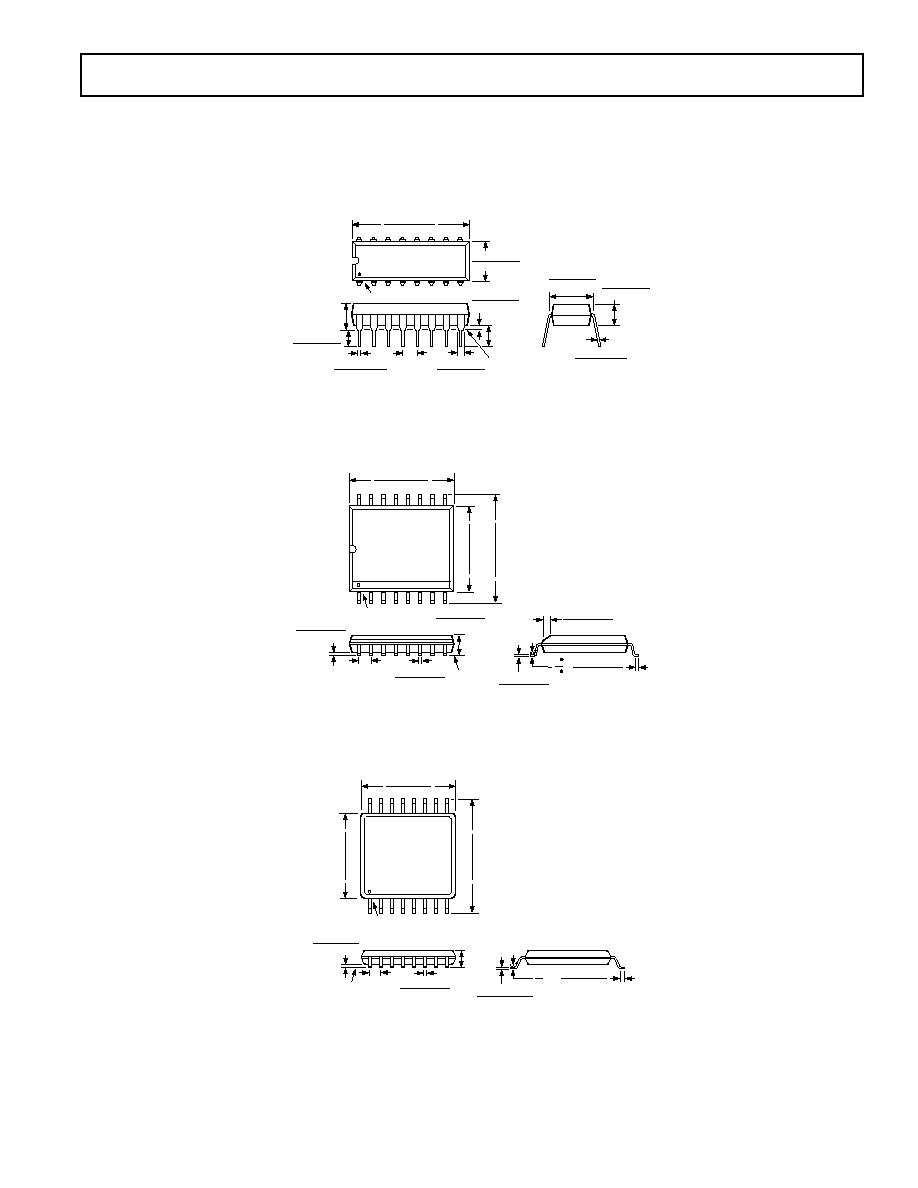
AD7715
31
REV. C
OUTLINE DIMENSIONS
Dimensions shown in inches and (mm).
16-Lead Plastic DIP
(N-16)
16
1
8
9
0.840 (21.33)
0.745 (18.93)
0.280 (7.11)
0.240 (6.10)
PIN 1
SEATING
PLANE
0.022 (0.558)
0.014 (0.356)
0.060 (1.52)
0.015 (0.38)
0.210 (5.33)
MAX
0.130
(3.30)
MIN
0.070 (1.77)
0.045 (1.15)
0.100
(2.54)
BSC
0.160 (4.06)
0.115 (2.93)
0.325 (8.25)
0.300 (7.62)
0.015 (0.381)
0.008 (0.204)
0.195 (4.95)
0.115 (2.93)
16-Lead SOIC
(R-16)
16
9
8
1
0.4133 (10.50)
0.3977 (10.00)
0.4193 (10.65)
0.3937 (10.00)
0.2992 (7.60)
0.2914 (7.40)
PIN 1
SEATING
PLANE
0.0118 (0.30)
0.0040 (0.10)
0.0192 (0.49)
0.0138 (0.35)
0.1043 (2.65)
0.0926 (2.35)
0.0500
(1.27)
BSC
0.0125 (0.32)
0.0091 (0.23)
0.0500 (1.27)
0.0157 (0.40)
8
0
0.0291 (0.74)
0.0098 (0.25)
45°
16-Lead TSSOP
(RU-16)
16
9
8
1
0.201 (5.10)
0.193 (4.90)
0.256 (6.50)
0.246 (6.25)
0.177 (4.50)
0.169 (4.30)
PIN 1
SEATING
PLANE
0.006 (0.15)
0.002 (0.05)
0.0118 (0.30)
0.0075 (0.19)
0.0256
(0.65)
BSC
0.0433
(1.10)
MAX
0.0079 (0.20)
0.0035 (0.090)
0.028 (0.70)
0.020 (0.50)
8°
0°
C2016b2.52/00 (rev. C)
PRINTED IN U.S.A.






























